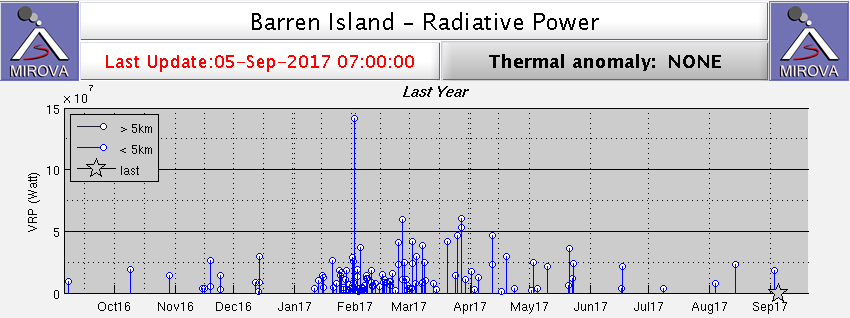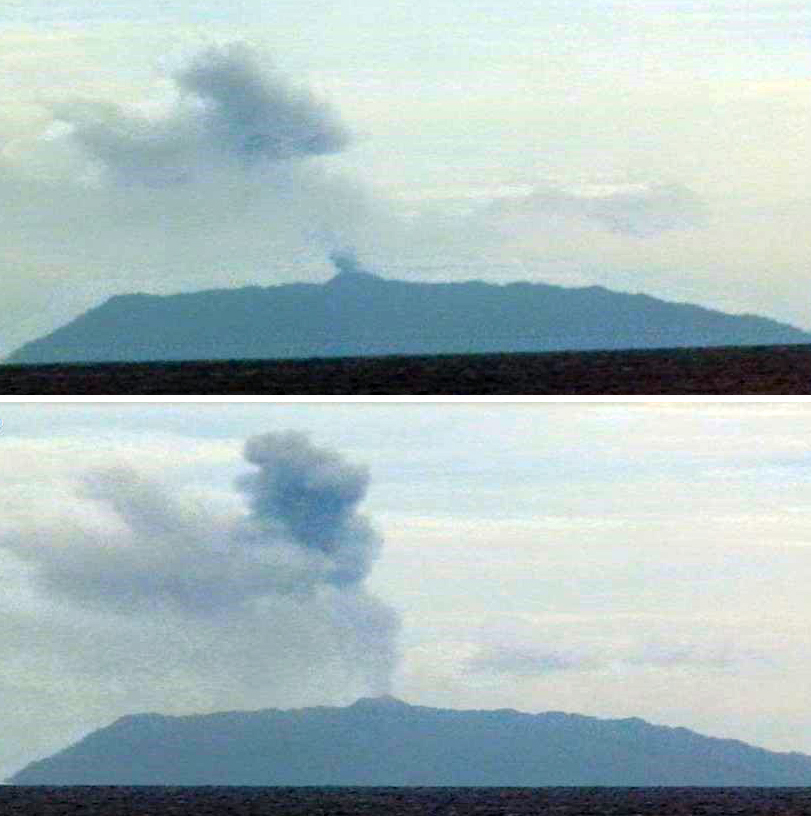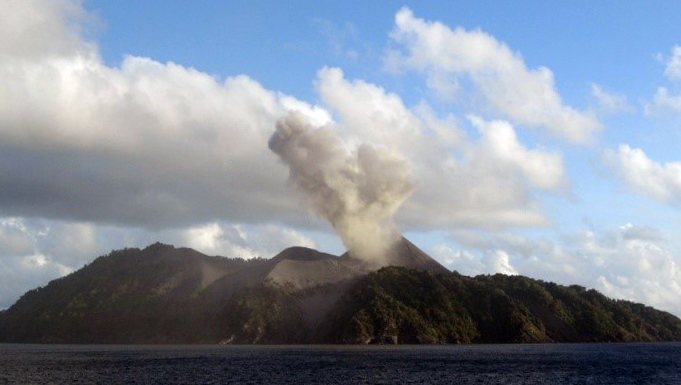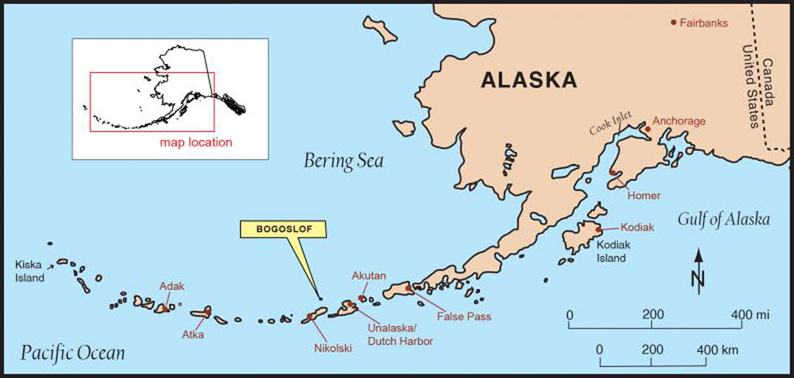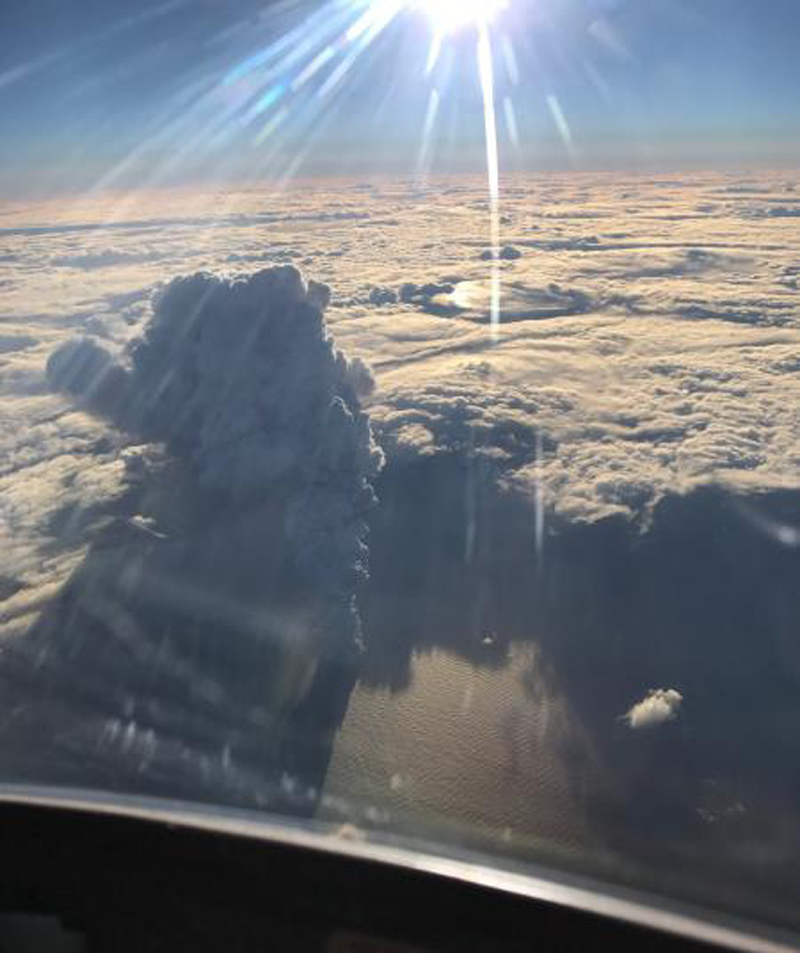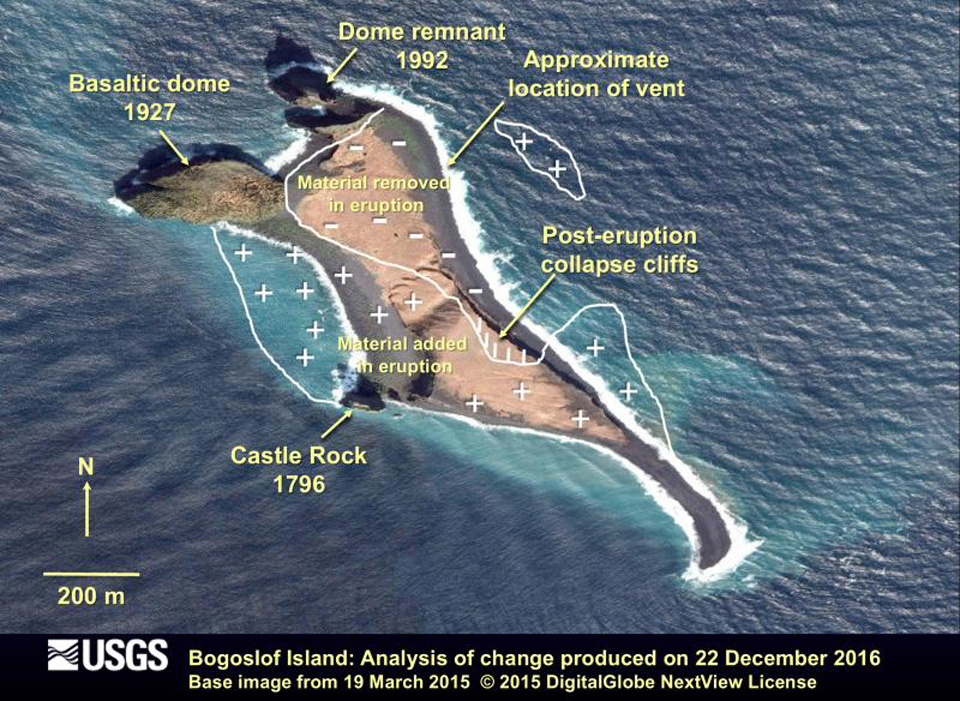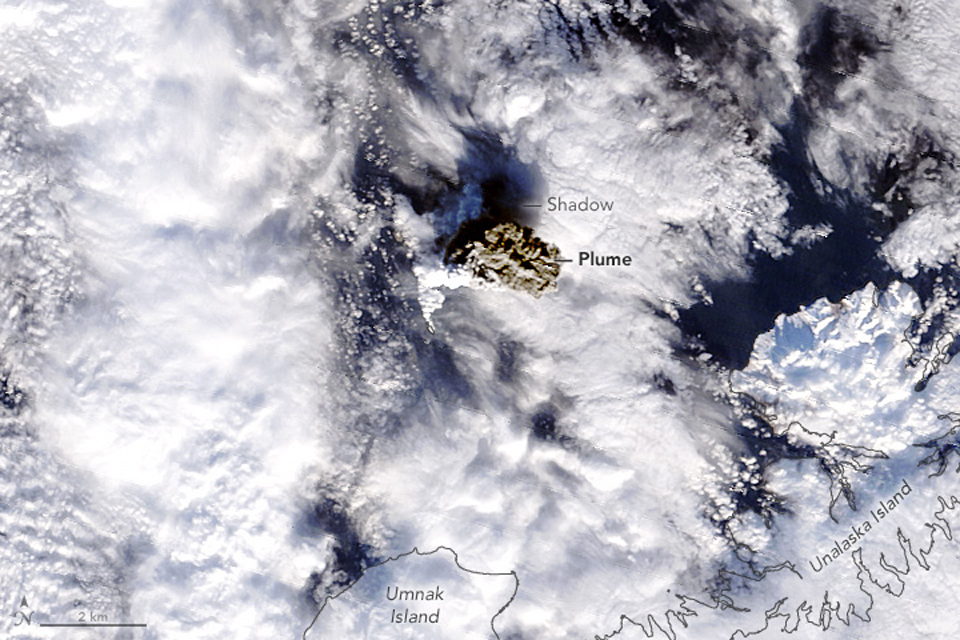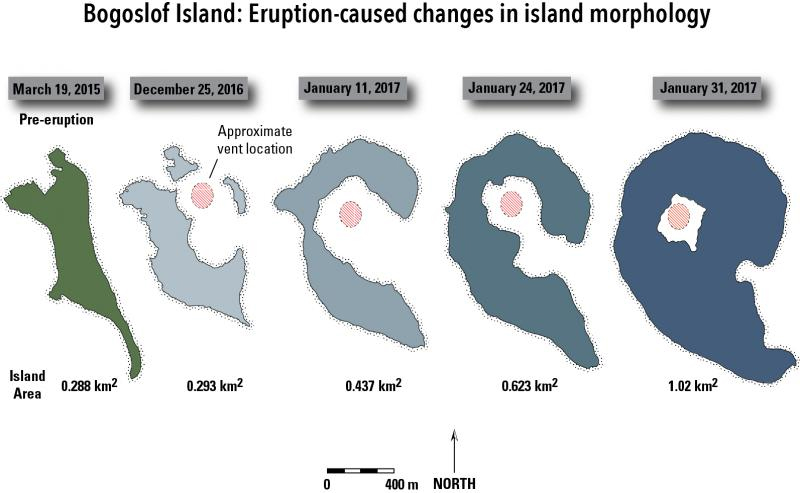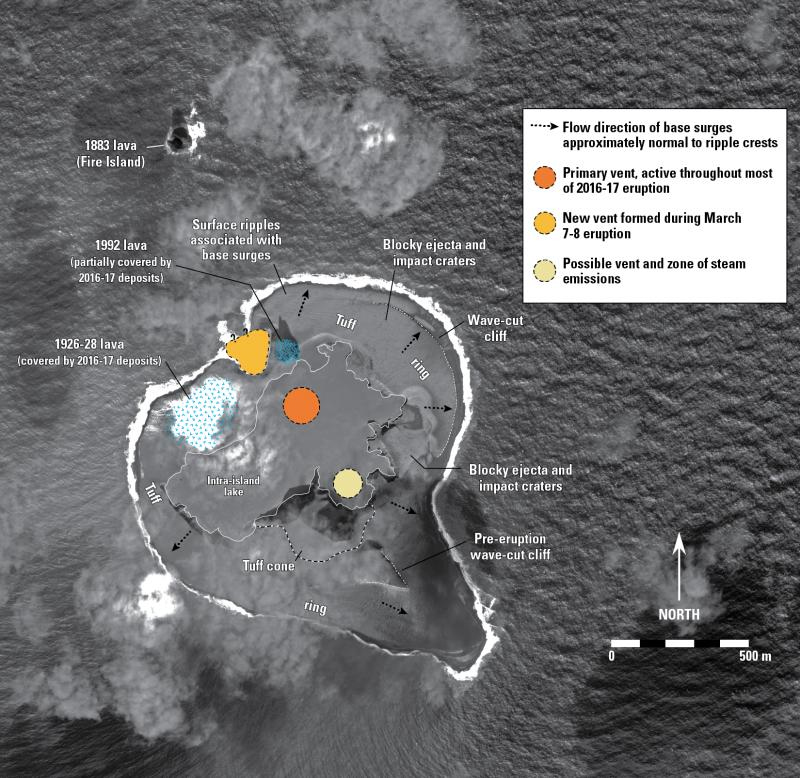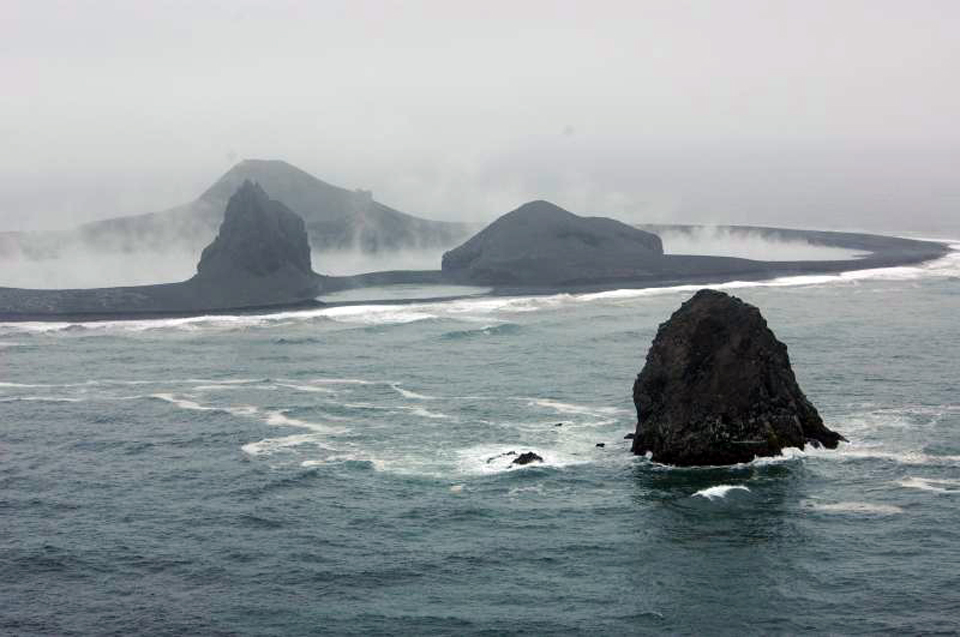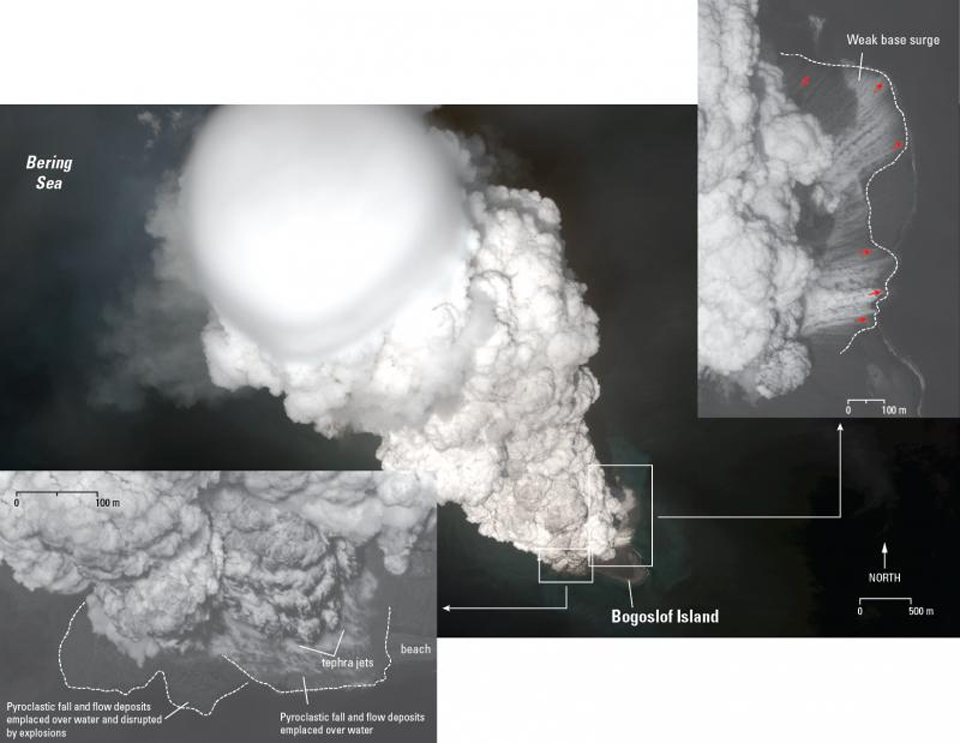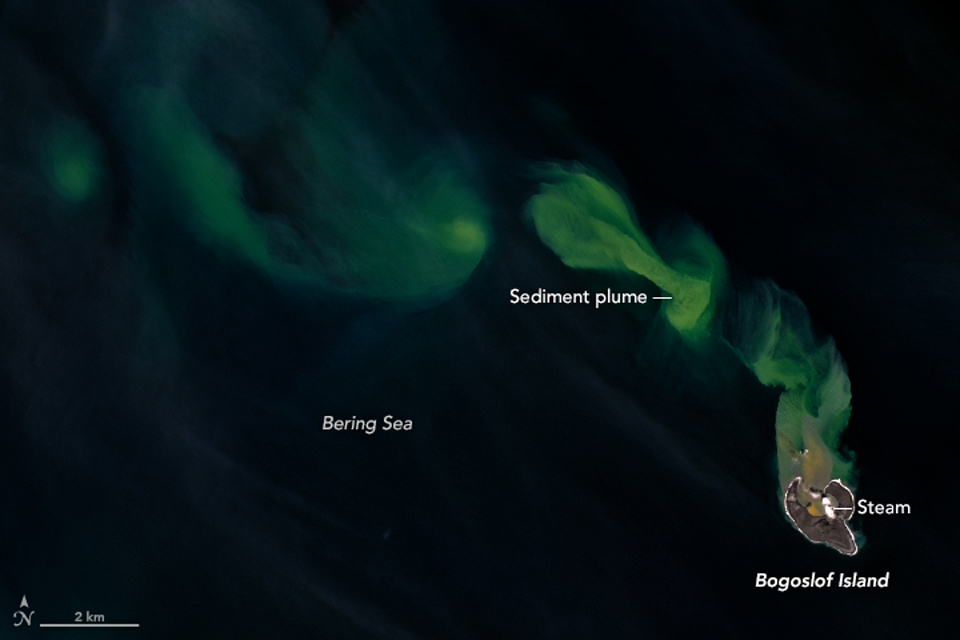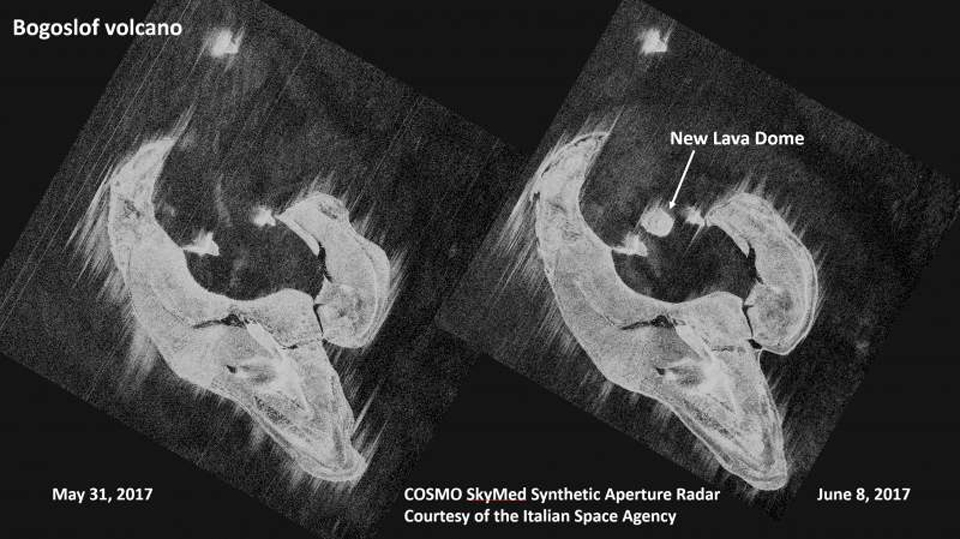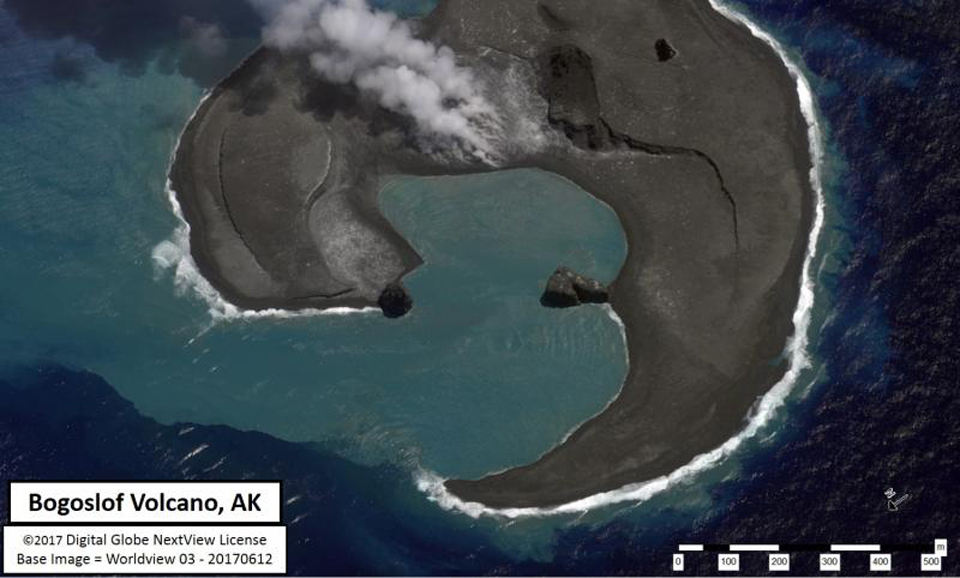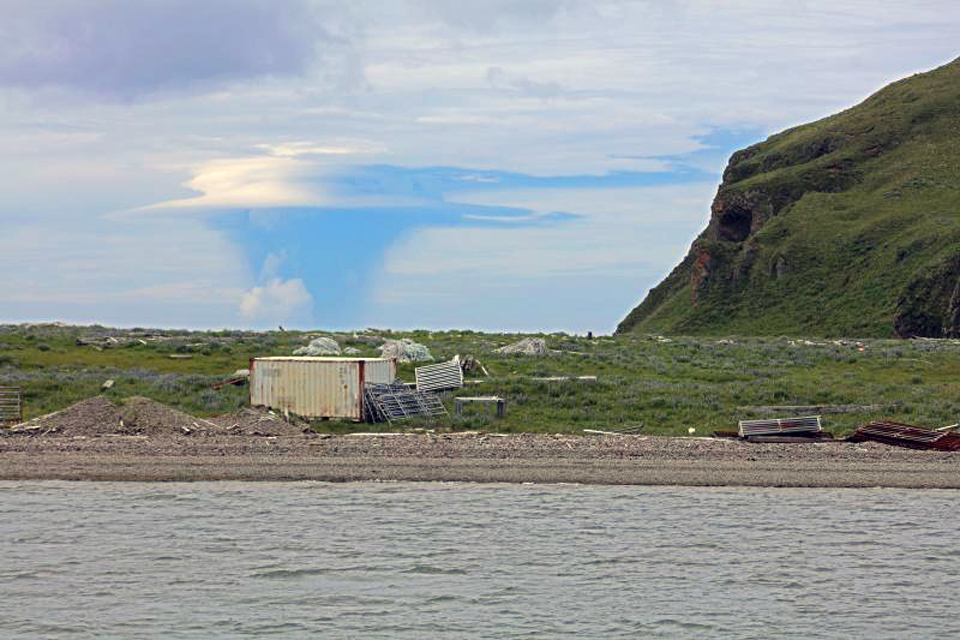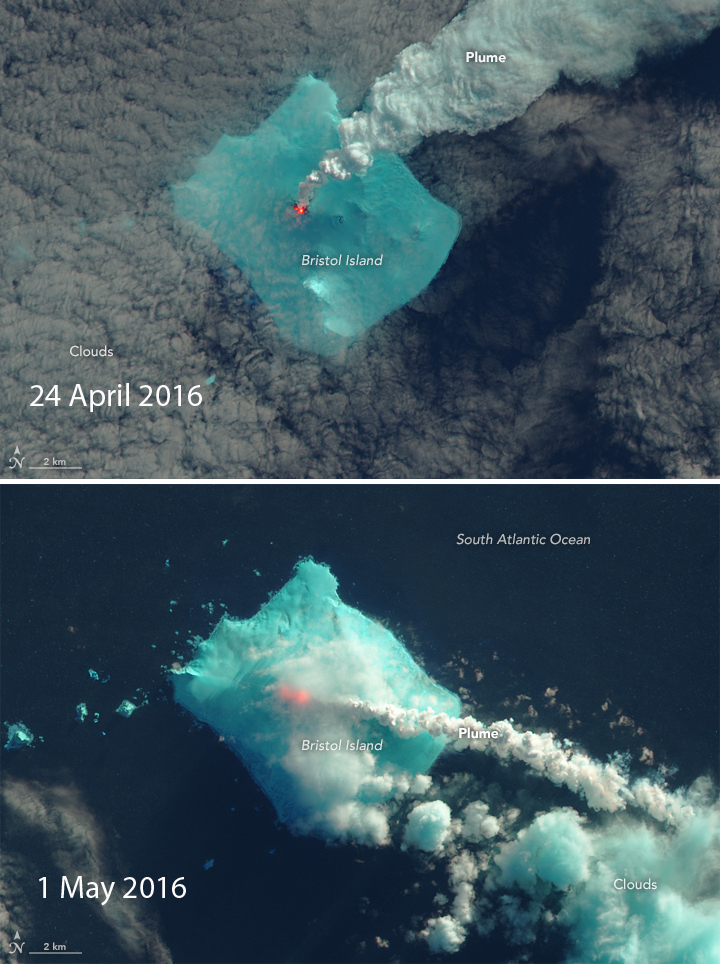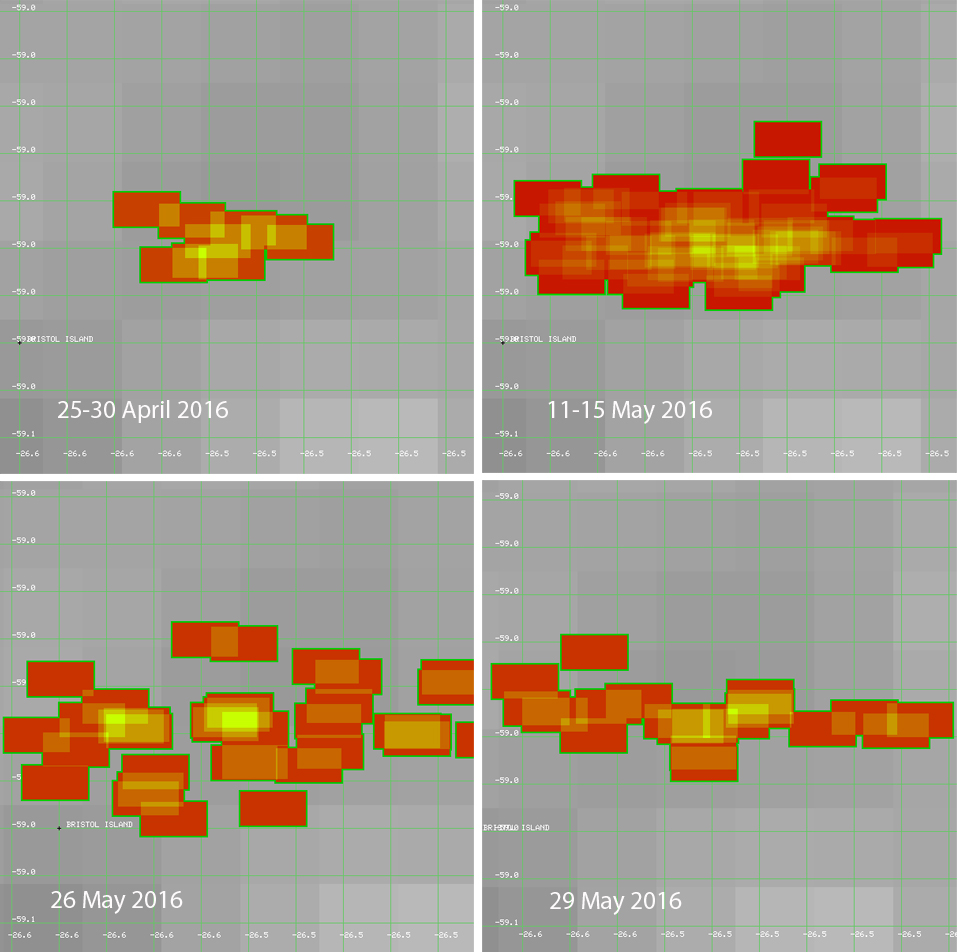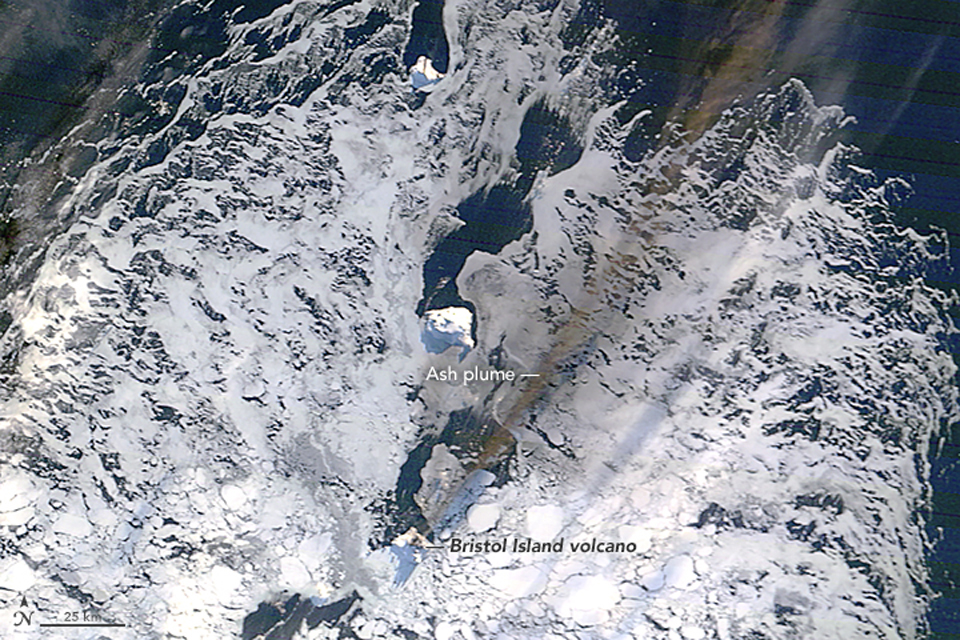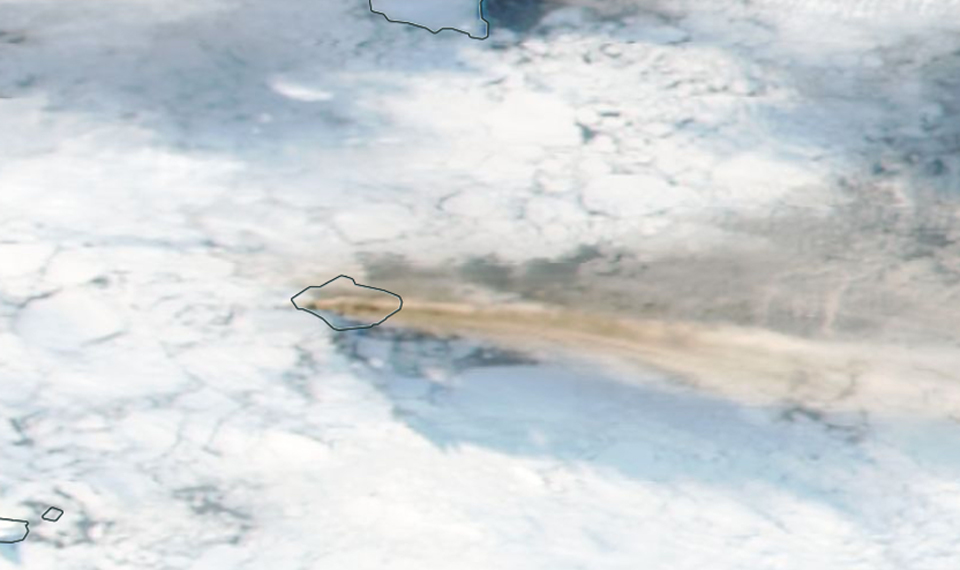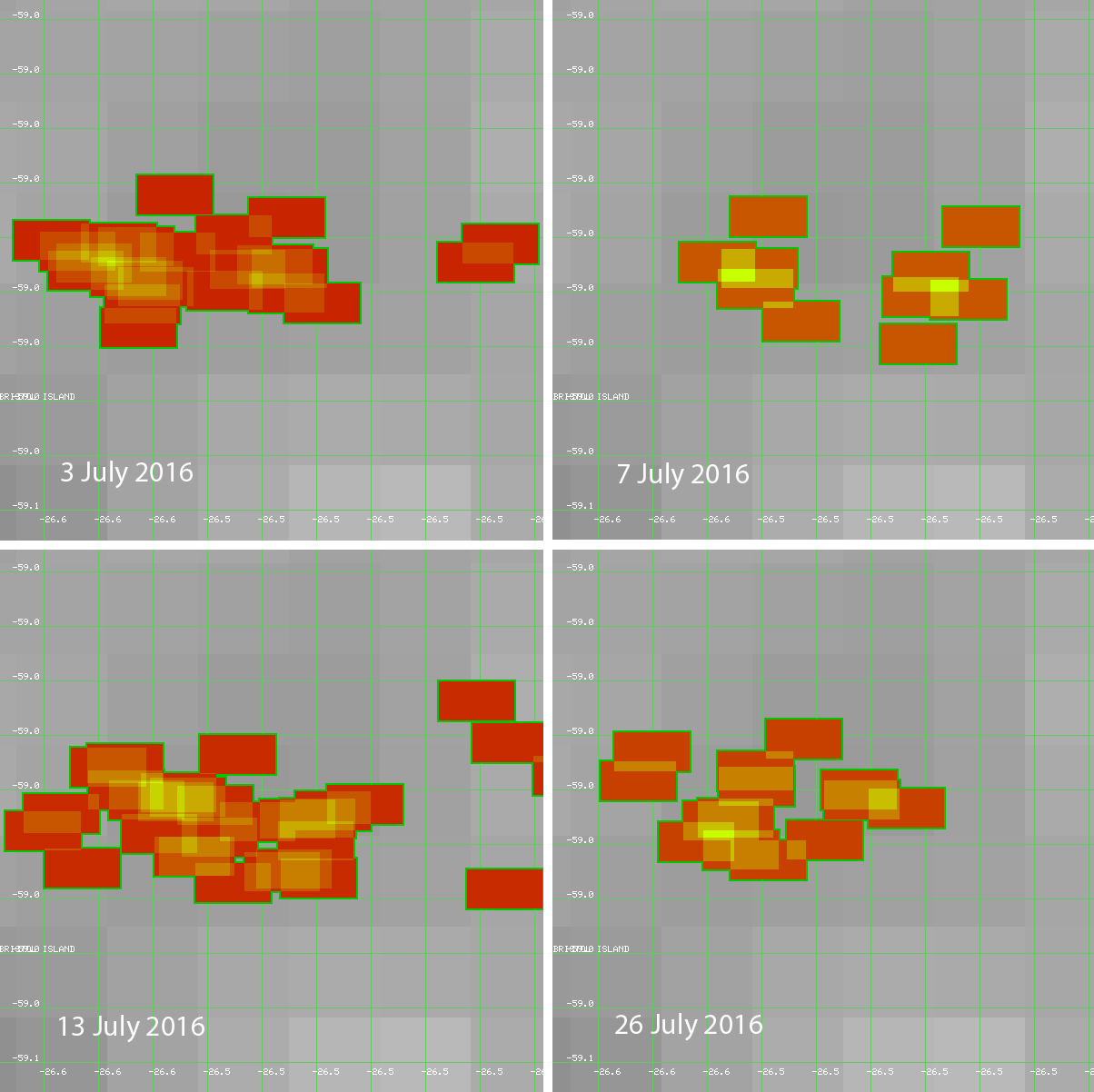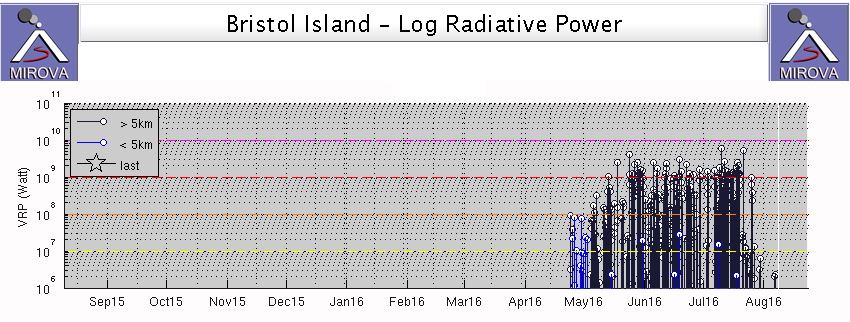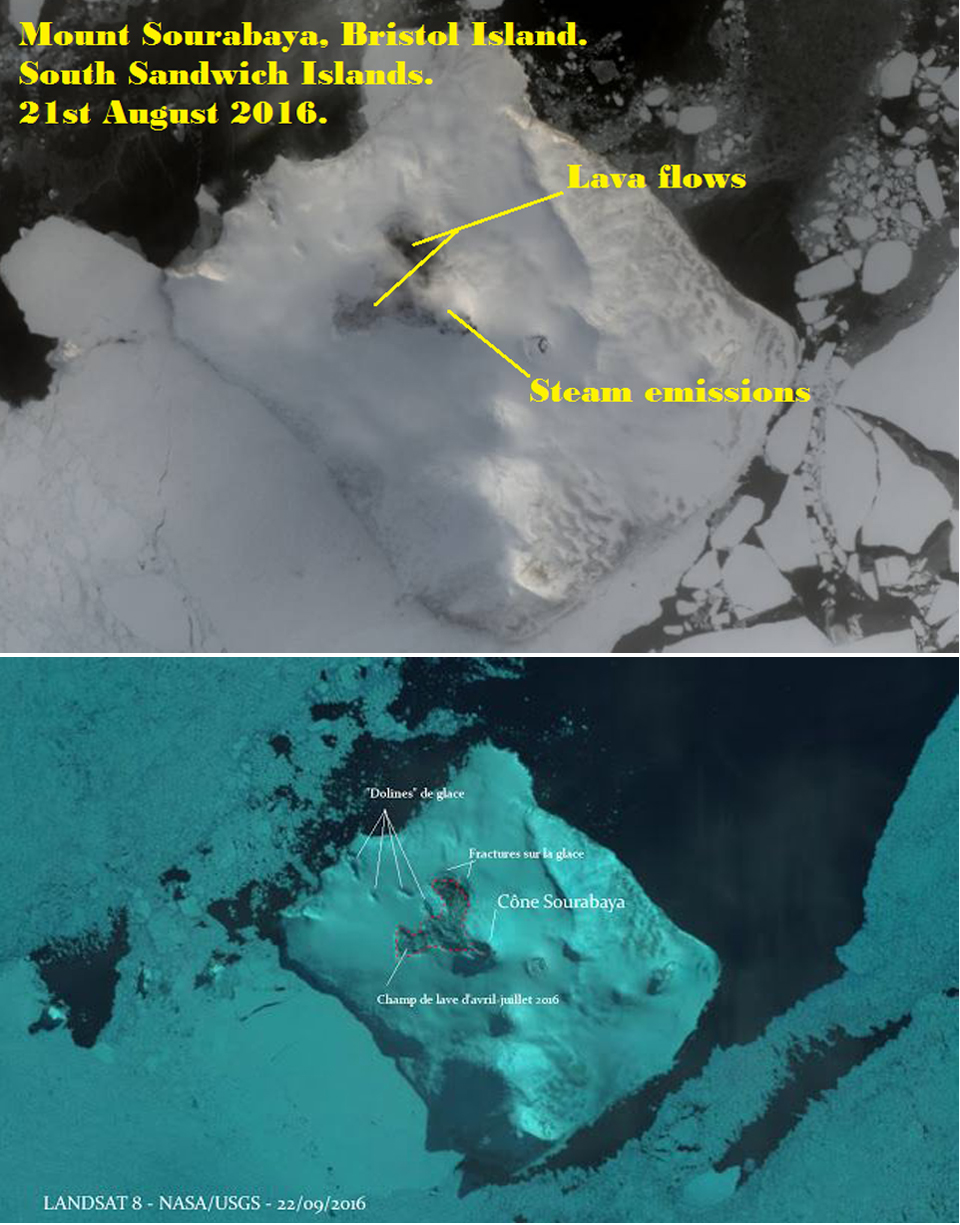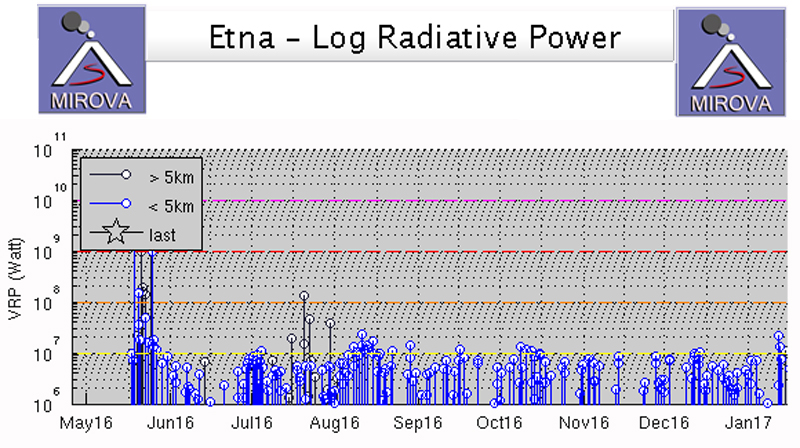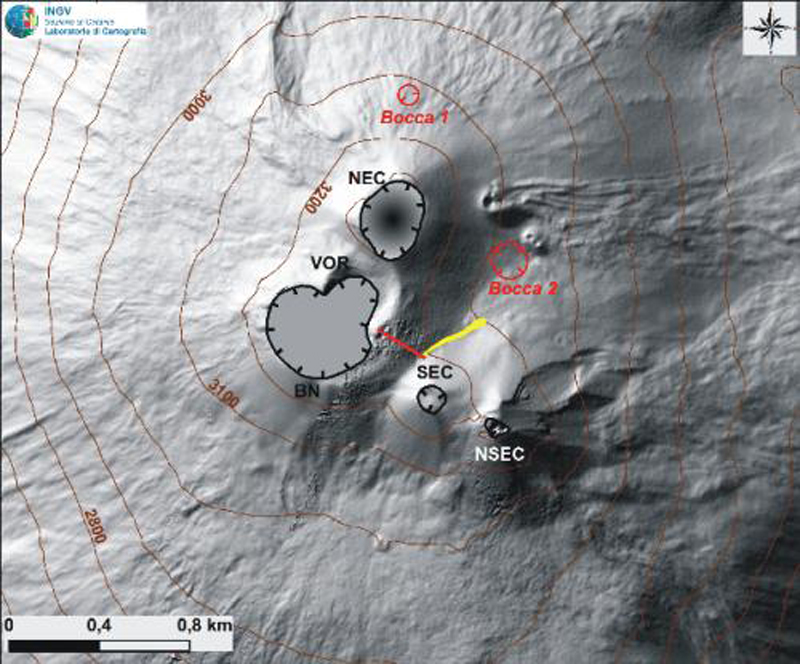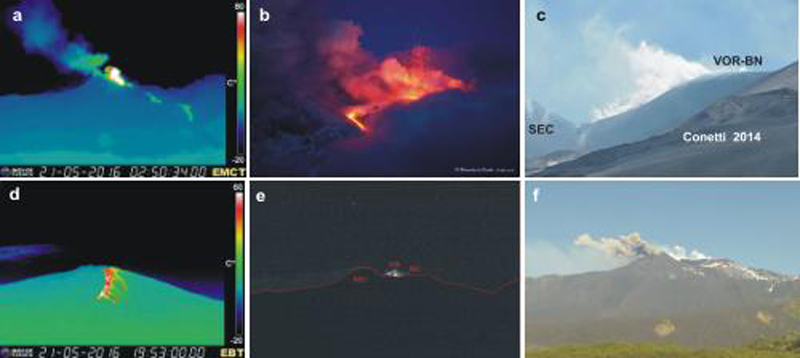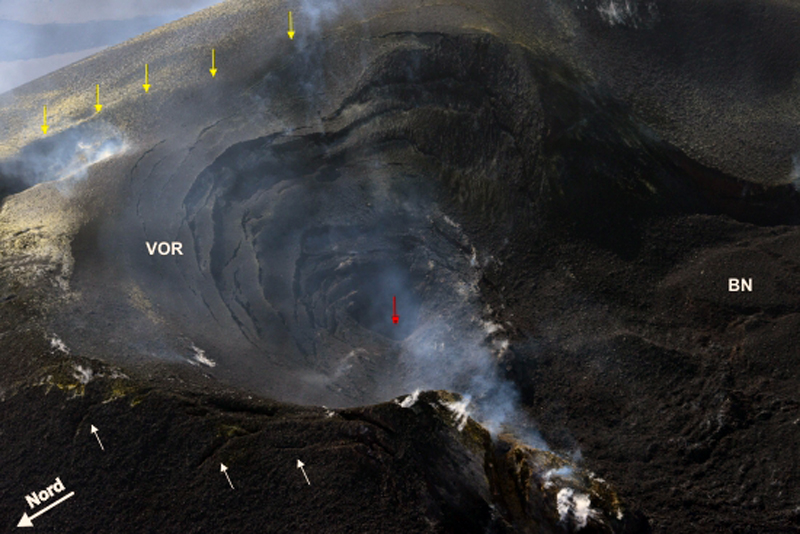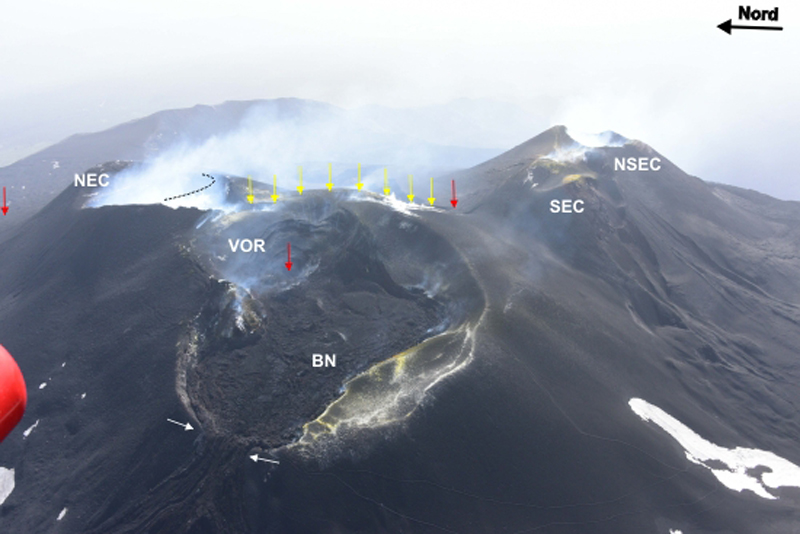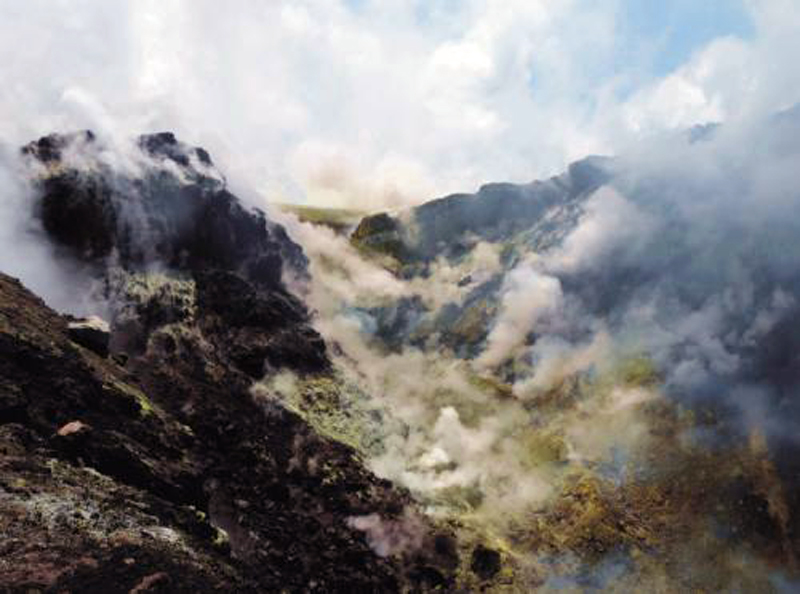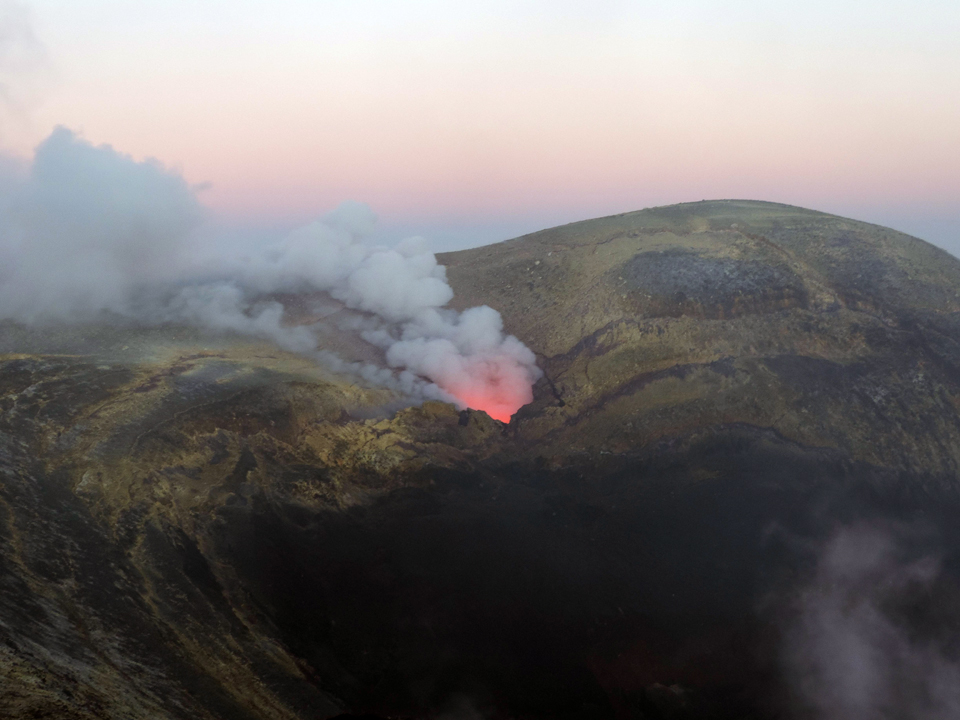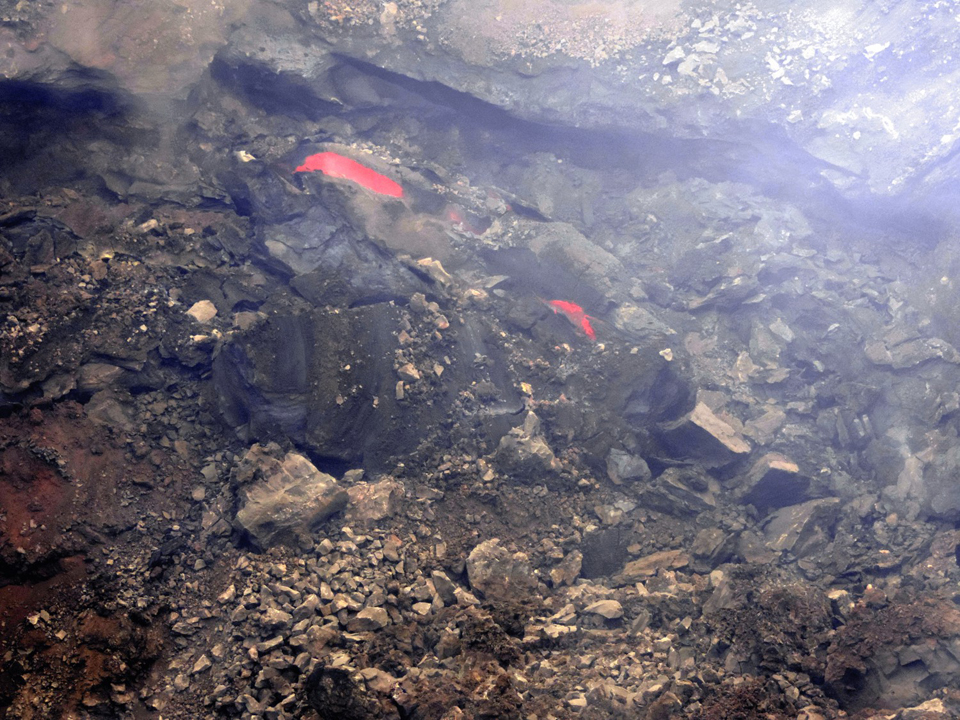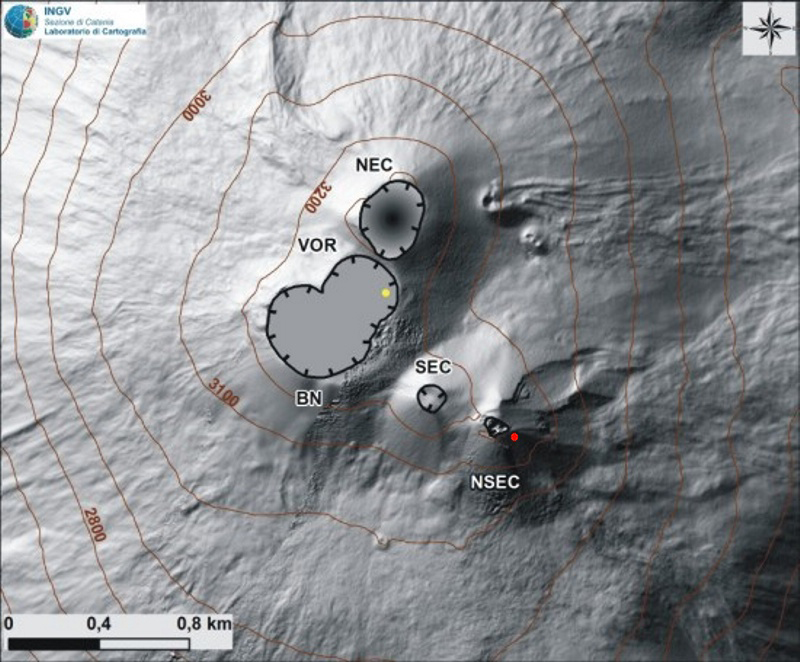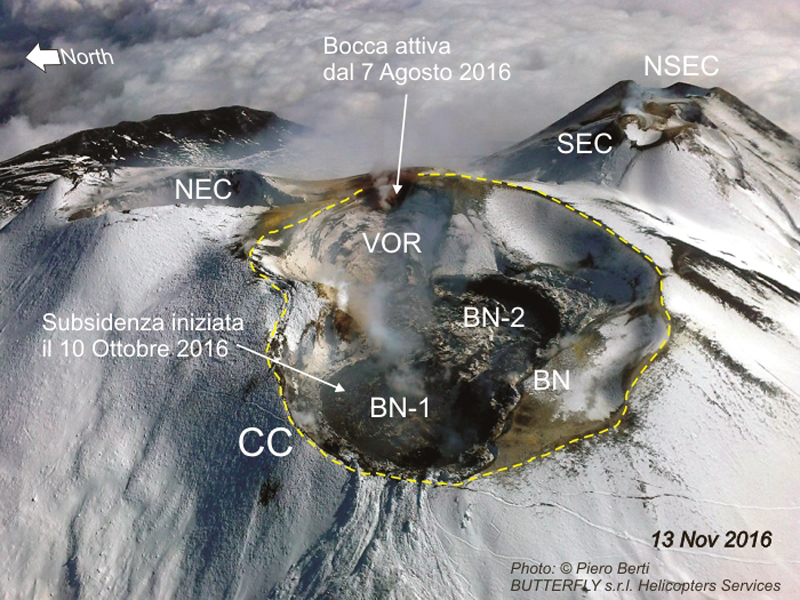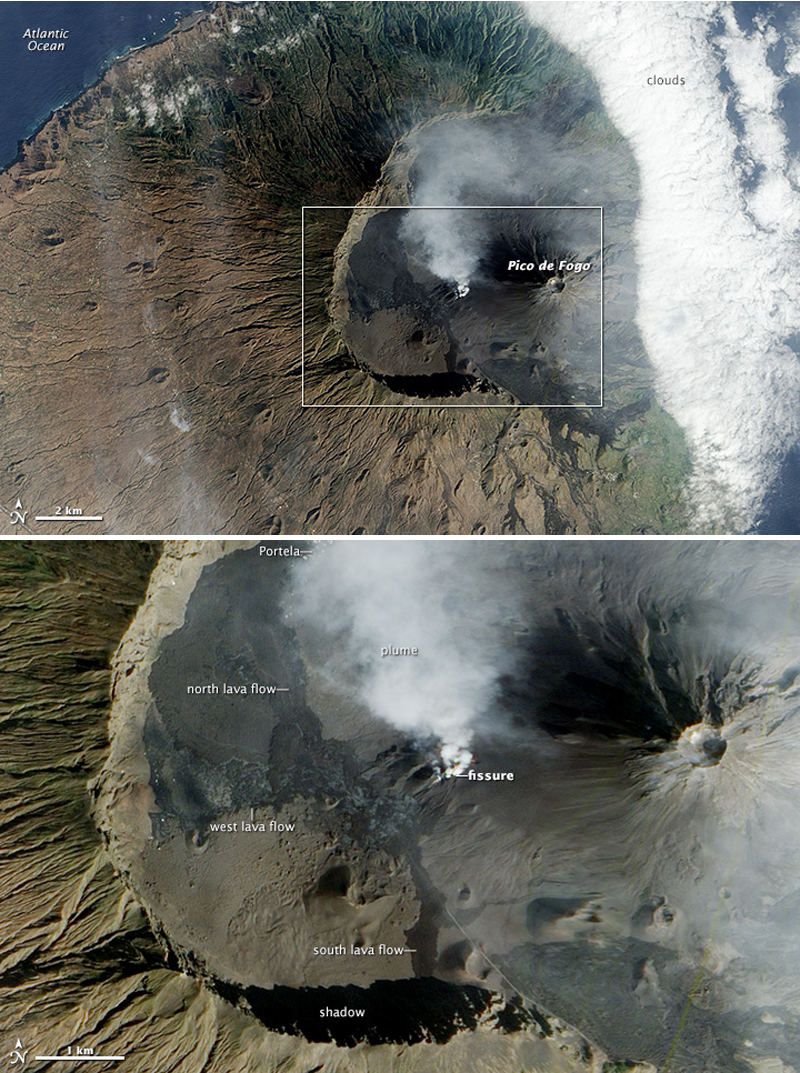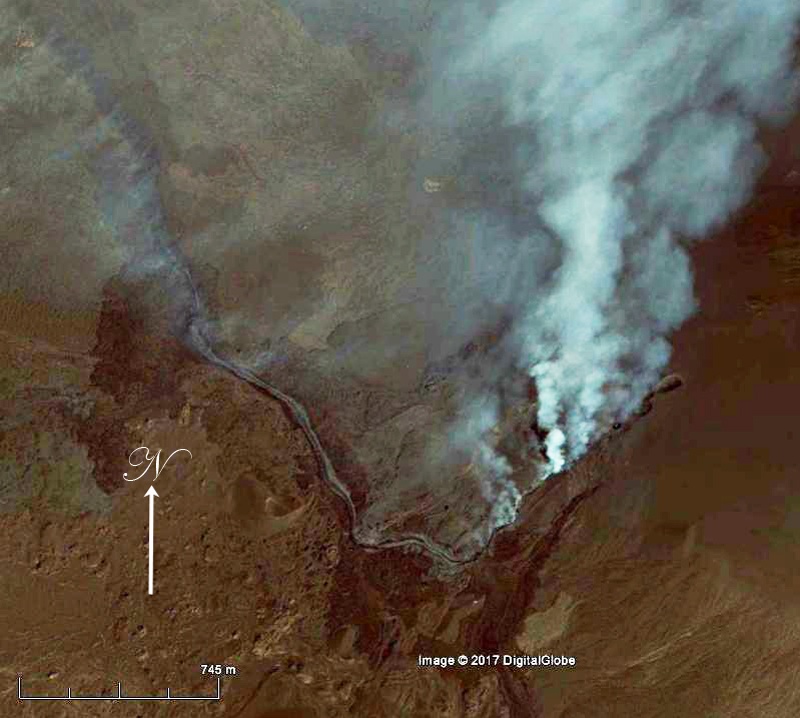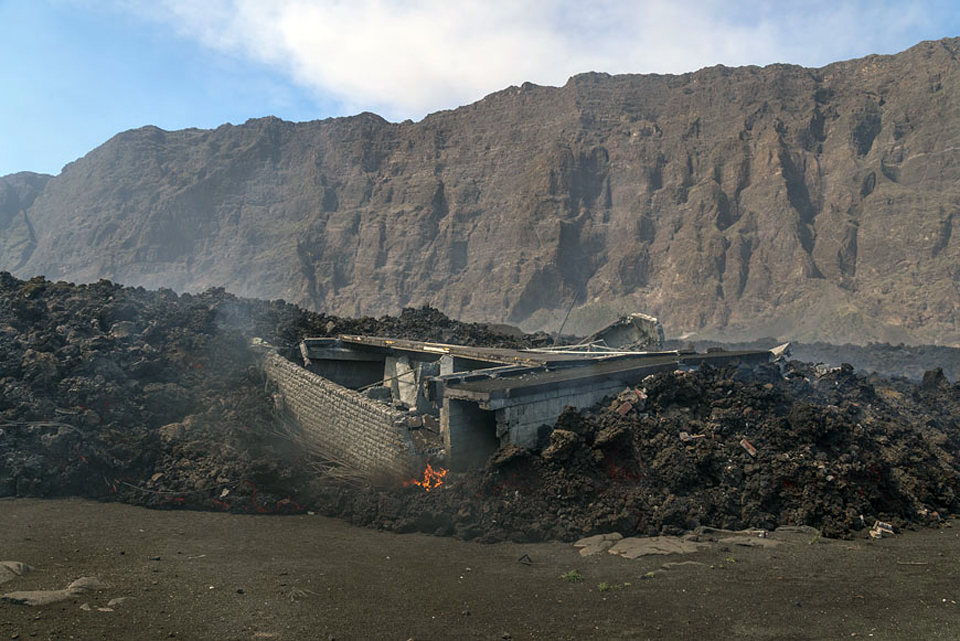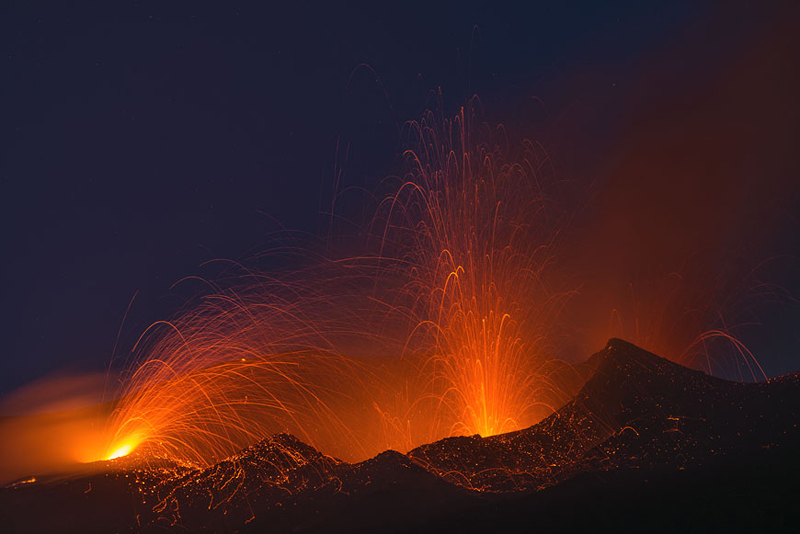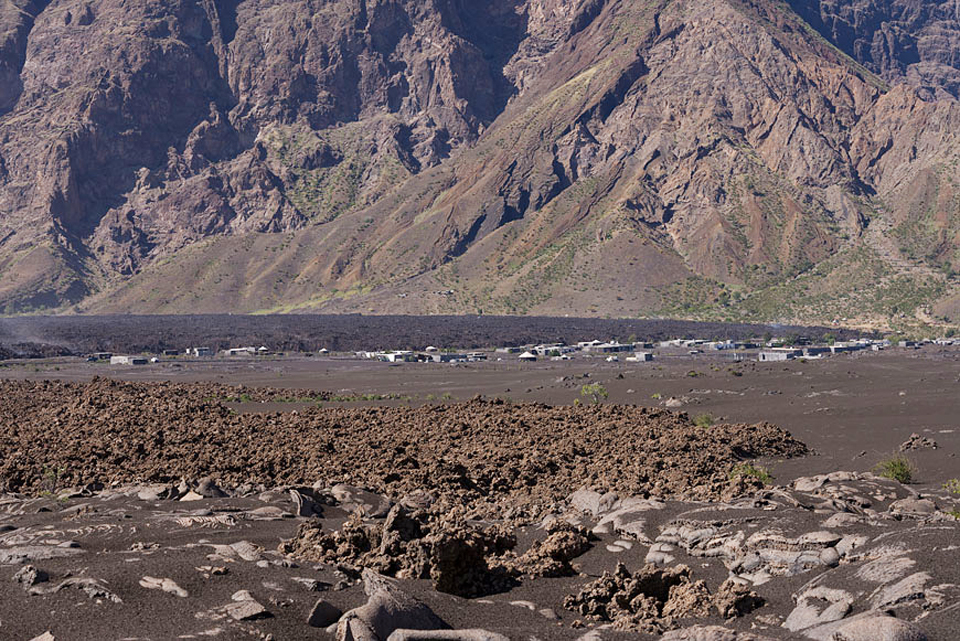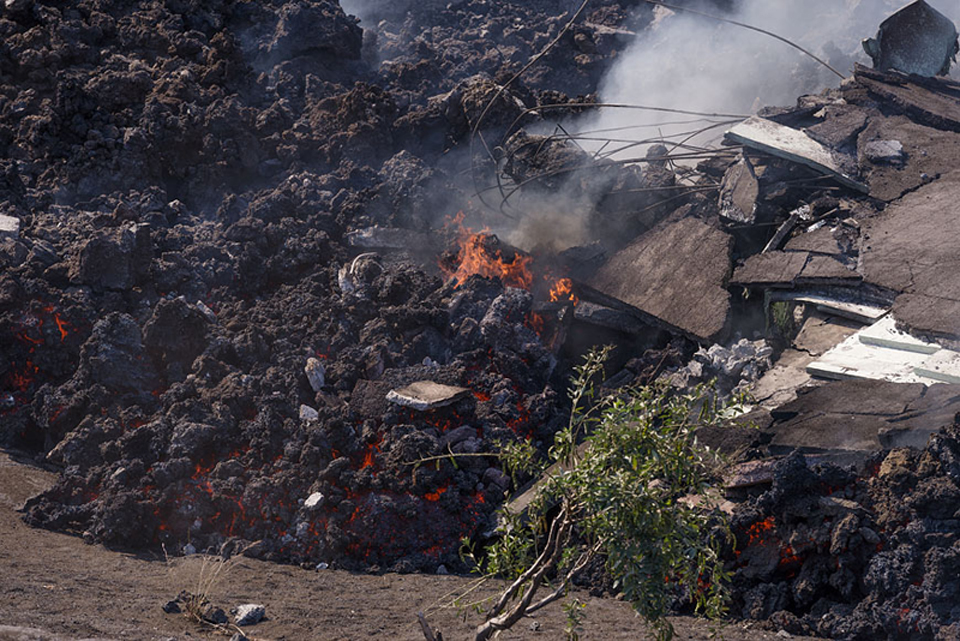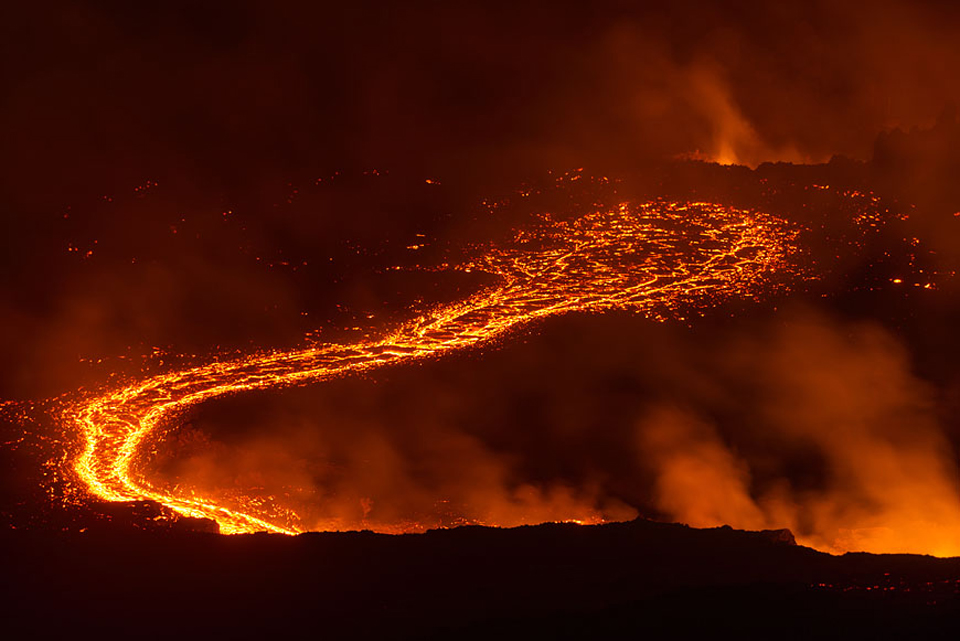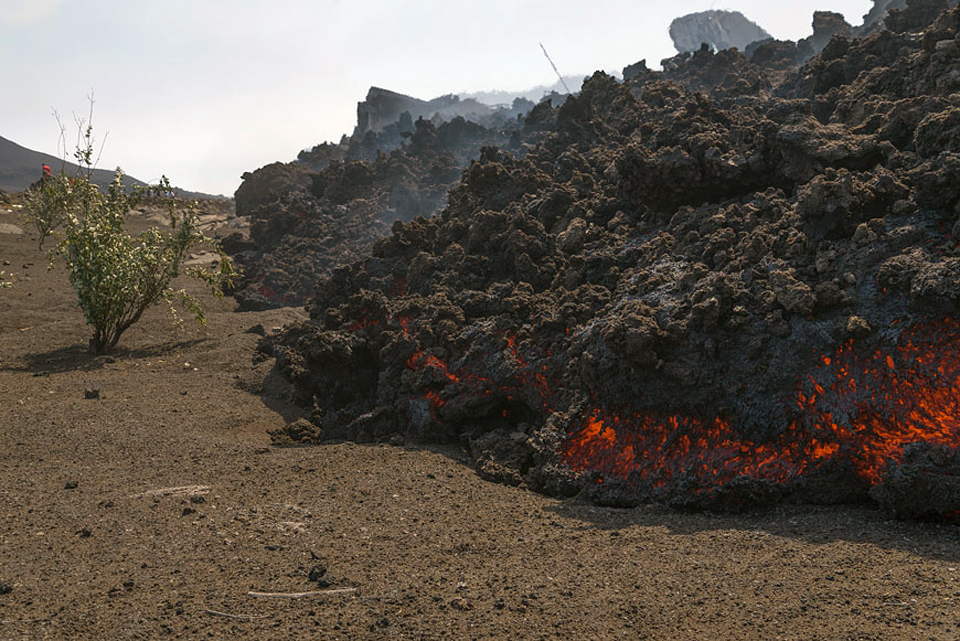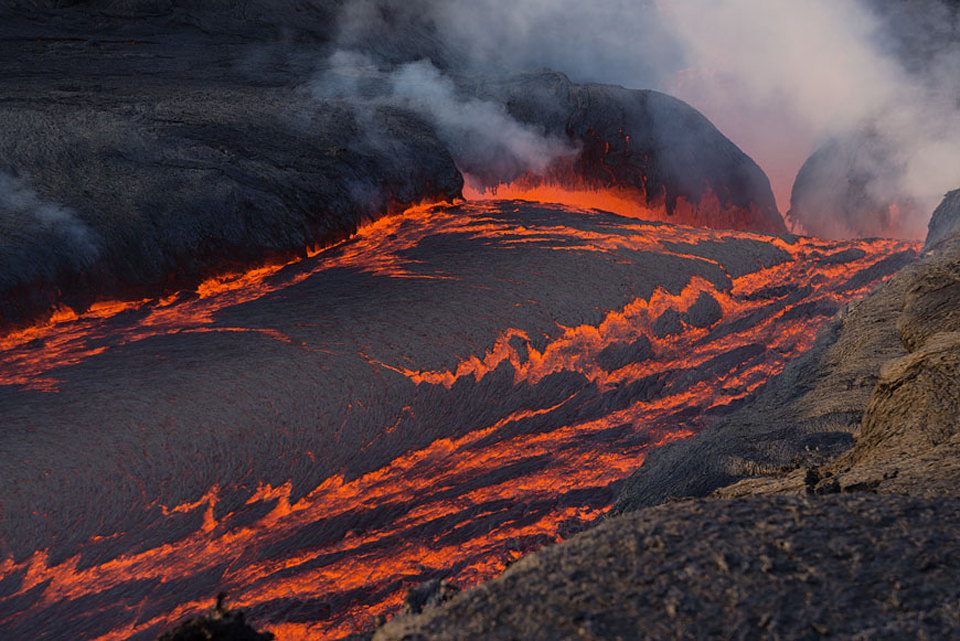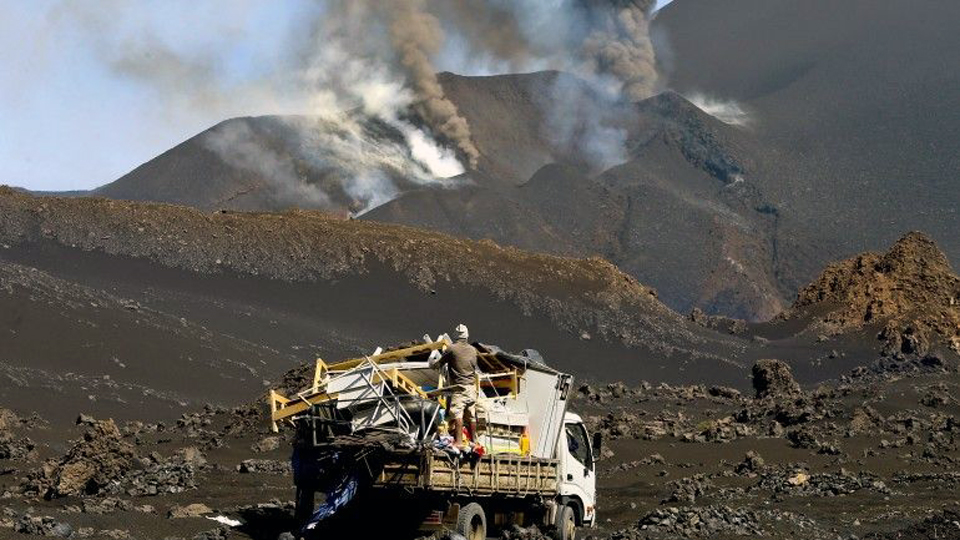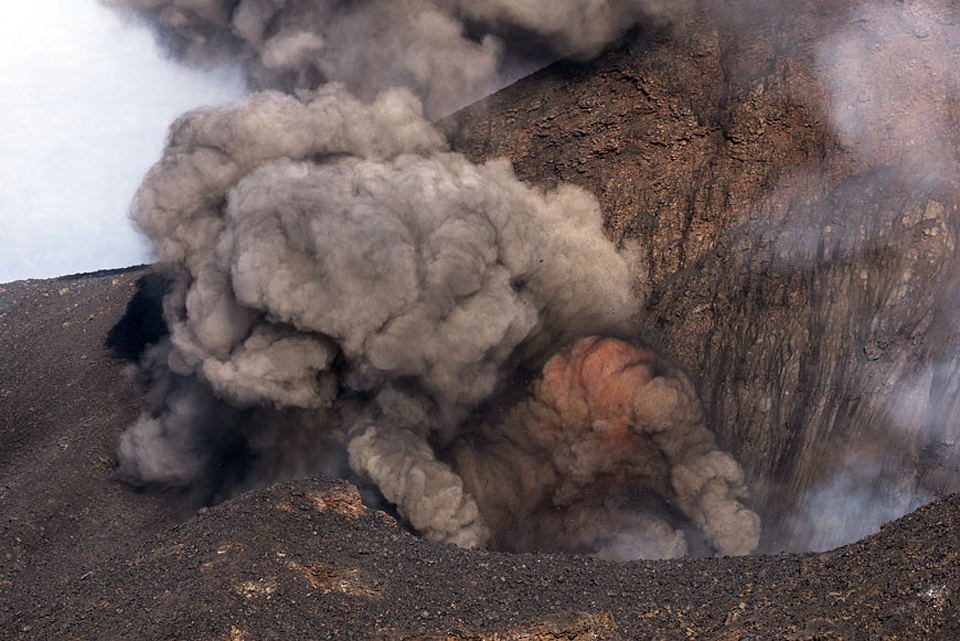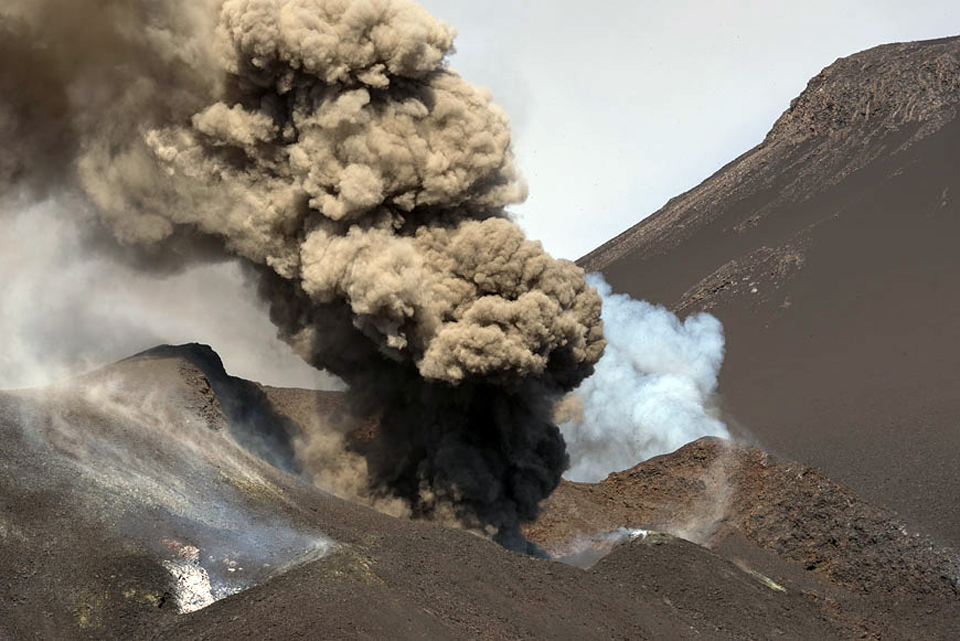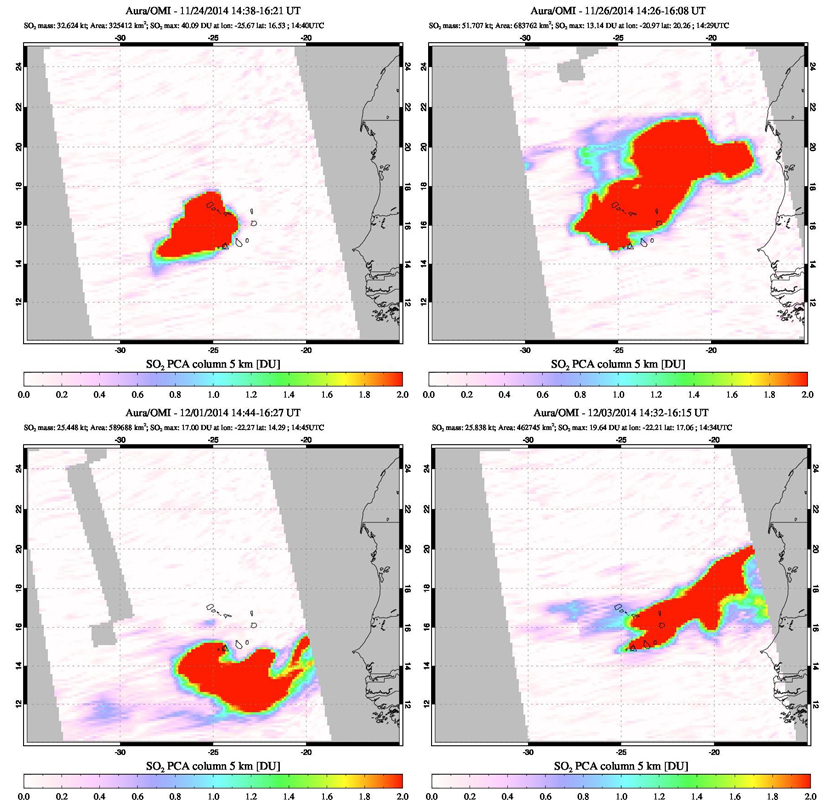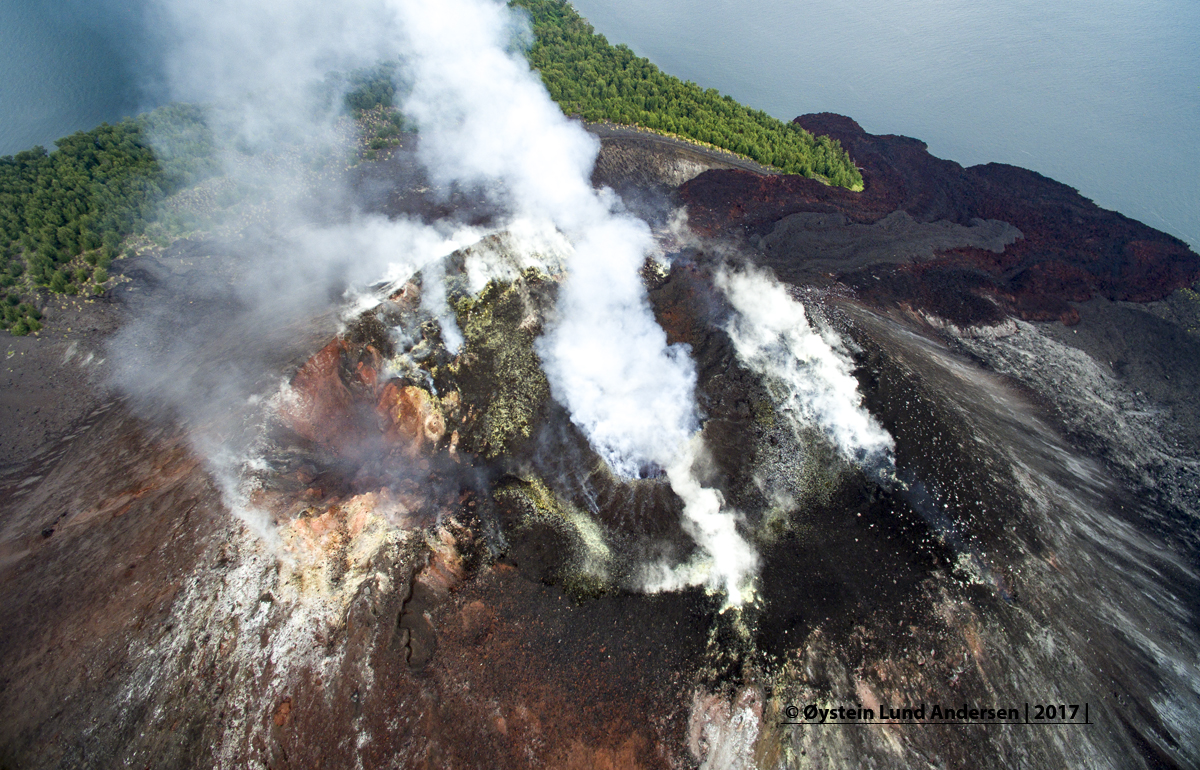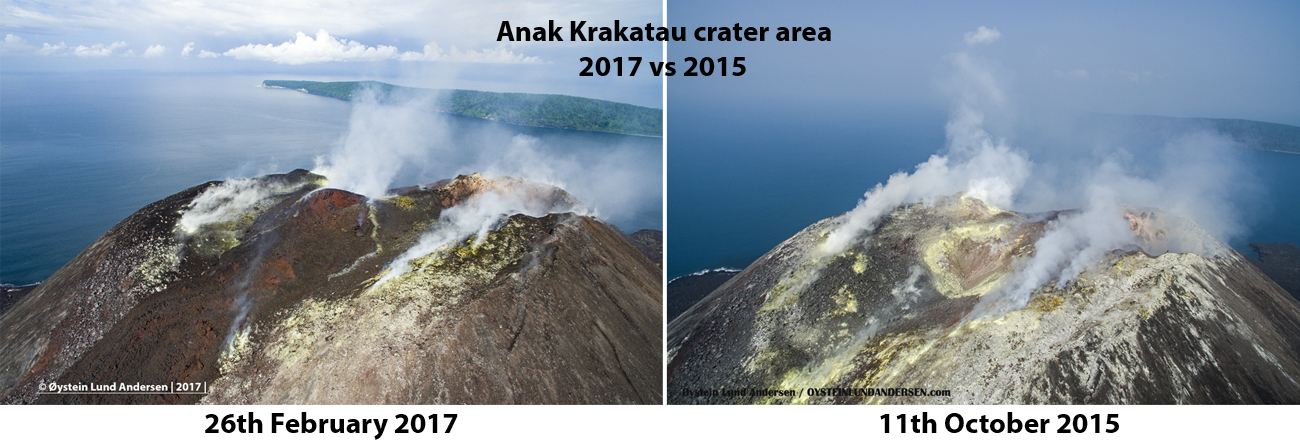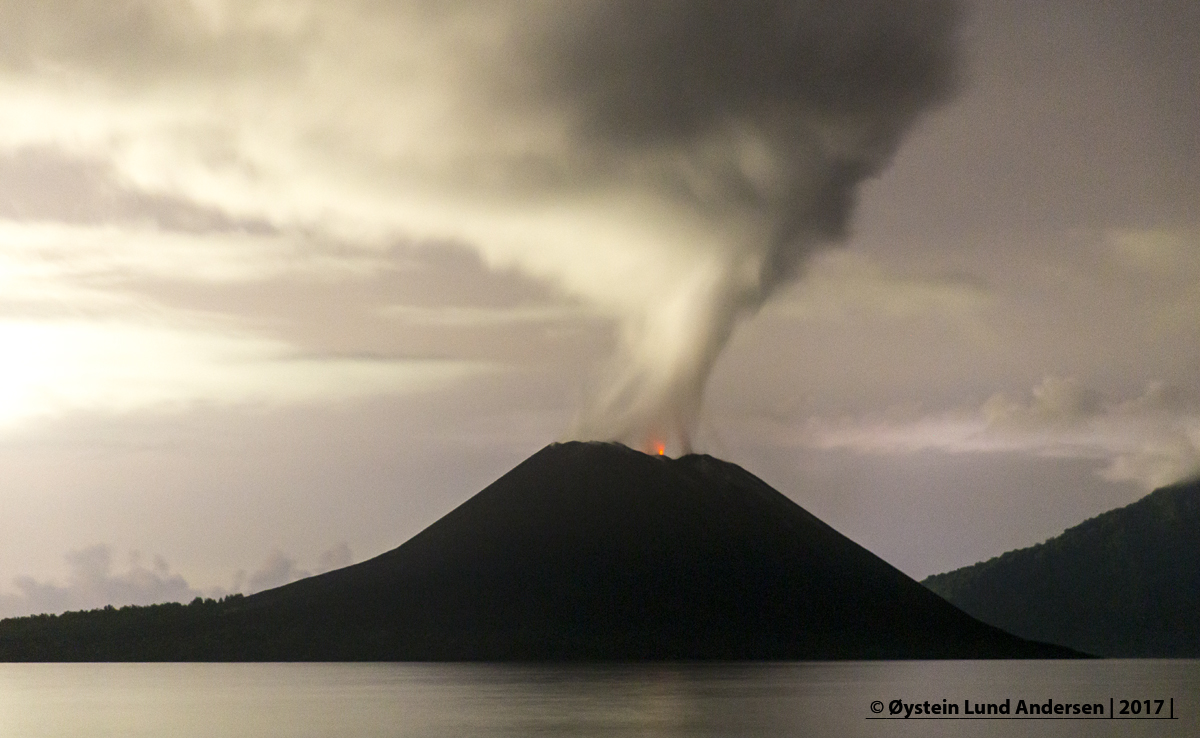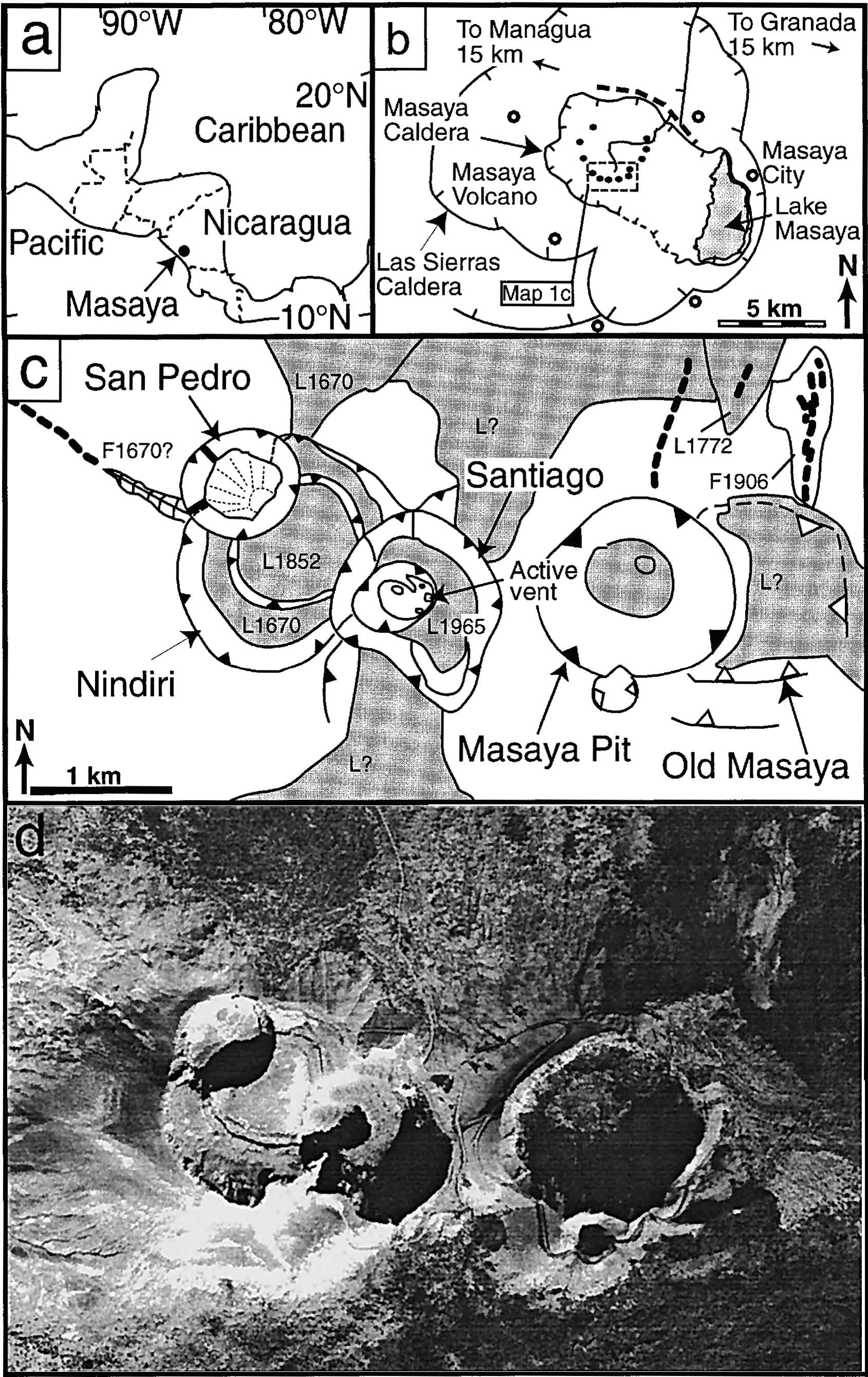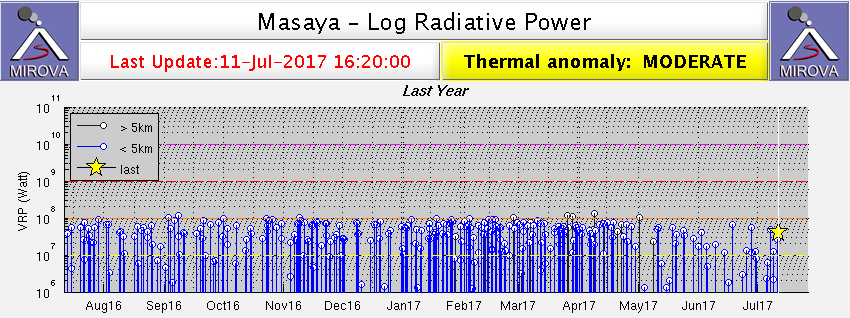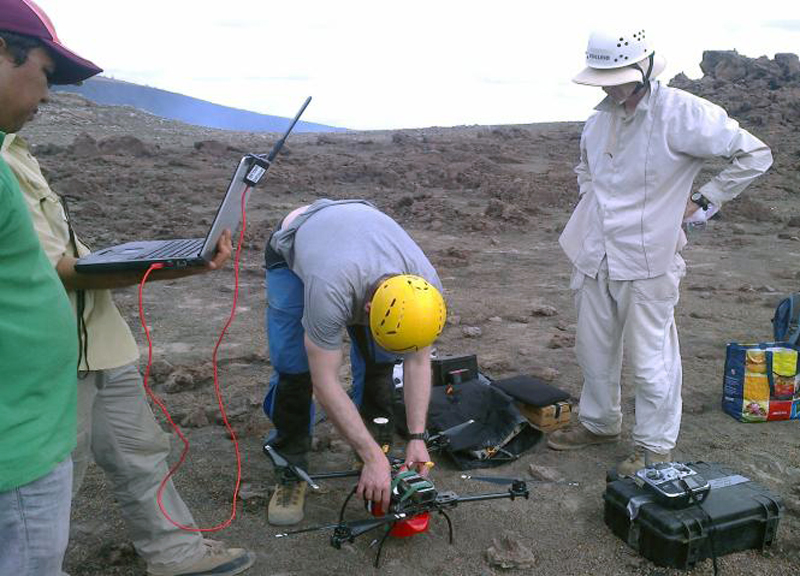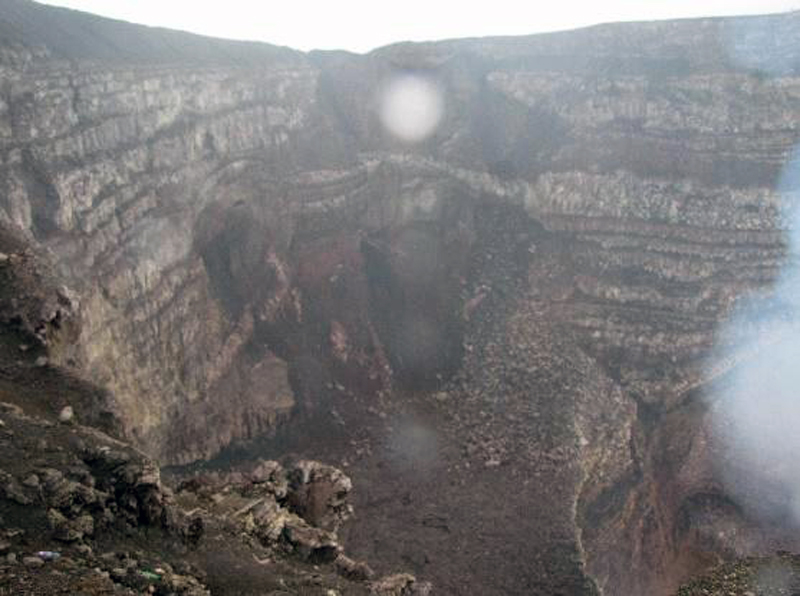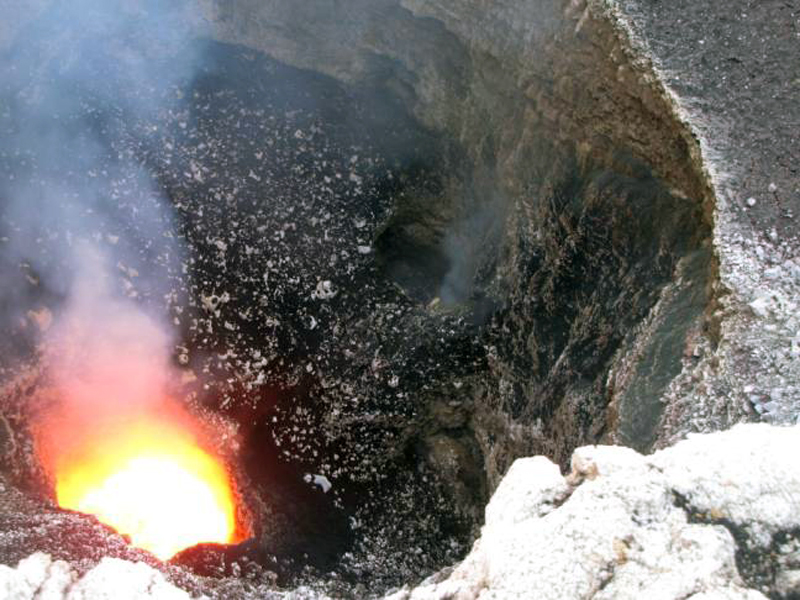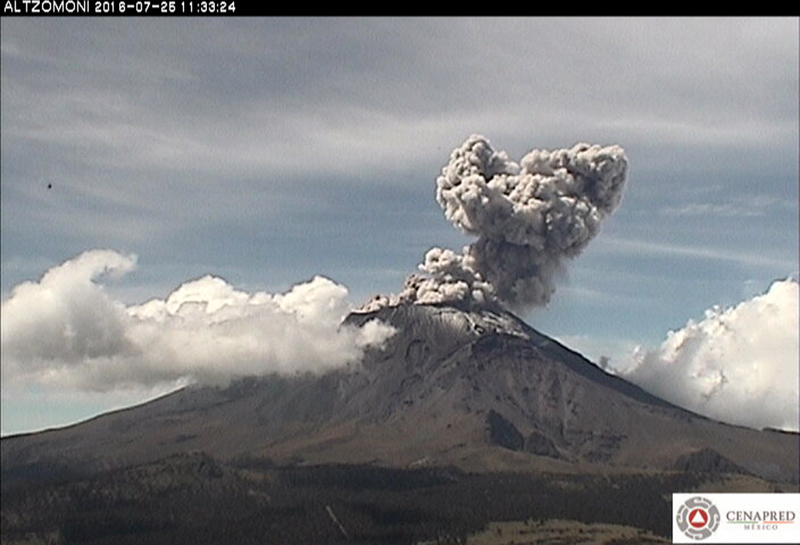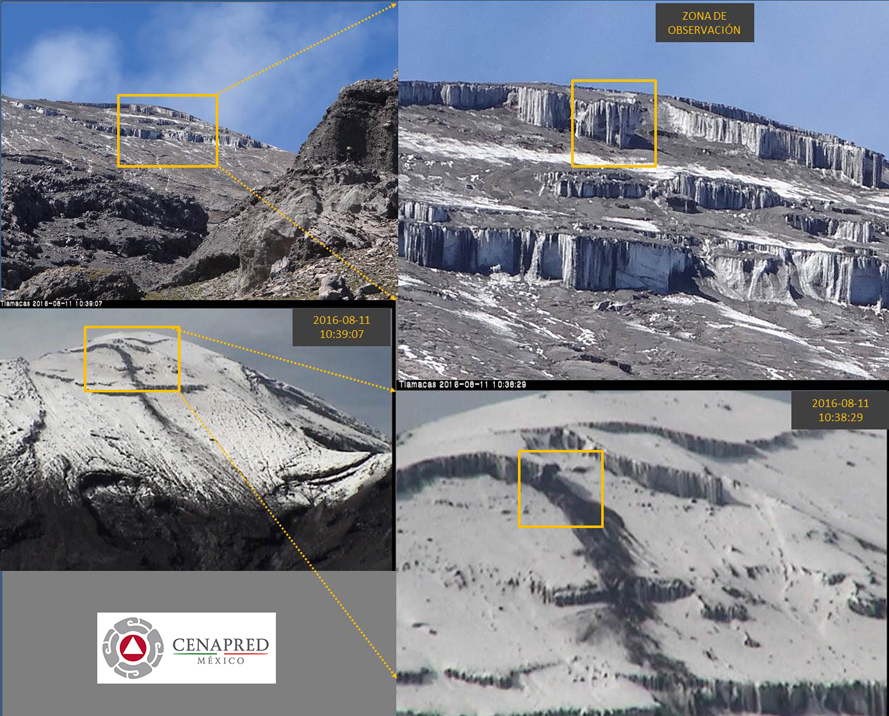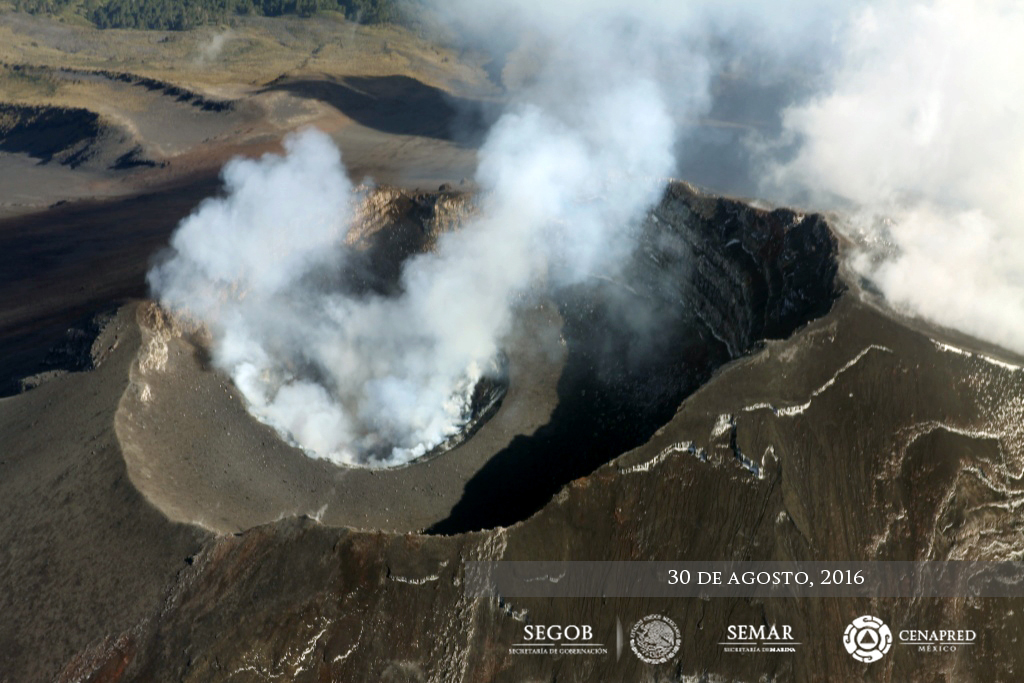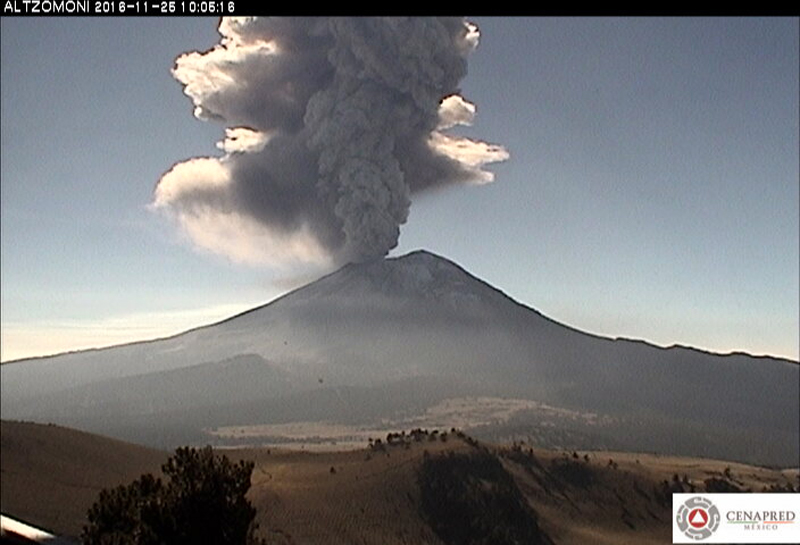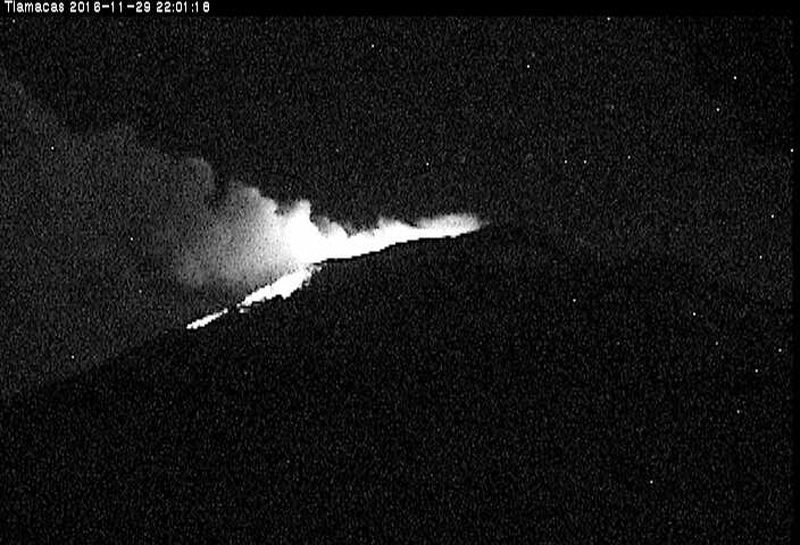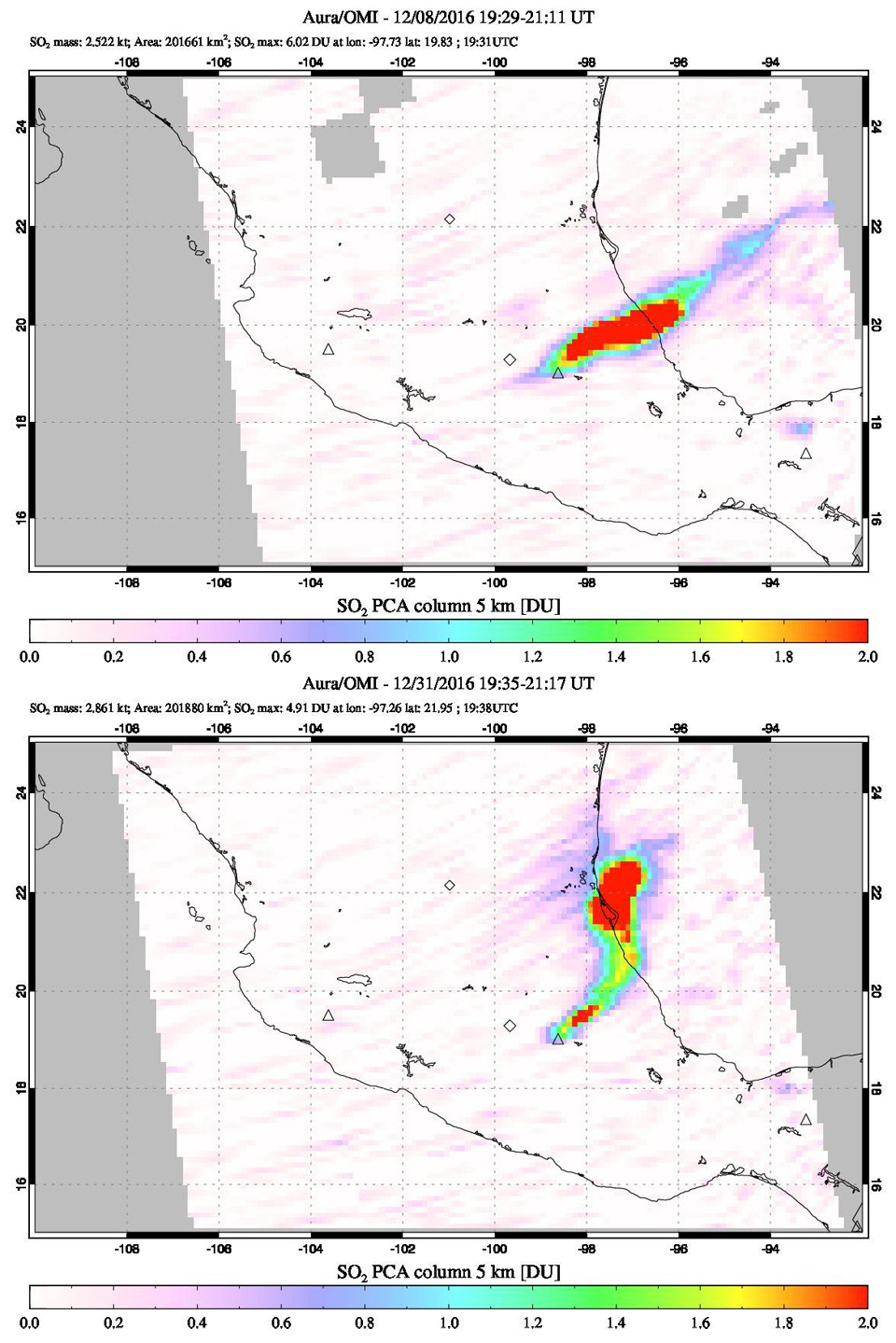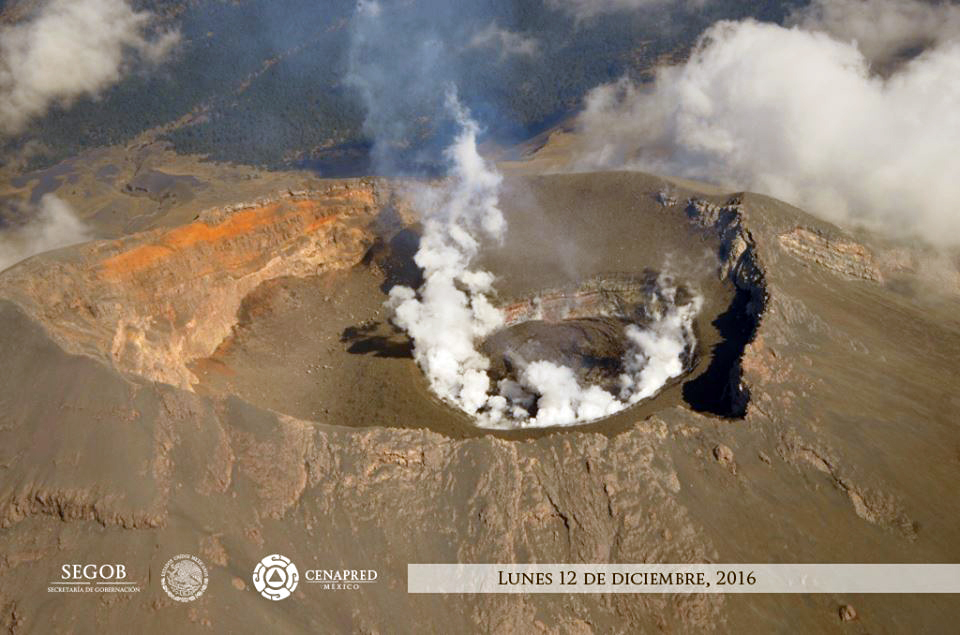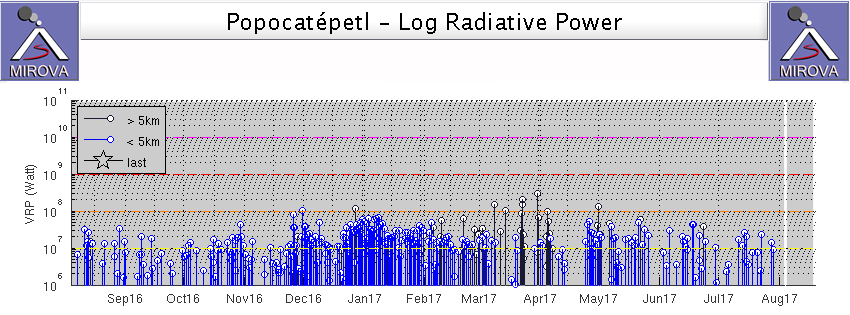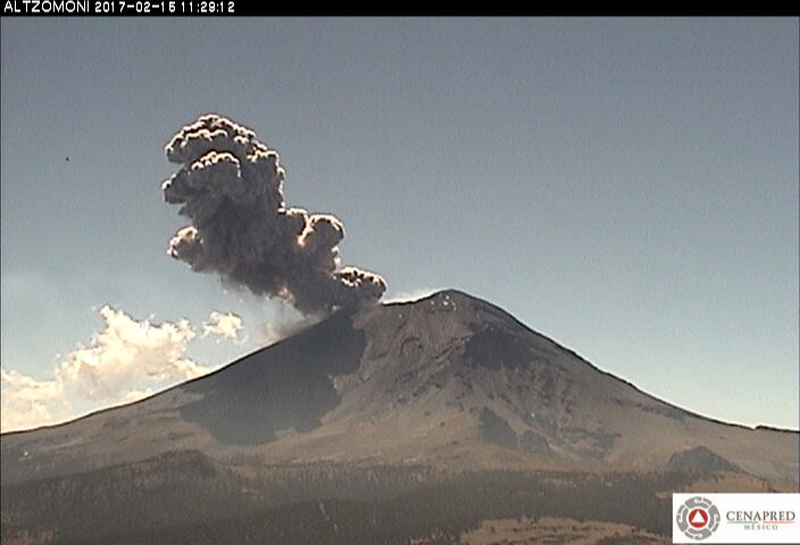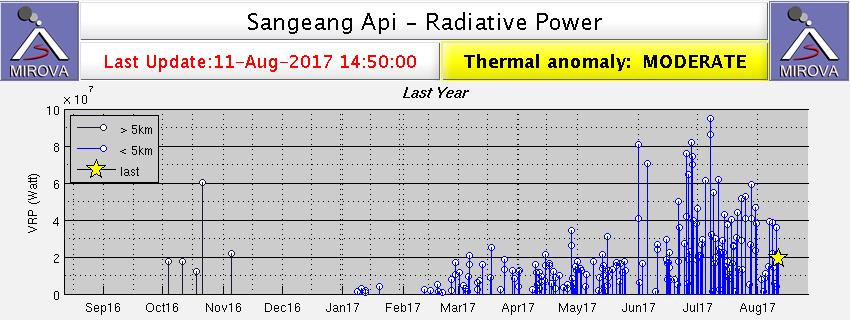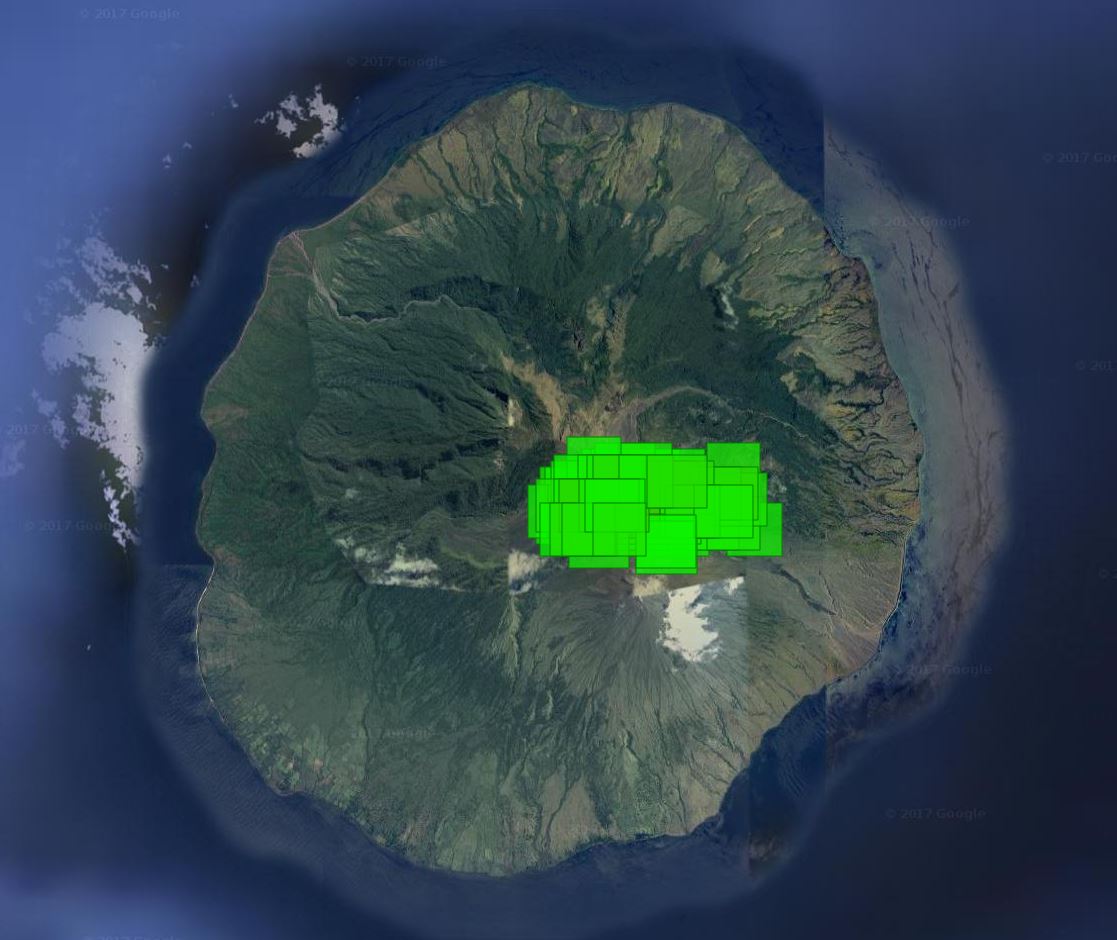Recently Published Bulletin Reports
Kadovar (Papua New Guinea) An ash plume and weak thermal anomaly during May 2023
San Miguel (El Salvador) Small gas-and-ash explosions during March and May 2023
Ebeko (Russia) Continued explosions, ash plumes, and ashfall during October 2022-May 2023
Home Reef (Tonga) Discolored plumes continued during November 2022-April 2023
Semisopochnoi (United States) Occasional explosions, ash deposits, and gas-and-steam plumes during December 2022-May 2023
Ambae (Vanuatu) New lava flow, ash plumes, and sulfur dioxide plumes during February-May 2023
Ibu (Indonesia) Daily ash explosions continue, along with thermal anomalies in the crater, October 2022-May 2023
Dukono (Indonesia) Continuing ash emissions, SO2 plumes, and thermal signals during October 2022-May 2023
Sabancaya (Peru) Explosions, gas-and-ash plumes, and thermal activity persist during November 2022-April 2023
Sheveluch (Russia) Significant explosions destroyed part of the lava-dome complex during April 2023
Bezymianny (Russia) Explosions, ash plumes, lava flows, and avalanches during November 2022-April 2023
Chikurachki (Russia) New explosive eruption during late January-early February 2023
Kadovar (Papua New Guinea) — June 2023  Cite this Report
Cite this Report
Kadovar
Papua New Guinea
3.608°S, 144.588°E; summit elev. 365 m
All times are local (unless otherwise noted)
An ash plume and weak thermal anomaly during May 2023
Kadovar is a 2-km-wide island that is the emergent summit of a Bismarck Sea stratovolcano. It lies off the coast of New Guinea, about 25 km N of the mouth of the Sepik River. Prior to an eruption that began in 2018, a lava dome formed the high point of the volcano, filling an arcuate landslide scarp open to the S. Submarine debris-avalanche deposits occur to the S of the island. The current eruption began in January 2018 and has comprised lava effusion from vents at the summit and at the E coast; more recent activity has consisted of ash plumes, weak thermal activity, and gas-and-steam plumes (BGVN 48:02). This report covers activity during February through May 2023 using information from the Darwin Volcanic Ash Advisory Center (VAAC) and satellite data.
Activity during the reporting period was relatively low and mainly consisted of white gas-and-steam plumes that were visible in natural color satellite images on clear weather days (figure 67). According to a Darwin VAAC report, at 2040 on 6 May an ash plume rose to 4.6 km altitude and drifted W; by 2300 the plume had dissipated. MODIS satellite instruments using the MODVOLC thermal algorithm detected a single thermal hotspot on the SE side of the island on 7 May. Weak thermal activity was also detected in a satellite image on the E side of the island on 14 May, accompanied by a white gas-and-steam plume that drifted SE (figure 68).
Geologic Background. The 2-km-wide island of Kadovar is the emergent summit of a Bismarck Sea stratovolcano of Holocene age. It is part of the Schouten Islands, and lies off the coast of New Guinea, about 25 km N of the mouth of the Sepik River. Prior to an eruption that began in 2018, a lava dome formed the high point of the andesitic volcano, filling an arcuate landslide scarp open to the south; submarine debris-avalanche deposits occur in that direction. Thick lava flows with columnar jointing forms low cliffs along the coast. The youthful island lacks fringing or offshore reefs. A period of heightened thermal phenomena took place in 1976. An eruption began in January 2018 that included lava effusion from vents at the summit and at the E coast.
Information Contacts: Darwin Volcanic Ash Advisory Centre (VAAC), Bureau of Meteorology, Northern Territory Regional Office, PO Box 40050, Casuarina, NT 0811, Australia (URL: http://www.bom.gov.au/info/vaac/); Hawai'i Institute of Geophysics and Planetology (HIGP) - MODVOLC Thermal Alerts System, School of Ocean and Earth Science and Technology (SOEST), Univ. of Hawai'i, 2525 Correa Road, Honolulu, HI 96822, USA (URL: http://modis.higp.hawaii.edu/); Copernicus Browser, Copernicus Data Space Ecosystem, European Space Agency (URL: https://dataspace.copernicus.eu/browser/).
San Miguel (El Salvador) — June 2023  Cite this Report
Cite this Report
San Miguel
El Salvador
13.434°N, 88.269°W; summit elev. 2130 m
All times are local (unless otherwise noted)
Small gas-and-ash explosions during March and May 2023
San Miguel in El Salvador is a broad, deep crater complex that has been frequently modified by eruptions recorded since the early 16th century and consists of the summit known locally as Chaparrastique. Flank eruptions have produced lava flows that extended to the N, NE, and SE during the 17-19th centuries. The most recent activity has consisted of minor ash eruptions from the summit crater. The current eruption period began in November 2022 and has been characterized by frequent phreatic explosions, gas-and-ash emissions, and sulfur dioxide plumes (BGVN 47:12). This report describes small gas-and-ash explosions during December 2022 through May 2023 based on special reports from the Ministero de Medio Ambiente y Recursos Naturales (MARN).
Activity has been relatively low since the last recorded explosions on 29 November 2022. Seismicity recorded by the San Miguel Volcano Station (VSM) located on the N flank at 1.7 km elevation had decreased by 7 December. Sulfur dioxide gas measurements taken with DOAS (Differential Optical Absorption Spectroscopy) mobile equipment were below typical previously recorded values: 300 tons per day (t/d). During December, small explosions were recorded by the seismic network and manifested as gas-and-steam emissions.
Gas-and-ash explosions in the crater occurred during January 2023, which were recorded by the seismic network. Sulfur dioxide values remained low, between 300-400 t/d through 10 March. At 0817 on 14 January a gas-and-ash emission was visible in webcam images, rising just above the crater rim. Some mornings during February, small gas-and-steam plumes were visible in the crater. On 7 March at 2252 MARN noted an increase in degassing from the central crater; gas emissions were constantly observed through the early morning hours on 8 March. During the early morning of 8 March through the afternoon on 9 March, 12 emissions were registered, some accompanied by ash. The last gas-and-ash emission was recorded at 1210 on 9 March; very fine ashfall was reported in El Tránsito (10 km S), La Morita (6 km W), and La Piedrita (3 km W). The smell of sulfur was reported in Piedra Azul (5 km SW). On 16 March MARN reported that gas-and-steam emissions decreased.
Low degassing and very low seismicity were reported during April; no explosions have been detected between 9 March and 27 May. The sulfur dioxide emissions remained between 350-400 t/d; during 13-20 April sulfur dioxide values fluctuated between 30-300 t/d. Activity remained low through most of May; on 23 May seismicity increased. An explosion was detected at 1647 on 27 May generated a gas-and-ash plume that rose 700 m high (figure 32); a decrease in seismicity and gas emissions followed. The DOAS station installed on the W flank recorded sulfur dioxide values that reached 400 t/d on 27 May; subsequent measurements showed a decrease to 268 t/d on 28 May and 100 t/d on 29 May.
Geologic Background. The symmetrical cone of San Miguel, one of the most active volcanoes in El Salvador, rises from near sea level to form one of the country's most prominent landmarks. A broad, deep, crater complex that has been frequently modified by eruptions recorded since the early 16th century caps the truncated unvegetated summit, also known locally as Chaparrastique. Flanks eruptions of the basaltic-andesitic volcano have produced many lava flows, including several during the 17th-19th centuries that extended to the N, NE, and SE. The SE-flank flows are the largest and form broad, sparsely vegetated lava fields crossed by highways and a railroad skirting the base of the volcano. Flank vent locations have migrated higher on the edifice during historical time, and the most recent activity has consisted of minor ash eruptions from the summit crater.
Information Contacts: Ministero de Medio Ambiente y Recursos Naturales (MARN), Km. 5½ Carretera a Nueva San Salvador, Avenida las Mercedes, San Salvador, El Salvador (URL: http://www.snet.gob.sv/ver/vulcanologia).
Ebeko
Russia
50.686°N, 156.014°E; summit elev. 1103 m
All times are local (unless otherwise noted)
Continued explosions, ash plumes, and ashfall during October 2022-May 2023
Ebeko, located on the N end of Paramushir Island in the Kuril Islands, consists of three summit craters along a SSW-NNE line at the northern end of a complex of five volcanic cones. Eruptions date back to the late 18th century and have been characterized as small-to-moderate explosions from the summit crater, accompanied by intense fumarolic activity. The current eruption period began in June 2022 and has recently consisted of frequent explosions, ash plumes, and thermal activity (BGVN 47:10). This report covers similar activity during October 2022 through May 2023, based on information from the Kamchatka Volcanic Eruptions Response Team (KVERT) and satellite data.
Activity during October consisted of explosive activity, ash plumes, and occasional thermal anomalies. Visual data by volcanologists from Severo-Kurilsk showed explosions producing ash clouds up to 2.1-3 km altitude which drifted E, N, NE, and SE during 1-8, 10, 16, and 18 October. KVERT issued several Volcano Observatory Notices for Aviation (VONA) on 7, 13-15, and 27 October 2022, stating that explosions generated ash plumes that rose to 2.3-4 km altitude and drifted 5 km E, NE, and SE. Ashfall was reported in Severo-Kurilsk (Paramushir Island, about 7 km E) on 7 and 13 October. Satellite data showed a thermal anomaly over the volcano on 15-16 October. Visual data showed ash plumes rising to 2.5-3.6 km altitude on 22, 25-29, and 31 October and moving NE due to constant explosions.
Similar activity continued during November, with explosions, ash plumes, and ashfall occurring. KVERT issued VONAs on 1-2, 4, 6-7, 9, 13, and 16 November that reported explosions and resulting ash plumes that rose to 1.7-3.6 km altitude and drifted 3-5 km SE, ESE, E, and NE. On 1 November ash plumes extended as far as 110 km SE. On 5, 8, 12, and 24-25 November explosions and ash plumes rose to 2-3.1 km altitude and drifted N and E. Ashfall was observed in Severo-Kurilsk on 7 and 16 November. A thermal anomaly was visible during 1-4, 16, and 20 November. Explosions during 26 November rose as high as 2.7 km altitude and drifted NE (figure 45).
Explosions and ash plumes continued to occur in December. During 1-2 and 4 December volcanologists from Severo-Kurilsk observed explosions that sent ash to 1.9-2.5 km altitude and drifted NE and SE (figure 46). VONAs were issued on 5, 9, and 16 December reporting that explosions generated ash plumes rising to 1.9 km, 2.6 km, and 2.4 km altitude and drifted 5 km SE, E, and NE, respectively. A thermal anomaly was visible in satellite imagery on 16 December. On 18 and 27-28 December explosions produced ash plumes that rose to 2.5 km altitude and drifted NE and SE. On 31 December an ash plume rose to 2 km altitude and drifted NE.
Explosions continued during January 2023, based on visual observations by volcanologists from Severo-Kurilsk. During 1-7 January explosions generated ash plumes that rose to 4 km altitude and drifted NE, E, W, and SE. According to VONAs issued by KVERT on 2, 4, 10, and 23 January, explosions produced ash plumes that rose to 2-4 km altitude and drifted 5 km N, NE, E, and ENE; the ash plume that rose to 4 km altitude occurred on 10 January (figure 47). Satellite data showed a thermal anomaly during 3-4, 10, 13, 16, 21, 22, and 31 January. KVERT reported that an ash cloud on 4 January moved 12 km NE. On 6 and 9-11 January explosions sent ash plumes to 4.5 km altitude and drifted W and ESE. On 13 January an ash plume rose to 3 km altitude and drifted SE. During 20-24 January ash plumes from explosions rose to 3.7 km altitude and drifted SE, N, and NE. On 21 January the ash plume drifted as far as 40 km NE. During 28-29 and 31 January and 1 February ash plumes rose to 4 km altitude and drifted NE.
During February, explosions, ash plumes, and ashfall were reported. During 1, 4-5 and 7-8 February explosions generated ash plumes that rose to 4.5 km altitude and drifted E and NE; ashfall was observed on 5 and 8 February. On 6 February an explosion produced an ash plume that rose to 3 km altitude and drifted 7 km E, causing ashfall in Severo-Kurilsk. A thermal anomaly was visible in satellite data on 8, 9, 13, and 21 February. Explosions on 9 and 12-13 February produced ash plumes that rose to 4 km altitude and drifted E and NE; the ash cloud on 12 February extended as far as 45 km E. On 22 February explosions sent ash to 3 km altitude that drifted E. During 24 and 26-27 February ash plumes rose to 4 km altitude and drifted E. On 28 February an explosion sent ash to 2.5-3 km altitude and drifted 5 km E; ashfall was observed in Severo-Kurilsk.
Activity continued during March; visual observations showed that explosions generated ash plumes that rose to 3.6 km altitude on 3, 5-7, and 9-12 March and drifted E, NE, and NW. Thermal anomalies were visible on 10, 13, and 29-30 March in satellite imagery. On 18, 21-23, 26, and 29-30 March explosions produced ash plumes that rose to 2.8 km altitude and drifted NE and E; the ash plumes during 22-23 March extended up to 76 km E. A VONA issued on 21 March reported an explosion that produced an ash plume that rose to 2.8 km altitude and drifted 5 km E. Another VONA issued on 23 March reported that satellite data showed an ash plume rising to 3 km altitude and drifted 14 km E.
Explosions during April continued to generate ash plumes. On 1 and 4 April an ash plume rose to 2.8-3.5 km altitude and drifted SE and NE. A thermal anomaly was visible in satellite imagery during 1-6 April. Satellite data showed ash plumes and clouds rising to 2-3 km altitude and drifting up to 12 km SW and E on 3 and 6 April (figure 48). KVERT issued VONAs on 3, 5, 14, 16 April describing explosions that produced ash plumes rising to 3 km, 3.5 km, 3.5 km, and 3 km altitude and drifting 5 km S, 5 km NE and SE, 72 km NNE, and 5 km NE, respectively. According to satellite data, the resulting ash cloud from the explosion on 14 April was 25 x 7 km in size and drifted 72-104 km NNE during 14-15 April. According to visual data by volcanologists from Severo-Kurilsk explosions sent ash up to 3.5 km altitude that drifted NE and E during 15-16, 22, 25-26, and 29 April.
The explosive eruption continued during May. Explosions during 3-4, 6-7, and 9-10 May generated ash plumes that rose to 4 km altitude and drifted SW and E. Satellite data showed a thermal anomaly on 3, 9, 13-14, and 24 May. During 12-16, 23-25, and 27-28 May ash plumes rose to 3.5 km altitude and drifted in different directions due to explosions. Two VONA notices were issued on 16 and 25 May, describing explosions that generated ash plumes rising to 3 km and 3.5 km altitude, respectively and extending 5 km E. The ash cloud on 25 May drifted 75 km SE.
Thermal activity in the summit crater, occasionally accompanied by ash plumes and ash deposits on the SE and E flanks due to frequent explosions, were visible in infrared and true color satellite images (figure 49).
Geologic Background. The flat-topped summit of the central cone of Ebeko volcano, one of the most active in the Kuril Islands, occupies the northern end of Paramushir Island. Three summit craters located along a SSW-NNE line form Ebeko volcano proper, at the northern end of a complex of five volcanic cones. Blocky lava flows extend west from Ebeko and SE from the neighboring Nezametnyi cone. The eastern part of the southern crater contains strong solfataras and a large boiling spring. The central crater is filled by a lake about 20 m deep whose shores are lined with steaming solfataras; the northern crater lies across a narrow, low barrier from the central crater and contains a small, cold crescentic lake. Historical activity, recorded since the late-18th century, has been restricted to small-to-moderate explosive eruptions from the summit craters. Intense fumarolic activity occurs in the summit craters, on the outer flanks of the cone, and in lateral explosion craters.
Information Contacts: Kamchatka Volcanic Eruptions Response Team (KVERT), Far Eastern Branch, Russian Academy of Sciences, 9 Piip Blvd., Petropavlovsk-Kamchatsky, 683006, Russia (URL: http://www.kscnet.ru/ivs/kvert/); MIROVA (Middle InfraRed Observation of Volcanic Activity), a collaborative project between the Universities of Turin and Florence (Italy) supported by the Centre for Volcanic Risk of the Italian Civil Protection Department (URL: http://www.mirovaweb.it/); Copernicus Browser, Copernicus Data Space Ecosystem, European Space Agency (URL: https://dataspace.copernicus.eu/browser/).
Home Reef
Tonga
18.992°S, 174.775°W; summit elev. -10 m
All times are local (unless otherwise noted)
Discolored plumes continued during November 2022-April 2023
Home Reef is a submarine volcano located in the central Tonga islands between Lateiki (Metis Shoal) and Late Island. The first recorded eruption occurred in the mid-19th century, when an ephemeral island formed. An eruption in 1984 produced a 12-km-high eruption plume, a large volume of floating pumice, and an ephemeral island 500 x 1,500 m wide, with cliffs 30-50 m high that enclosed a water-filled crater. Another island-forming eruption in 2006 produced widespread pumice rafts that drifted as far as Australia; by 2008 the island had eroded below sea level. The previous eruption occurred during October 2022 and was characterized by a new island-forming eruption, lava effusion, ash plumes, discolored water, and gas-and-steam plumes (BGVN 47:11). This report covers discolored water plumes during November 2022 through April 2023 using satellite data.
Discolored plumes continued during the reporting period and were observed in true color satellite images on clear weather days. Satellite images show light green-yellow discolored water extending W on 8 and 28 November 2022 (figure 31), and SW on 18 November. Light green-yellow plumes extended W on 3 December, S on 13 December, SW on 18 December, and W and S on 23 December (figure 31). On 12 January 2023 discolored green-yellow plumes extended to the NE, E, SE, and N. The plume moved SE on 17 January and NW on 22 January. Faint discolored water in February was visible moving NE on 1 February. A discolored plume extended NW on 8 and 28 March and NW on 13 March (figure 31). During April, clear weather showed green-blue discolored plumes moving S on 2 April, W on 7 April, and NE and S on 12 April. A strong green-yellow discolored plume extended E and NE on 22 April for several kilometers (figure 31).
Geologic Background. Home Reef, a submarine volcano midway between Metis Shoal and Late Island in the central Tonga islands, was first reported active in the mid-19th century, when an ephemeral island formed. An eruption in 1984 produced a 12-km-high eruption plume, large amounts of floating pumice, and an ephemeral 500 x 1,500 m island, with cliffs 30-50 m high that enclosed a water-filled crater. In 2006 an island-forming eruption produced widespread dacitic pumice rafts that drifted as far as Australia. Another island was built during a September-October 2022 eruption.
Information Contacts: Copernicus Browser, Copernicus Data Space Ecosystem, European Space Agency (URL: https://dataspace.copernicus.eu/browser/).
Semisopochnoi (United States) — June 2023  Cite this Report
Cite this Report
Semisopochnoi
United States
51.93°N, 179.58°E; summit elev. 1221 m
All times are local (unless otherwise noted)
Occasional explosions, ash deposits, and gas-and-steam plumes during December 2022-May 2023
Semisopochnoi is located in the western Aleutians, is 20-km-wide at sea level, and contains an 8-km-wide caldera. The three-peaked Mount Young (formerly Cerberus) was constructed within the caldera during the Holocene. Each of these peaks contains a summit crater; the lava flows on the N flank appear younger than those on the S side. The current eruption period began in early February 2021 and has more recently consisted of intermittent explosions and ash emissions (BGVN 47:12). This report updates activity during December 2022 through May 2023 using daily, weekly, and special reports from the Alaska Volcano Observatory (AVO). AVO monitors the volcano using local seismic and infrasound sensors, satellite data, web cameras, and remote infrasound and lightning networks.
Activity during most of December 2022 was relatively quiet; according to AVO no eruptive or explosive activity was observed since 7 November 2022. Intermittent tremor and occasional small earthquakes were observed in geophysical data. Continuous gas-and-steam emissions were observed from the N crater of Mount Young in webcam images on clear weather days (figure 25). On 24 December, there was a slight increase in earthquake activity and several small possible explosion signals were detected in infrasound data. Eruptive activity resumed on 27 December at the N crater of Mount Young; AVO issued a Volcano Activity Notice (VAN) that reported minor ash deposits on the flanks of Mount Young that extended as far as 1 km from the vent, according to webcam images taken during 27-28 December (figure 26). No ash plumes were observed in webcam or satellite imagery, but a persistent gas-and-steam plume that might have contained some ash rose to 1.5 km altitude. As a result, AVO raised the Aviation Color Code (ACC) to Orange (the second highest level on a four-color scale) and the Volcano Alert Level (VAL) to Watch (the second highest level on a four-level scale). Possible explosions were detected during 21 December 2022 through 1 January 2023 and seismic tremor was recorded during 30-31 December.
During January 2023 eruptive activity continued at the active N crater of Mount Young. Minor ash deposits were observed on the flanks, extending about 2 km SSW, based on webcam images from 1 and 3 January. A possible explosion occurred during 1-2 January based on elevated seismicity recorded on local seismometers and an infrasound signal recorded minutes later by an array at Adak. Though no ash plumes were observed in webcam or satellite imagery, a persistent gas-and-steam plume rose to 1.5 km altitude that might have carried minor traces of ash. Ash deposits were accompanied by periods of elevated seismicity and infrasound signals from the local geophysical network, which AVO reported were likely due to weak explosive activity. Low-level explosive activity was also detected during 2-3 January, with minor gas-and-steam emissions and a new ash deposit that was visible in webcam images. Low-level explosive activity was detected in geophysical data during 4-5 January, with elevated seismicity and infrasound signals observed on local stations. Volcanic tremor was detected during 7-9 January and very weak explosive activity was detected in seismic and infrasound data on 9 January. Weak seismic and infrasound signals were recorded on 17 January, which indicated minor explosive activity, but no ash emissions were observed in clear webcam images; a gas-and-steam plume continued to rise to 1.5 km altitude. During 29-30 January, ash deposits near the summit were observed on fresh snow, according to webcam images.
The active N cone at Mount Young continued to produce a gas-and-steam plume during February, but no ash emissions or explosive events were detected. Seismicity remained elevated with faint tremor during early February. Gas-and-steam emissions from the N crater were observed in clear webcam images on 11-13 and 16 February; no explosive activity was detected in seismic, infrasound, or satellite data. Seismicity has also decreased, with no significant seismic tremor observed since 25 January. Therefore, the ACC was lowered to Yellow (the second lowest level on a four-color scale) and the VAL was lowered to Advisory (the second lowest level on a four-color scale) on 22 February.
Gas-and-steam emissions persisted during March from the N cone of Mount Young, based on clear webcam images. A few brief episodes of weak tremor were detected in seismic data, although seismicity decreased over the month. A gas-and-steam plume detected in satellite data extended 150 km on 18 March. Low-level ash emissions from the N cone at Mount Young were observed in several webcam images during 18-19 March, in addition to small explosions and volcanic tremor. The ACC was raised to Orange and the VAL increased to Watch on 19 March. A small explosion was detected in seismic and infrasound data on 21 March.
Low-level unrest continued during April, although cloudy weather often obscured views of the summit; periods of seismic tremor and local earthquakes were recorded. During 3-4 April a gas-and-steam plume was visible traveling more than 200 km overnight; no ash was evident in the plume, according to AVO. A gas-and-steam plume was observed during 4-6 April that extended 400 km but did not seem to contain ash. Small explosions were detected in seismic and infrasound data on 5 April. Occasional clear webcam images showed continuing gas-and-steam emissions rose from Mount Young, but no ash deposits were observed on the snow. On 19 April small explosions and tremor were detected in seismic and infrasound data. A period of seismic tremor was detected during 22-25 April, with possible weak explosions on 25 April. Ash deposits were visible near the crater rim, but it was unclear if these deposits were recent or due to older deposits.
Occasional small earthquakes were recorded during May, but there were no signs of explosive activity seen in geophysical data. Gas-and-steam emissions continued from the N crater of Mount Young, based on webcam images, and seismicity remained slightly elevated. A new, light ash deposit was visible during the morning of 5 May on fresh snow on the NW flank of Mount Young. During 10 May periods of volcanic tremor were observed. The ACC was lowered to Yellow and the VAL to Advisory on 17 May due to no additional evidence of activity.
Geologic Background. Semisopochnoi, the largest subaerial volcano of the western Aleutians, is 20 km wide at sea level and contains an 8-km-wide caldera. It formed as a result of collapse of a low-angle, dominantly basaltic volcano following the eruption of a large volume of dacitic pumice. The high point of the island is Anvil Peak, a double-peaked late-Pleistocene cone that forms much of the island's northern part. The three-peaked Mount Cerberus (renamed Mount Young in 2023) was constructed within the caldera during the Holocene. Each of the peaks contains a summit crater; lava flows on the N flank appear younger than those on the south side. Other post-caldera volcanoes include the symmetrical Sugarloaf Peak SSE of the caldera and Lakeshore Cone, a small cinder cone at the edge of Fenner Lake in the NE part of the caldera. Most documented eruptions have originated from Young, although Coats (1950) considered that both Sugarloaf and Lakeshore Cone could have been recently active.
Information Contacts: Alaska Volcano Observatory (AVO), a cooperative program of a) U.S. Geological Survey, 4200 University Drive, Anchorage, AK 99508-4667 USA (URL: https://avo.alaska.edu/), b) Geophysical Institute, University of Alaska, PO Box 757320, Fairbanks, AK 99775-7320, USA, and c) Alaska Division of Geological & Geophysical Surveys, 794 University Ave., Suite 200, Fairbanks, AK 99709, USA (URL: http://dggs.alaska.gov/).
Ambae
Vanuatu
15.389°S, 167.835°E; summit elev. 1496 m
All times are local (unless otherwise noted)
New lava flow, ash plumes, and sulfur dioxide plumes during February-May 2023
Ambae, also known as Aoba, is a large basaltic shield volcano in Vanuatu. A broad pyroclastic cone containing three crater lakes (Manaro Ngoru, Voui, and Manaro Lakua) is located at the summit within the youngest of at least two nested calderas. Periodic phreatic and pyroclastic explosions have been reported since the 16th century. A large eruption more than 400 years ago resulted in a volcanic cone within the summit crater that is now filled by Lake Voui; the similarly sized Lake Manaro fills the western third of the caldera. The previous eruption ended in August 2022 that was characterized by gas-and-steam and ash emissions and explosions of wet tephra (BGVN 47:10). This report covers a new eruption during February through May 2023 that consisted of a new lava flow, ash plumes, and sulfur dioxide emissions, using information from the Vanuatu Meteorology and Geo-Hazards Department (VMGD) and satellite data.
During the reporting period, the Alert Level remained at a 2 (on a scale of 0-5), which has been in place since December 2021. Activity during October 2022 through March 2023 remained relatively low and mostly consisted of gas-and-steam emissions in Lake Voui. VMGD reported that at 1300 on 15 November a satellite image captured a strong amount of sulfur dioxide rising above the volcano (figure 99), and that seismicity slightly increased. The southern and northern part of the island reported a strong sulfur dioxide smell and heard explosions. On 20 February 2023 a gas-and-ash plume rose 1.3 km above the summit and drifted SSW, according to a webcam image (figure 100). Gas-and-steam and possibly ash emissions continued on 23 February and volcanic earthquakes were recorded by the seismic network.
During April, volcanic earthquakes and gas-and-steam and ash emissions were reported from the cone in Lake Voui. VMGD reported that activity increased during 5-7 April; high gas-and-steam and ash plumes were visible, accompanied by nighttime incandescence. According to a Wellington VAAC report, a low-level ash plume rose as high as 2.5 km above the summit and drifted W and SW on 5 April, based on satellite imagery. Reports in Saratamata stated that a dark ash plume drifted to the WSW, but no loud explosion was heard. Webcam images from 2100 showed incandescence above the crater and reflected in the clouds. According to an aerial survey, field observations, and satellite data, water was no longer present in the lake. A lava flow was reported effusing from the vent and traveling N into the dry Lake Voui, which lasted three days. The next morning at 0745 on 6 April a gas-and-steam and ash plume rose 5.4 km above the summit and drifted ESE, based on information from VMGD (figure 101). The Wellington VAAC also reported that light ashfall was observed on the island. Intermittent gas-and-steam and ash emissions were visible on 7 April, some of which rose to an estimated 3 km above the summit and drifted E. Webcam images during 0107-0730 on 7 April showed continuing ash emissions. A gas-and-steam and ash plume rose 695 m above the summit crater at 0730 on 19 April and drifted ESE, based on a webcam image (figure 102).
According to visual and infrared satellite data, water was visible in Lake Voui as late as 24 March 2023 (figure 103). The vent in the caldera showed a gas-and-steam plume drifted SE. On 3 April thermal activity was first detected, accompanied by a gas-and-ash plume that drifted W (figure 103). The lava flow moved N within the dry lake and was shown cooling by 8 April. By 23 April much of the water in the lake had returned. Occasional sulfur dioxide plumes were detected by the TROPOMI instrument on the Sentinel-5P satellite that exceeded 2 Dobson Units (DU) and drifted in different directions (figure 104).
Geologic Background. The island of Ambae, also known as Aoba, is a massive 2,500 km3 basaltic shield that is the most voluminous volcano of the New Hebrides archipelago. A pronounced NE-SW-trending rift zone with numerous scoria cones gives the 16 x 38 km island an elongated form. A broad pyroclastic cone containing three crater lakes (Manaro Ngoru, Voui, and Manaro Lakua) is located at the summit within the youngest of at least two nested calderas, the largest of which is 6 km in diameter. That large central edifice is also called Manaro Voui or Lombenben volcano. Post-caldera explosive eruptions formed the summit craters about 360 years ago. A tuff cone was constructed within Lake Voui (or Vui) about 60 years later. The latest known flank eruption, about 300 years ago, destroyed the population of the Nduindui area near the western coast.
Information Contacts: Geo-Hazards Division, Vanuatu Meteorology and Geo-Hazards Department (VMGD), Ministry of Climate Change Adaptation, Meteorology, Geo-Hazards, Energy, Environment and Disaster Management, Private Mail Bag 9054, Lini Highway, Port Vila, Vanuatu (URL: http://www.vmgd.gov.vu/, https://www.facebook.com/VanuatuGeohazardsObservatory/); Wellington Volcanic Ash Advisory Centre (VAAC), Meteorological Service of New Zealand Ltd (MetService), PO Box 722, Wellington, New Zealand (URL: http://www.metservice.com/vaac/, http://www.ssd.noaa.gov/VAAC/OTH/NZ/messages.html); MIROVA (Middle InfraRed Observation of Volcanic Activity), a collaborative project between the Universities of Turin and Florence (Italy) supported by the Centre for Volcanic Risk of the Italian Civil Protection Department (URL: http://www.mirovaweb.it/); Global Sulfur Dioxide Monitoring Page, Atmospheric Chemistry and Dynamics Laboratory, NASA Goddard Space Flight Center (NASA/GSFC), 8800 Greenbelt Road, Goddard, Maryland, USA (URL: https://so2.gsfc.nasa.gov/); Copernicus Browser, Copernicus Data Space Ecosystem, European Space Agency (URL: https://dataspace.copernicus.eu/browser/).
Ibu
Indonesia
1.488°N, 127.63°E; summit elev. 1325 m
All times are local (unless otherwise noted)
Daily ash explosions continue, along with thermal anomalies in the crater, October 2022-May 2023
Persistent eruptive activity since April 2008 at Ibu, a stratovolcano on Indonesian’s Halmahera Island, has consisted of daily explosive ash emissions and plumes, along with observations of thermal anomalies (BGVN 47:04). The current eruption continued during October 2022-May 2023, described below, based on advisories issued by the Pusat Vulkanologi dan Mitigasi Bencana Geologi (PVMBG, also known as Indonesian Center for Volcanology and Geological Hazard Mitigation, CVGHM), daily reports by MAGMA Indonesia (a PVMBG platform), and the Darwin Volcanic Ash Advisory Centre (VAAC), and various satellite data. The Alert Level during the reporting period remained at 2 (on a scale of 1-4), except raised briefly to 3 on 27 May, and the public was warned to stay at least 2 km away from the active crater and 3.5 km away on the N side of the volcano.
According to MAGMA Indonesia, during October 2022-May 2023, daily gray-and-white ash plumes of variable densities rose 200-1,000 m above the summit and drifted in multiple directions. On 30 October and 11 November, plumes rose a maximum of 2 km and 1.5 km above the summit, respectively (figures 42 and 43). According to the Darwin VAAC, discrete ash emissions on 13 November rose to 2.1 km altitude, or 800 m above the summit, and drifted W, and multiple ash emissions on 15 November rose 1.4 km above the summit and drifted NE. Occasional larger ash explosions through May 2023 prompted PVMBG to issue Volcano Observatory Notice for Aviation (VONA) alerts (table 6); the Aviation Color Code remained at Orange throughout this period.
Table 6. Volcano Observatory Notice for Aviation (VONA) ash plume alerts for Ibu issued by PVMBG during October 2022-May 2023. Maximum height above the summit was estimated by a ground observer. VONAs in January-May 2023 all described the ash plumes as dense.
| Date |
Time (local) |
Max height above summit |
Direction |
| 17 Oct 2022 |
0858 |
800 m |
SW |
| 18 Oct 2022 |
1425 |
800 m |
S |
| 19 Oct 2022 |
2017 |
600 m |
SW |
| 21 Oct 2022 |
0916 |
800 m |
NW |
| 16 Jan 2023 |
1959 |
600 m |
NE |
| 22 Jan 2023 |
0942 |
1,000 m |
E |
| 29 Jan 2023 |
2138 |
1,000 m |
E |
| 10 May 2023 |
0940 |
800 m |
NW |
| 10 May 2023 |
2035 |
600 m |
E |
| 21 May 2023 |
2021 |
600 m |
W |
| 21 May 2023 |
2140 |
1,000 m |
W |
| 29 May 2023 |
1342 |
800 m |
N |
| 31 May 2023 |
1011 |
1,000 m |
SW |
Sentinel-2 L1C satellite images throughout the reporting period show two, sometimes three persistent thermal anomalies in the summit crater, with the most prominent hotspot from the top of a cone within the crater. Clear views were more common during March-April 2023, when a vent and lava flows on the NE flank of the intra-crater cone could be distinguished (figure 44). White-to-grayish emissions were also observed during brief periods when weather clouds allowed clear views.
The MIROVA space-based volcano hotspot detection system recorded almost daily thermal anomalies throughout the reporting period, though cloud cover often interfered with detections. Data from imaging spectroradiometers aboard NASA’s Aqua and Terra satellites and processed using the MODVOLC algorithm (MODIS-MODVOLC) recorded hotspots on one day during October 2022 and December 2022, two days in April 2023, three days in November 2022 and May 2023, and four days in March 2023.
Geologic Background. The truncated summit of Gunung Ibu stratovolcano along the NW coast of Halmahera Island has large nested summit craters. The inner crater, 1 km wide and 400 m deep, has contained several small crater lakes. The 1.2-km-wide outer crater is breached on the N, creating a steep-walled valley. A large cone grew ENE of the summit, and a smaller one to the WSW has fed a lava flow down the W flank. A group of maars is located below the N and W flanks. The first observed and recorded eruption was a small explosion from the summit crater in 1911. Eruptive activity began again in December 1998, producing a lava dome that eventually covered much of the floor of the inner summit crater along with ongoing explosive ash emissions.
Information Contacts: Pusat Vulkanologi dan Mitigasi Bencana Geologi (PVMBG, also known as Indonesian Center for Volcanology and Geological Hazard Mitigation, CVGHM), Jalan Diponegoro 57, Bandung 40122, Indonesia (URL: http://www.vsi.esdm.go.id/); MAGMA Indonesia (Multiplatform Application for Geohazard Mitigation and Assessment in Indonesia), Kementerian Energi dan Sumber Daya Mineral (URL: https://magma.esdm.go.id/v1); Copernicus Browser, Copernicus Data Space Ecosystem, European Space Agency (URL: https://dataspace.copernicus.eu/browser/); MIROVA (Middle InfraRed Observation of Volcanic Activity), a collaborative project between the Universities of Turin and Florence (Italy) supported by the Centre for Volcanic Risk of the Italian Civil Protection Department (URL: http://www.mirovaweb.it/); Hawai'i Institute of Geophysics and Planetology (HIGP) - MODVOLC Thermal Alerts System, School of Ocean and Earth Science and Technology (SOEST), Univ. of Hawai'i, 2525 Correa Road, Honolulu, HI 96822, USA (URL: http://modis.higp.hawaii.edu/).
Dukono
Indonesia
1.6992°N, 127.8783°E; summit elev. 1273 m
All times are local (unless otherwise noted)
Continuing ash emissions, SO2 plumes, and thermal signals during October 2022-May 2023
Dukono, a remote volcano on Indonesia’s Halmahera Island, has been erupting continuously since 1933, with frequent ash explosions and sulfur dioxide plumes (BGVN 46:11, 47:10). This activity continued during October 2022 through May 2023, based on reports from the Pusat Vulkanologi dan Mitigasi Bencana Geologi (PVMBG; also known as Indonesian Center for Volcanology and Geological Hazard Mitigation, CVGHM), the Darwin Volcanic Ash Advisory Centre (VAAC), and satellite data. During this period, the Alert Level remained at 2 (on a scale of 1-4) and the public was warned to remain outside of the 2-km exclusion zone. The highest reported plume of the period reached 9.4 km above the summit on 14 November 2022.
According to MAGMA Indonesia (a platform developed by PVMBG), white, gray, or dark plumes of variable densities were observed almost every day during the reporting period, except when fog obscured the volcano (figure 33). Plumes generally rose 25-450 m above the summit, but rose as high as 700-800 m on several days, somewhat lower than the maximum heights reached earlier in 2022 when plumes reached as high as 1 km. However, the Darwin VAAC reported that on 14 November 2022, a discrete ash plume rose 9.4 km above the summit (10.7 km altitude), accompanied by a strong hotspot and a sulfur dioxide signal observed in satellite imagery; a continuous ash plume that day and through the 15th rose to 2.1-2.4 km altitude and drifted NE.
Sentinel-2 images were obscured by weather clouds almost every viewing day during the reporting period. However, the few reasonably clear images showed a hotspot and white or gray emissions and plumes. Strong SO2 plumes from Dukono were present on many days during October 2022-May 2023, as detected using the TROPOMI instrument on the Sentinel-5P satellite (figure 34).
Geologic Background. Reports from this remote volcano in northernmost Halmahera are rare, but Dukono has been one of Indonesia's most active volcanoes. More-or-less continuous explosive eruptions, sometimes accompanied by lava flows, have occurred since 1933. During a major eruption in 1550 CE, a lava flow filled in the strait between Halmahera and the N-flank Gunung Mamuya cone. This complex volcano presents a broad, low profile with multiple summit peaks and overlapping craters. Malupang Wariang, 1 km SW of the summit crater complex, contains a 700 x 570 m crater that has also been active during historical time.
Information Contacts: Pusat Vulkanologi dan Mitigasi Bencana Geologi (PVMBG, also known as Indonesian Center for Volcanology and Geological Hazard Mitigation, CVGHM), Jalan Diponegoro 57, Bandung 40122, Indonesia (URL: http://www.vsi.esdm.go.id/); MAGMA Indonesia (Multiplatform Application for Geohazard Mitigation and Assessment in Indonesia), Kementerian Energi dan Sumber Daya Mineral (URL: https://magma.esdm.go.id/v1); Darwin Volcanic Ash Advisory Centre (VAAC), Bureau of Meteorology, Northern Territory Regional Office, PO Box 40050, Casuarina, NT 0811, Australia (URL: http://www.bom.gov.au/info/vaac/); NASA Global Sulfur Dioxide Monitoring Page, Atmospheric Chemistry and Dynamics Laboratory, NASA Goddard Space Flight Center (NASA/GSFC), 8800 Greenbelt Road, Goddard, Maryland, USA (URL: https://so2.gsfc.nasa.gov/); Sentinel Hub Playground (URL: https://www.sentinel-hub.com/explore/sentinel-playground).
Sabancaya
Peru
15.787°S, 71.857°W; summit elev. 5960 m
All times are local (unless otherwise noted)
Explosions, gas-and-ash plumes, and thermal activity persist during November 2022-April 2023
Sabancaya is located in Peru, NE of Ampato and SE of Hualca Hualca. Eruptions date back to 1750 and have been characterized by explosions, phreatic activity, ash plumes, and ashfall. The current eruption period began in November 2016 and has more recently consisted of daily explosions, gas-and-ash plumes, and thermal activity (BGVN 47:11). This report updates activity during November 2022 through April 2023 using information from Instituto Geophysico del Peru (IGP) that use weekly activity reports and various satellite data.
Intermittent low-to-moderate power thermal anomalies were reported by the MIROVA project during November 2022 through April 2023 (figure 119). There were few short gaps in thermal activity during mid-December 2022, late December-to-early January 2023, late January to mid-February, and late February. According to data recorded by the MODVOLC thermal algorithm, there were a total of eight thermal hotspots: three in November 2022, three in February 2023, one in March, and one in April. On clear weather days, some of this thermal anomaly was visible in infrared satellite imagery showing the active lava dome in the summit crater (figure 120). Almost daily moderate-to-strong sulfur dioxide plumes were recorded during the reporting period by the TROPOMI instrument on the Sentinel-5P satellite (figure 121). Many of these plumes exceeded 2 Dobson Units (DU) and drifted in multiple directions.
IGP reported that moderate activity during November and December 2022 continued; during November, an average number of explosions were reported each week: 30, 33, 36, and 35, and during December, it was 32, 40, 47, 52, and 67. Gas-and-ash plumes in November rose 3-3.5 km above the summit and drifted E, NE, SE, S, N, W, and SW. During December the gas-and-ash plumes rose 2-4 km above the summit and drifted in different directions. There were 1,259 volcanic earthquakes recorded during November and 1,693 during December. Seismicity also included volcano-tectonic-type events that indicate rock fracturing events. Slight inflation was observed in the N part of the volcano near Hualca Hualca (4 km N). Thermal activity was frequently reported in the crater at the active lava dome (figure 120).
Explosive activity continued during January and February 2023. The average number of explosions were reported each week during January (51, 50, 60, and 59) and February (43, 54, 51, and 50). Gas-and-ash plumes rose 1.6-2.9 km above the summit and drifted NW, SW, and W during January and rose 1.4-2.8 above the summit and drifted W, SW, E, SE, N, S, NW, and NE during February. IGP also detected 1,881 volcanic earthquakes during January and 1,661 during February. VT-type earthquakes were also reported. Minor inflation persisted near Hualca Hualca. Satellite imagery showed continuous thermal activity in the crater at the lava dome (figure 120).
During March, the average number of explosions each week was 46, 48, 31, 35, and 22 and during April, it was 29, 41, 31, and 27. Accompanying gas-and-ash plumes rose 1.7-2.6 km above the summit crater and drifted W, SW, NW, S, and SE during March. According to a Buenos Aires Volcano Ash Advisory Center (VAAC) notice, on 22 March at 1800 through 23 March an ash plume rose to 7 km altitude and drifted NW. By 0430 an ash plume rose to 7.6 km altitude and drifted W. On 24 and 26 March continuous ash emissions rose to 7.3 km altitude and drifted SW and on 28 March ash emissions rose to 7.6 km altitude. During April, gas-and-ash plumes rose 1.6-2.5 km above the summit and drifted W, SW, S, NW, NE, and E. Frequent volcanic earthquakes were recorded, with 1,828 in March and 1,077 in April, in addition to VT-type events. Thermal activity continued to be reported in the summit crater at the lava dome (figure 120).
Geologic Background. Sabancaya, located in the saddle NE of Ampato and SE of Hualca Hualca volcanoes, is the youngest of these volcanic centers and the only one to have erupted in historical time. The oldest of the three, Nevado Hualca Hualca, is of probable late-Pliocene to early Pleistocene age. The name Sabancaya (meaning "tongue of fire" in the Quechua language) first appeared in records in 1595 CE, suggesting activity prior to that date. Holocene activity has consisted of Plinian eruptions followed by emission of voluminous andesitic and dacitic lava flows, which form an extensive apron around the volcano on all sides but the south. Records of historical eruptions date back to 1750.
Information Contacts: Instituto Geofisico del Peru (IGP), Centro Vulcanológico Nacional (CENVUL), Calle Badajoz N° 169 Urb. Mayorazgo IV Etapa, Ate, Lima 15012, Perú (URL: https://www.igp.gob.pe/servicios/centro-vulcanologico-nacional/inicio); Buenos Aires Volcanic Ash Advisory Center (VAAC), Servicio Meteorológico Nacional-Fuerza Aérea Argentina, 25 de mayo 658, Buenos Aires, Argentina (URL: http://www.smn.gov.ar/vaac/buenosaires/inicio.php); MIROVA (Middle InfraRed Observation of Volcanic Activity), a collaborative project between the Universities of Turin and Florence (Italy) supported by the Centre for Volcanic Risk of the Italian Civil Protection Department (URL: http://www.mirovaweb.it/); Hawai'i Institute of Geophysics and Planetology (HIGP) - MODVOLC Thermal Alerts System, School of Ocean and Earth Science and Technology (SOEST), Univ. of Hawai'i, 2525 Correa Road, Honolulu, HI 96822, USA (URL: http://modis.higp.hawaii.edu/); NASA Global Sulfur Dioxide Monitoring Page, Atmospheric Chemistry and Dynamics Laboratory, NASA Goddard Space Flight Center (NASA/GSFC), 8800 Greenbelt Road, Goddard MD 20771, USA (URL: https://so2.gsfc.nasa.gov/); Copernicus Browser, Copernicus Data Space Ecosystem, European Space Agency (URL: https://dataspace.copernicus.eu/browser/).
Sheveluch
Russia
56.653°N, 161.36°E; summit elev. 3283 m
All times are local (unless otherwise noted)
Significant explosions destroyed part of the lava-dome complex during April 2023
Sheveluch (also spelled Shiveluch) in Kamchatka, has had at least 60 large eruptions during the last 10,000 years. The summit is truncated by a broad 9-km-wide caldera that is breached to the S, and many lava domes occur on the outer flanks. The lava dome complex was constructed within the large open caldera. Frequent collapses of the dome complex have produced debris avalanches; the resulting deposits cover much of the caldera floor. A major south-flank collapse during a 1964 Plinian explosion produced a scarp in which a “Young Sheveluch” dome began to form in 1980. Repeated episodes of dome formation and destruction since then have produced major and minor ash plumes, pyroclastic flows, block-and-ash flows, and “whaleback domes” of spine-like extrusions in 1993 and 2020 (BGVN 45:11). The current eruption period began in August 1999 and has more recently consisted of lava dome growth, explosions, ash plumes, and avalanches (BGVN 48:01). This report covers a significant explosive eruption during early-to-mid-April 2023 that generated a 20 km altitude ash plume, produced a strong sulfur dioxide plume, and destroyed part of the lava-dome complex; activity described during January through April 2023 use information primarily from the Kamchatka Volcanic Eruptions Response Team (KVERT) and various satellite data.
Satellite data. Activity during the majority of this reporting period was characterized by continued lava dome growth, strong fumarole activity, explosions, and hot avalanches. According to the MODVOLC Thermal Alerts System, 140 hotspots were detected through the reporting period, with 33 recorded in January 2023, 29 in February, 44 in March, and 34 in April. Frequent strong thermal activity was recorded during January 2023 through April, according to the MIROVA (Middle InfraRed Observation of Volcanic Activity) graph and resulted from the continuously growing lava dome (figure 94). A slightly stronger pulse in thermal activity was detected in early-to-mid-April, which represented the significant eruption that destroyed part of the lava-dome complex. Thermal anomalies were also visible in infrared satellite imagery at the summit crater (figure 95).
During January 2023 KVERT reported continued growth of the lava dome, accompanied by strong fumarolic activity, incandescence from the lava dome, explosions, ash plumes, and avalanches. Satellite data showed a daily thermal anomaly over the volcano. Video data showed ash plumes associated with collapses at the dome that generated avalanches that in turn produced ash plumes rising to 3.5 km altitude and drifting 40 km W on 4 January and rising to 7-7.5 km altitude and drifting 15 km SW on 5 January. A gas-and-steam plume containing some ash that was associated with avalanches rose to 5-6 km altitude and extended 52-92 km W on 7 January. Explosions that same day produced ash plumes that rose to 7-7.5 km altitude and drifted 10 km W. According to a Volcano Observatory Notice for Aviation (VONA) issued at 1344 on 19 January, explosions produced an ash cloud that was 15 x 25 km in size and rose to 9.6-10 km altitude, drifting 21-25 km W; as a result, the Aviation Color Code (ACC) was raised to Red (the highest level on a four-color scale). Another VONA issued at 1635 reported that no more ash plumes were observed, and the ACC was lowered to Orange (the second highest level on a four-color scale). On 22 January an ash plume from collapses and avalanches rose to 5 km altitude and drifted 25 km NE and SW; ash plumes associated with collapses extended 70 km NE on 27 and 31 January.
Lava dome growth, fumarolic activity, dome incandescence, and occasional explosions and avalanches continued during February and March. A daily thermal anomaly was visible in satellite data. Explosions on 1 February generated ash plumes that rose to 6.3-6.5 km altitude and extended 15 km NE. Video data showed an ash cloud from avalanches rising to 5.5 km altitude and drifting 5 km SE on 2 February. Satellite data showed gas-and-steam plumes containing some ash rose to 5-5.5 km altitude and drifted 68-110 km ENE and NE on 6 February, to 4.5-5 km altitude and drifted 35 km WNW on 22 February, and to 3.7-4 km altitude and drifted 47 km NE on 28 February. Scientists from the Kamchatka Volcanological Station (KVS) went on a field excursion on 25 February to document the growing lava dome, and although it was cloudy most of the day, nighttime incandescence was visible. Satellite data showed an ash plume extending up to 118 km E during 4-5 March. Video data from 1150 showed an ash cloud from avalanches rose to 3.7-5.5 km altitude and drifted 5-10 km ENE and E on 5 March. On 11 March an ash plume drifted 62 km E. On 27 March ash plumes rose to 3.5 km altitude and drifted 100 km E. Avalanches and constant incandescence at the lava dome was focused on the E and NE slopes on 28 March. A gas-and-steam plume containing some ash rose to 3.5 km altitude and moved 40 km E on 29 March. Ash plumes on 30 March rose to 3.5-3.7 km altitude and drifted 70 km NE.
Similar activity continued during April, with lava dome growth, strong fumarolic activity, incandescence in the dome, occasional explosions, and avalanches. A thermal anomaly persisted throughout the month. During 1-4 April weak ash plumes rose to 2.5-3 km altitude and extended 13-65 km SE and E.
Activity during 11 April 2023. The Institute of Volcanology and Seismology, Far Eastern Branch, Russian Academy of Sciences (IVS FEB RAS) reported a significant increase in seismicity around 0054 on 11 April, as reported by strong explosions detected on 11 April beginning at 0110 that sent ash plumes up to 7-10 km altitude and extended 100-435 km W, WNW, NNW, WSW, and SW. According to a Tokyo VAAC report the ash plume rose to 15.8 km altitude. By 0158 the plume extended over a 75 x 100 km area. According to an IVS FEB RAS report, the eruptive column was not vertical: the initial plume at 0120 on 11 April deviated to the NNE, at 0000 on 12 April, it drifted NW, and by 1900 it drifted SW. KVS reported that significant pulses of activity occurred at around 0200, 0320, and then a stronger phase around 0600. Levin Dmitry took a video from near Békés (3 km away) at around 0600 showing a rising plume; he also reported that a pyroclastic flow traveled across the road behind him as he left the area. According to IVS FEB RAS, the pyroclastic flow traveled several kilometers SSE, stopping a few hundred meters from a bridge on the road between Klyuchi and Petropavlovsk-Kamchatsky.
Ashfall was first observed in Klyuchi (45 km SW) at 0630, and a large, black ash plume blocked light by 0700. At 0729 KVERT issued a Volcano Observatory Notice for Aviation (VONA) raising the Aviation Color Code to Red (the highest level on a four-color scale). It also stated that a large ash plume had risen to 10 km altitude and drifted 100 km W. Near-constant lightning strikes were reported in the plume and sounds like thunderclaps were heard until about 1000. According to IVS FEB RAS the cloud was 200 km long and 76 km wide by 0830, and was spreading W at altitudes of 6-12 km. In the Klyuchi Village, the layer of both ash and snow reached 8.5 cm (figure 96); ashfall was also reported in Kozyrevsk (112 km SW) at 0930, Mayskoye, Anavgay, Atlasovo, Lazo, and Esso. Residents in Klyuchi reported continued darkness and ashfall at 1100. In some areas, ashfall was 6 cm deep and some residents reported dirty water coming from their plumbing. According to IVS FEB RAS, an ash cloud at 1150 rose to 5-20 km altitude and was 400 km long and 250 km wide, extending W. A VONA issued at 1155 reported that ash had risen to 10 km and drifted 340 km NNW and 240 km WSW. According to Simon Carn (Michigan Technological University), about 0.2 Tg of sulfur dioxide in the plume was measured in a satellite image from the TROPOMI instrument on the Sentinel-5P satellite acquired at 1343 that covered an area of about 189,000 km2 (figure 97). Satellite data at 1748 showed an ash plume that rose to 8 km altitude and drifted 430 km WSW and S, according to a VONA.
Activity during 12-15 April 2023. On 12 April at 0730 satellite images showed ash plumes rose to 7-8 km altitude and extended 600 km SW, 1,050 km ESE, and 1,300-3,000 km E. By 1710 that day, the explosions weakened. According to news sources, the ash-and-gas plumes drifted E toward the Aleutian Islands and reached the Gulf of Alaska by 13 April, causing flight disruptions. More than 100 flights involving Alaska airspace were cancelled due to the plume. Satellite data showed ash plumes rising to 4-5.5 km altitude and drifted 400-415 km SE and ESE on 13 April. KVS volcanologists observed the pyroclastic flow deposits and noted that steam rose from downed, smoldering trees. They also noted that the deposits were thin with very few large fragments, which differed from previous flows. The ash clouds traveled across the Pacific Ocean. Flight cancellations were also reported in NW Canada (British Columbia) during 13-14 April. During 14-15 April ash plumes rose to 6 km altitude and drifted 700 km NW.
Alaskan flight schedules were mostly back to normal by 15 April, with only minor delays and far less cancellations; a few cancellations continued to be reported in Canada. Clear weather on 15 April showed that most of the previous lava-dome complex was gone and a new crater roughly 1 km in diameter was observed (figure 98); gas-and-steam emissions were rising from this crater. Evidence suggested that there had been a directed blast to the SE, and pyroclastic flows traveled more than 20 km. An ash plume rose to 4.5-5.2 km altitude and drifted 93-870 km NW on 15 April.
Activity during 16-30 April 2023. Resuspended ash was lifted by the wind from the slopes and rose to 4 km altitude and drifted 224 km NW on 17 April. KVERT reported a plume of resuspended ash from the activity during 10-13 April on 19 April that rose to 3.5-4 km altitude and drifted 146-204 km WNW. During 21-22 April a plume stretched over the Scandinavian Peninsula. A gas-and-steam plume containing some ash rose to 3-3.5 km altitude and drifted 60 km SE on 30 April. A possible new lava dome was visible on the W slope of the volcano on 29-30 April (figure 99); satellite data showed two thermal anomalies, a bright one over the existing lava dome and a weaker one over the possible new one.
References. Girina, O., Loupian, E., Horvath, A., Melnikov, D., Manevich, A., Nuzhdaev, A., Bril, A., Ozerov, A., Kramareva, L., Sorokin, A., 2023, Analysis of the development of the paroxysmal eruption of Sheveluch volcano on April 10–13, 2023, based on data from various satellite systems, ??????????? ???????? ??? ?? ???????, 20(2).
Geologic Background. The high, isolated massif of Sheveluch volcano (also spelled Shiveluch) rises above the lowlands NNE of the Kliuchevskaya volcano group. The 1,300 km3 andesitic volcano is one of Kamchatka's largest and most active volcanic structures, with at least 60 large eruptions during the Holocene. The summit of roughly 65,000-year-old Stary Shiveluch is truncated by a broad 9-km-wide late-Pleistocene caldera breached to the south. Many lava domes occur on its outer flanks. The Molodoy Shiveluch lava dome complex was constructed during the Holocene within the large open caldera; Holocene lava dome extrusion also took place on the flanks of Stary Shiveluch. Widespread tephra layers from these eruptions have provided valuable time markers for dating volcanic events in Kamchatka. Frequent collapses of dome complexes, most recently in 1964, have produced debris avalanches whose deposits cover much of the floor of the breached caldera.
Information Contacts: Kamchatka Volcanic Eruptions Response Team (KVERT), Far Eastern Branch, Russian Academy of Sciences, 9 Piip Blvd., Petropavlovsk-Kamchatsky, 683006, Russia (URL: http://www.kscnet.ru/ivs/kvert/); Institute of Volcanology and Seismology, Far Eastern Branch, Russian Academy of Sciences (IVS FEB RAS), 9 Piip Blvd., Petropavlovsk-Kamchatsky 683006, Russia (URL: http://www.kscnet.ru/ivs/eng/); Kamchatka Volcanological Station, Kamchatka Branch of Geophysical Survey, (KB GS RAS), Klyuchi, Kamchatka Krai, Russia (URL: http://volkstat.ru/); Hawai'i Institute of Geophysics and Planetology (HIGP) - MODVOLC Thermal Alerts System, School of Ocean and Earth Science and Technology (SOEST), Univ. of Hawai'i, 2525 Correa Road, Honolulu, HI 96822, USA (URL: http://modis.higp.hawaii.edu/); MIROVA (Middle InfraRed Observation of Volcanic Activity), a collaborative project between the Universities of Turin and Florence (Italy) supported by the Centre for Volcanic Risk of the Italian Civil Protection Department (URL: http://www.mirovaweb.it/); Copernicus Browser, Copernicus Data Space Ecosystem, European Space Agency (URL: https://dataspace.copernicus.eu/browser/); Kam 24 News Agency, 683032, Kamchatka Territory, Petropavlovsk-Kamchatsky, Vysotnaya St., 2A (URL: https://kam24.ru/news/main/20230411/96657.html#.Cj5Jrky6.dpuf); Simon Carn, Geological and Mining Engineering and Sciences, Michigan Technological University, 1400 Townsend Drive, Houghton, MI 49931, USA (URL: http://www.volcarno.com/, Twitter: @simoncarn).
Bezymianny
Russia
55.972°N, 160.595°E; summit elev. 2882 m
All times are local (unless otherwise noted)
Explosions, ash plumes, lava flows, and avalanches during November 2022-April 2023
Bezymianny is located on the Kamchatka Peninsula of Russia as part of the Klyuchevskoy volcano group. Historic eruptions began in 1955 and have been characterized by dome growth, explosions, pyroclastic flows, ash plumes, and ashfall. During the 1955-56 eruption a large open crater was formed by collapse of the summit and an associated lateral blast. Subsequent episodic but ongoing lava-dome growth, accompanied by intermittent explosive activity and pyroclastic flows, has largely filled the 1956 crater. The current eruption period began in December 2016 and more recent activity has consisted of strong explosions, ash plumes, and thermal activity (BGVN 47:11). This report covers activity during November 2022 through April 2023, based on weekly and daily reports from the Kamchatka Volcano Eruptions Response Team (KVERT) and satellite data.
Activity during November and March 2023 was relatively low and mostly consisted of gas-and-steam emissions, occasional small collapses that generated avalanches along the lava dome slopes, and a persistent thermal anomaly over the volcano that was observed in satellite data on clear weather days. According to the Tokyo VAAC and KVERT, an explosion produced an ash plume that rose to 6 km altitude and drifted 25 km NE at 1825 on 29 March.
Gas-and-steam emissions, collapses generating avalanches, and thermal activity continued during April. According to two Volcano Observatory Notice for Aviation (VONA) issued on 2 and 6 April (local time) ash plumes rose to 3 km and 3.5-3.8 km altitude and drifted 35 km E and 140 km E, respectively. Satellite data from KVERT showed weak ash plumes extending up to 550 km E on 2 and 5-6 April.
A VONA issued at 0843 on 7 April described an ash plume that rose to 4.5-5 km altitude and drifted 250 km ESE. Later that day at 1326 satellite data showed an ash plume that rose to 5.5-6 km altitude and drifted 150 km ESE. A satellite image from 1600 showed an ash plume extending as far as 230 km ESE; KVERT noted that ash emissions were intensifying, likely due to avalanches from the growing lava dome. The Aviation Color Code (ACC) was raised to Red (the highest level on a four-color scale). At 1520 satellite data showed an ash plume rising to 5-5.5 km altitude and drifting 230 km ESE. That same day, Kamchatka Volcanological Station (KVS) volcanologists traveled to Ambon to collect ash; they reported that a notable eruption began at 1730, and within 20 minutes a large ash plume rose to 10 km altitude and drifted NW. KVERT reported that the strong explosive phase began at 1738. Video and satellite data taken at 1738 showed an ash plume that rose to 10-12 km altitude and drifted up to 2,800 km SE and E. Explosions were clearly audible 20 km away for 90 minutes, according to KVS. Significant amounts of ash fell at the Apakhonchich station, which turned the snow gray; ash continued to fall until the morning of 8 April. In a VONA issued at 0906 on 8 April, KVERT stated that the explosive eruption had ended; ash plumes had drifted 2,000 km E. The ACC was lowered to Orange (the third highest level on a four-color scale). The KVS team saw a lava flow on the active dome once the conditions were clear that same day (figure 53). On 20 April lava dome extrusion was reported; lava flows were noted on the flanks of the dome, and according to KVERT satellite data, a thermal anomaly was observed in the area. The ACC was lowered to Yellow (the second lowest on a four-color scale).
Satellite data showed an increase in thermal activity beginning in early April 2023. A total of 31 thermal hotspots were detected by the MODVOLC thermal algorithm on 4, 5, 7, and 12 April 2023. The elevated thermal activity resulted from an increase in explosive activity and the start of an active lava flow. The MIROVA (Middle InfraRed Observation of Volcanic Activity) volcano hotspot detection system based on the analysis of MODIS data also showed a pulse in thermal activity during the same time (figure 54). Infrared satellite imagery captured a continuous thermal anomaly at the summit crater, often accompanied by white gas-and-steam emissions (figure 55). On 4 April 2023 an active lava flow was observed descending the SE flank.
Geologic Background. The modern Bezymianny, much smaller than its massive neighbors Kamen and Kliuchevskoi on the Kamchatka Peninsula, was formed about 4,700 years ago over a late-Pleistocene lava-dome complex and an edifice built about 11,000-7,000 years ago. Three periods of intensified activity have occurred during the past 3,000 years. The latest period, which was preceded by a 1,000-year quiescence, began with the dramatic 1955-56 eruption. This eruption, similar to that of St. Helens in 1980, produced a large open crater that was formed by collapse of the summit and an associated lateral blast. Subsequent episodic but ongoing lava-dome growth, accompanied by intermittent explosive activity and pyroclastic flows, has largely filled the 1956 crater.
Information Contacts: Kamchatka Volcanic Eruptions Response Team (KVERT), Far Eastern Branch, Russian Academy of Sciences, 9 Piip Blvd., Petropavlovsk-Kamchatsky, 683006, Russia (URL: http://www.kscnet.ru/ivs/kvert/); Kamchatka Volcanological Station, Kamchatka Branch of Geophysical Survey, (KB GS RAS), Klyuchi, Kamchatka Krai, Russia (URL: http://volkstat.ru/); Hawai'i Institute of Geophysics and Planetology (HIGP) - MODVOLC Thermal Alerts System, School of Ocean and Earth Science and Technology (SOEST), Univ. of Hawai'i, 2525 Correa Road, Honolulu, HI 96822, USA (URL: http://modis.higp.hawaii.edu/); MIROVA (Middle InfraRed Observation of Volcanic Activity), a collaborative project between the Universities of Turin and Florence (Italy) supported by the Centre for Volcanic Risk of the Italian Civil Protection Department (URL: http://www.mirovaweb.it/); Copernicus Browser, Copernicus Data Space Ecosystem, European Space Agency (URL: https://dataspace.copernicus.eu/browser/).
Chikurachki
Russia
50.324°N, 155.461°E; summit elev. 1781 m
All times are local (unless otherwise noted)
New explosive eruption during late January-early February 2023
Chikurachki, located on Paramushir Island in the northern Kuriles, has had Plinian eruptions during the Holocene. Lava flows have reached the sea and formed capes on the NW coast; several young lava flows are also present on the E flank beneath a scoria deposit. Reported eruptions date back to 1690, with the most recent eruption period occurring during January through October 2022, characterized by occasional explosions, ash plumes, and thermal activity (BGVN 47:11). This report covers a new eruptive period during January through February 2023 that consisted of ash explosions and ash plumes, based on information from the Kamchatka Volcanic Eruptions Response Team (KVERT) and satellite data.
According to reports from KVERT, an explosive eruption began around 0630 on 29 January. Explosions generated ash plumes that rose to 3-3.5 km altitude and drifted 6-75 km SE and E, based on satellite data. As a result, the Aviation Color Code (ACC) was raised to Orange (the second highest level on a four-color scale). At 1406 and 1720 ash plumes were identified in satellite images that rose to 4.3 km altitude and extended 70 km E. By 2320 the ash plume had dissipated. A thermal anomaly was visible at the volcano on 31 January, according to a satellite image, and an ash plume was observed drifting 66 km NE.
Occasional explosions and ash plumes continued during early February. At 0850 on 1 February an ash plume rose to 3.5 km altitude and drifted 35 km NE. Satellite data showed an ash plume that rose to 3.2-3.5 km altitude and drifted 50 km NE at 1222 later that day (figure 22). A thermal anomaly was detected over the volcano during 5-6 February and ash plumes drifted as far as 125 km SE, E, and NE. Explosive events were reported at 0330 on 6 February that produced ash plumes rising to 4-4.5 km altitude and drifting 72-90 km N, NE, and ENE. KVERT noted that the last gas-and steam plume that contained some ash was observed on 8 February and drifted 55 km NE before the explosive eruption ended. The ACC was lowered to Yellow and then Green (the lowest level on a four-color scale) on 18 February.
Geologic Background. Chikurachki, the highest volcano on Paramushir Island in the northern Kuriles, is a relatively small cone constructed on a high Pleistocene edifice. Oxidized basaltic-to-andesitic scoria deposits covering the upper part of the young cone give it a distinctive red color. Frequent basaltic Plinian eruptions have occurred during the Holocene. Lava flows have reached the sea and formed capes on the NW coast; several young lava flows are also present on the E flank beneath a scoria deposit. The Tatarinov group of six volcanic centers is located immediately to the south, and the Lomonosov cinder cone group, the source of an early Holocene lava flow that reached the saddle between it and Fuss Peak to the west, lies at the southern end of the N-S-trending Chikurachki-Tatarinov complex. In contrast to the frequently active Chikurachki, the Tatarinov centers are extensively modified by erosion and have a more complex structure. Tephrochronology gives evidence of an eruption around 1690 CE from Tatarinov, although its southern cone contains a sulfur-encrusted crater with fumaroles that were active along the margin of a crater lake until 1959.
Information Contacts: Kamchatka Volcanic Eruptions Response Team (KVERT), Far East Division, Russian Academy of Sciences, 9 Piip Blvd., Petropavlovsk-Kamchatsky, 683006, Russia (URL: http://www.kscnet.ru/ivs/); Copernicus Browser, Copernicus Data Space Ecosystem, European Space Agency (URL: https://dataspace.copernicus.eu/browser/).
Search Bulletin Archive by Publication Date
Select a month and year from the drop-downs and click "Show Issue" to have that issue displayed in this tab.
The default month and year is the latest issue available.
Bulletin of the Global Volcanism Network - Volume 42, Number 09 (September 2017)
Managing Editor: Edward Venzke
Barren Island (India)
Decreased and intermittent thermal anomalies after mid-March 2017
Bogoslof (United States)
Ash-bearing explosions begin in December 2016; lava dome emerges in June 2017
Bristol Island (United Kingdom)
First eruption since 1956; lava flows and ash plumes, April-July 2016
Etna (Italy)
Lava flows during May 2016 followed by new fracture zones and major subsidence at the summit craters
Fogo (Cabo Verde)
November 2014-February 2015 eruption destroys two villages, lava displaces over 1000 people
Krakatau (Indonesia)
Eruption during 17-19 February 2017 sends large lava flow down the SE flank
Langila (Papua New Guinea)
Eruption continues, intensifying from mid-December 2016 through July 2017
Masaya (Nicaragua)
Persistent lava lake and gas plume activity, with intermittent ash emission, through mid-July 2017
Popocatepetl (Mexico)
Ongoing steam, gas, ash emissions, and lava dome growth and destruction, July 2016-July 2017
Sangeang Api (Indonesia)
Weak Strombolian activity and occasional weak ash plumes, 15 July-12 August 2017
Barren Island (India) — September 2017  Cite this Report
Cite this Report
Barren Island
India
12.278°N, 93.858°E; summit elev. 354 m
All times are local (unless otherwise noted)
Decreased and intermittent thermal anomalies after mid-March 2017
Following sporadic activity during the second half of 2016, a new period of strong thermal anomalies suggestive of lava flows began in mid-January 2017 (BVGN: 42:03). Scientists on a nearby research vessel observed ash emissions and lava fountains that fed lava flows during 23-26 January. Subsequent possible activity, as shown by MODIS thermal anomalies detected by MIROVA (figure 26), continued at similar levels until mid-March, after the anomalies became more intermittent and decreased in power through at least 2 September. Thermal alerts in MODVOLC were recorded during 15 January-8 March 2017.
Geological Survey of India cruise in May 2015. Some observations and photos of activity on 14 and 31 May 2015 have been provided by Sachin Tripathi, a geologist at the Geological Survey of India, who was close to the volcano during the SR-013 cruise of the RV Samudra Ratnakar. On 14 May the plumes were described as light gray "mushroom shaped" clouds. Tripathi further noted that the activity occurred in discrete pulses; he observed two such events during an 8-minute period that sent ash plumes 300-400 m high (figure 27). Eruptive pulses on 31 May lasted about 20-25 seconds, with an interval of 4-5 minutes. The plumes on that day were light gray to gray, and rose to around 50-100 m. The NE portion of the island was covered with ash (figure 28).
Geologic Background. Barren Island, a possession of India in the Andaman Sea about 135 km NE of Port Blair in the Andaman Islands, is the only historically active volcano along the N-S volcanic arc extending between Sumatra and Burma (Myanmar). It is the emergent summit of a volcano that rises from a depth of about 2250 m. The small, uninhabited 3-km-wide island contains a roughly 2-km-wide caldera with walls 250-350 m high. The caldera, which is open to the sea on the west, was created during a major explosive eruption in the late Pleistocene that produced pyroclastic-flow and -surge deposits. Historical eruptions have changed the morphology of the pyroclastic cone in the center of the caldera, and lava flows that fill much of the caldera floor have reached the sea along the western coast.
Information Contacts: Sachin Tripathi, Geological Survey of India; MIROVA (Middle InfraRed Observation of Volcanic Activity), a collaborative project between the Universities of Turin and Florence (Italy) supported by the Centre for Volcanic Risk of the Italian Civil Protection Department (URL: http://www.mirovaweb.it/); Hawai'i Institute of Geophysics and Planetology (HIGP) - MODVOLC Thermal Alerts System, School of Ocean and Earth Science and Technology (SOEST), Univ. of Hawai'i, 2525 Correa Road, Honolulu, HI 96822, USA (URL: http://modis.higp.hawaii.edu/).
Bogoslof (United States) — September 2017  Cite this Report
Cite this Report
Bogoslof
United States
53.93°N, 168.03°W; summit elev. 150 m
All times are local (unless otherwise noted)
Ash-bearing explosions begin in December 2016; lava dome emerges in June 2017
Bogoslof lies 40 km N of the main Aleutian arc, over 1,350 km SW of Anchorage, Alaska (figure 2). Its intermittent eruptive history, first recorded in the late 18th century, has created and destroyed several distinct islands that are responsible for a unique and changing landscape at the summit of this submarine volcano, and produced multiple explosive ash-bearing plumes. The last subaerial eruption, in July 1992, created a lava dome on the N side of the island, adjacent to an eroded dome created in 1927 (BGVN 17:07, figure 1). A new eruption began on 20 December 2016, and was ongoing through July 2017. Information comes from the Alaska Volcano Observatory (AVO) and the Anchorage Volcanic Ash Advisory Center (VAAC).
AVO notes that there is no ground-based monitoring equipment on Bogoslof, so monitoring is accomplished using satellite images, information from the Worldwide Lightning Location Network pertaining to volcanic-cloud lightning, and data from seismic and infrasound (airwave sensor) instruments. The infrasound instruments are located on neighboring Umnak (100 km SW) and Unalaska Islands (85 km SE) and further away at Sand Point (500 km E) on Popof Island, and on the Alaska mainland in Dillingham (825 km NE). AVO also receives reports from observers on ships and airplanes.
The first eruption at Bogoslof since 1992 began during mid-December 2016, when an ash plume was seen on 20 December. Numerous explosions were recorded via seismic, infrasound, lightning, satellite, and visual observations until 19 February 2017, and the morphology of the island changed significantly during that time. Ashfall was reported in Unalaska on 31 January. A large explosion on 7 March produced a substantial ash plume, and was followed by four days with earthquake swarms that lasted for hours. An explosion on 16 May produced an ash plume that rose to over 10 km altitude. A larger explosion on 28 May created tephra jets, pyroclastic fall and flow material around the island, and a possible 13.7-km-high ash plume. A substantial submarine sediment plume was observed in early June, followed by confirmation of a lava dome above the ocean surface during 5-6 June. A series of explosions during 10 June destroyed the lava dome. Explosions producing ash plumes that rose to altitudes above 10 km occurred on 23 June and 2 July; several additional smaller explosions were recorded through mid-July.
Activity during December 2016-February 2017. According to AVO, Bogoslof showed signs of unrest beginning on 12 December 2016 in seismic, infrasound (air-wave), and satellite data. Ash emissions may have occurred on 16 and 19 December on the basis of recorded lightning strikes, seismic data, and sulfur dioxide clouds detected by satellite instruments, though there were no direct visual observations from satellite or ground observers. On 20 December, a powerful, short-lived explosion at about 1535 AKST (0035 UTC 21 December) sent ash to over 10.3 km altitude which then drifted S (figure 3).
An explosion on 21 December at 1610 AKST was detected in satellite images and seismic data from neighboring islands. This eruption lasted about 30 minutes and sent ash as high as 10.7 km which then drifted N. Satellite images from the next day showed that a small new island had formed just offshore of the NE end of the main island. The previous shore and much of the NE side of Bogoslof Island adjacent to the new island was mostly removed and, according to AVO, was likely the site of the new, underwater vent; deposition of material was visible on the W side of the island (figure 4).
During the morning of 23 December 2016, observers aboard a Coast Guard vessel reported ash emission, lightning, and the ejection of incandescent lava and fragmental material. Ash emission and lava ejection subsided after about an hour. The ash cloud was carried N over the Bering Sea and did not penetrate above the regional cloud tops at 9.1 km altitude. Similar, repeated, short-duration explosions continued every few days through 19 February 2017 before the first break in activity (table 1).
Table 1. Observations of activity at Bogoslof, December 2016-July 2017, as reported by AVO and the Anchorage VAAC. Date is local AKST or AKDT (starting 10 June). Plume altitude in kilometers. Drift is direction and distance in kilometers.
| Date |
Time (local) |
Observation and notes |
Plume Altitude (km) |
Drift |
Detection Method |
| 12 Dec 2016 |
-- |
"Unrest" |
-- |
-- |
Seismic, infrasound, satellite |
| 16 Dec 2016 |
-- |
Possible ash emissions |
-- |
-- |
Lightning, seismic, SO2 |
| 19 Dec 2016 |
-- |
Possible ash emissions |
-- |
-- |
Lightning, seismic, SO2 |
| 20 Dec 2016 |
1530 |
Explosive eruption with ash plume |
10.3 |
S |
Pilot, satellite |
| 21 Dec 2016 |
1610 |
30-minute-long explosion with ash plume |
10.7 |
N |
Satellite, seismic |
| 23 Dec 2016 |
0930 |
Explosion with ash, lightning, incandescent lava, and debris, 60 minute duration |
Below 9.1 |
N |
Coast Guard observers from nearby vessel |
| 25 Dec 2016 |
evening |
Tremor, possible minor, low-level ash emission, lightning |
-- |
-- |
Seismic, lightning |
| 26 Dec 2016 |
1405 |
Ash Plume |
9.1 |
WSW |
Lightning, seismic, satellite |
| 28 Dec 2016 |
1755 |
Tremor, 50 minutes, Cloud cover obscured |
-- |
-- |
Seismic |
| 29 Dec 2016 |
1900, 2345 |
Continuous tremor at 1900, 30-minute-long ash producing event at 2345 |
6.1 |
NE |
Seismic station on Umnak, infrasound, satellite |
| 30 Dec 2016 |
2230 |
Explosive event, 45 minutes, Cloud cover obscured |
-- |
-- |
Seismic, infrasound, lightning |
| 31 Dec 2016 |
0500 |
Low-level eruptive activity, continuous; cloud cover obscured; windy conditions affect local seismic stations |
-- |
-- |
Dillingham infrasound |
| 02 Jan 2017 |
1353 |
Minor explosions, 10 minutes of increased seismicity, cloud cover obscured |
-- |
-- |
Seismic, infrasound |
| 03 Jan 2017 |
2118 |
Seismic activity, 5 minutes, ash plume |
10.0 |
N |
Seismic, infrasound, lightning, satellite |
| 05 Jan 2017 |
1324 |
Increased seismicity, ash plume, detached |
10.7 |
NNW |
Seismic, lightning, satellite, pilot |
| 08 Jan 2017 |
2233, 2256 |
Two strong seismic pulses, two volcanic clouds |
10.7 |
NW |
Seismic, infrasound, satellite |
| 12 Jan 2017 |
1123, 1230 |
Two short-lived explosions, plumes |
5.5, 4.4 |
-- |
Seismic, pilot |
| 14 Jan 2017 |
2126, 2216 |
Six explosions, beginning 2216, no ash plumes observed |
-- |
-- |
Seismic, lightning |
| 17 Jan 2017 |
0400, 0740 |
Increasing tremor signal, Steam with minor ash |
4.6 |
-- |
Seismic, satellite |
| 18 Jan 2017 |
1320 |
Explosion, dark ash cloud, strong thermal anomaly around vent |
9.4 |
NE |
Seismic, pilot, lightning, infrasound, satellite, SO2, MODVOLC |
| 20 Jan 2017 |
1317 |
Explosion, ice-rich ash plume, lava at vent |
11.0 |
SE |
Seismic, lightning, pilot, satellite imagery of lava, infrasound |
| 22 Jan 2017 |
1409 |
Explosion, ash plume |
9.1 |
-- |
Lightning, satellite |
| 24 Jan 2017 |
0453 |
Explosion, ice-rich cloud with likely ash |
7.6-10.7 |
E |
Seismic, lightning |
| 26 Jan 2017 |
0650, 0706 |
Exposion, ice-rich cloud with likely ash; ash drifted in multiple directions |
9.8, 6.1 |
SE, NE |
Seismic, lightning |
| 27 Jan 2017 |
0824 |
Explosion, ice-rich cloud with likely ash |
7.6 |
-- |
Seismic, lightning |
| 30 Jan 2017 |
2020 |
Eruption cloud, more than 10 short explosions, Trace ashfall in Dutch Harbor (98 km E) and strong SO2 odor |
7.6 |
125 km SE |
Seismic, infrasound, lightning, satellite |
| 03 Feb 2017 |
0457, 0533 |
Increased seismicity, small explosions, no ash detected |
-- |
-- |
Seismic, infrasound |
| 03 Feb 2017 |
1641 |
Seismic event, small plume |
7.6 |
40 km N |
Infrasound, satellite, pilot |
| 5, 7, 8 Feb 2017 |
-- |
Weakly elevated surface temp |
-- |
-- |
Satellite |
| 13 Feb 2017 |
0724 |
Increased seismicity, no ash emissions above 3 km |
-- |
-- |
Seismic, satellite |
| 17 Feb 2017 |
0955, 1546 |
Explosive event, ash plume |
11.6, 7.6 |
N |
Seismic, satellite, pilot, infrasound, lightning |
| 18 Feb 2017 |
0450 |
Explosion, ash emissions |
7.6 |
SW |
Seismic, infrasound, lightning, satellite |
| 19 Feb 2017 |
1708-1745 |
Series of short explosive pulses, plume |
7.6 |
160 km SE |
Seismic, infrasound, satellite |
| 07-08 Mar 2017 |
2236 |
3 hour explosive event, large ash plume, over 1,000 lightning strokes |
10.7 |
E |
Seismic, lightning, infrasound |
| 09-10 Mar 2017 |
1750 |
Earthquake swarm, 20 hours |
-- |
-- |
Seismic |
| 10-11 Mar 2017 |
1900 |
Earthquake swarm, 10 hours |
-- |
-- |
Seismic |
| 12 Mar 2017 |
0500 |
Earthquake swarm |
-- |
-- |
Seismic |
| 13 Mar 2017 |
1131 |
Seismic event, small ash cloud, weakly elevated surface temps |
5.5 |
90 km SSW |
Seismic, satellite |
| 16 May 2017 |
2232 |
Increased seismicity, ash plume, 73 minutes |
10.4 |
SW |
Seismic, infrasound, lightning, satellite, pilot |
| 28 May 2017 |
1416 |
Explosion, ash plume, 50 minutes, plume visible for 4 days |
10.7-13.7 |
W, NE |
Seismic, satellite, pilot |
| 31 May 2017 |
1842 |
Several hour-long seismic swarm followed by short duration explosion, volcanic cloud |
7.3 |
WNW |
Seismic, infrasound, satellite |
| 05 Jun 2017 |
0750 |
Explosion, small volcanic cloud |
-- |
-- |
Seismic, pilot |
| 06 Jun 2017 |
0600 |
Brief explosive event, possible plume, lava dome emerges |
1.8 |
-- |
Seismic, infrasound, satellite |
| 10 Jun 2017 |
0318 |
Explosive eruption, ash-rich cloud |
10.4 |
NW |
Seismic, infrasound, lightning, satellite |
| 12 Jun 2017 |
1747 |
Series of explosive events, ash plumes |
7.6 |
SE |
Seismic, infrasound |
| 13 Jun 2017 |
0817 |
Six-minute long explosion, no plume observed |
-- |
-- |
Seismic, infrasound |
| 23 Jun 2017 |
1649 |
Five explosions, ash plume |
11.0 |
400-490 km E |
Seismic, infrasound |
| 26 Jun 2017 |
1645 |
14-minute explosion, ash plume |
7.6 |
-- |
Seismic |
| 27 Jun 2017 |
0317 |
14-minute explosion, ash plume |
9.1 |
NW |
Seismic, lightning |
| 30 Jun 2017 |
0124 |
Explosion, 20 minutes, small cloud |
-- |
16 km N |
Seismic |
| 02 Jul 2017 |
1248 |
16-minute explosion, ash plume |
11 |
E |
Seismic, infrasound |
| 04 Jul 2017 |
1651 |
13-minute explosive event, eruption cloud |
8.5 |
SE |
Seismic |
| 04 Jul 2017 |
1907 |
11-minute-long explosion, small cloud |
9.8 |
SE |
Seismic |
| 08 Jul 2017 |
1015 |
Two eruption pulses, ash plume |
9.1 |
N |
Seismic, satellite |
| 09 Jul 2017 |
2347 |
Two eruptions, 5-minutes and 7-minutes long, small ash cloud |
6.1 |
SE |
Seismic, satellite |
| 10 Jul 2017 |
1000, 1706 |
Two explosions, no confirmed ash |
-- |
-- |
Seismic, infrasound |
AVO reported that photos taken by a pilot on 10 January showed Bogoslof covered with dark gray ash, and a roughly 300-m-diameter submarine explosion crater on the E side of the island. The dark (ash-rich) plume from an explosion on 18 January (figure 5) was identified in satellite images and observed by a pilot; the event produced lightning strikes and infrasound signals detected by sensors in Sand Point and Dillingham. Analysis of a satellite image suggested the presence of very hot material (possibly lava) at the surface immediately surrounding the vent, which was the first such observation since the beginning of the eruption. The first MODVOLC thermal alerts were issued on 18 January.
AVO analysis of satellite images from 16 and 18 January 2017 (before the eruption that day) showed that the vent area, which formed on the NE end of the island in shallow water, had been filling in with eruptive material and building out of the water. On 20 January, satellite images showed an ice-rich plume and lava present at the vent. Prevailing winds carried the plume to the SE over the SW end of Unalaska Island, but no ash fall was reported. A high spatial resolution satellite image collected on 24 January showed AVO that the explosive eruptions continued to change the morphology of the island and the coastline (see figure 7). The eruptive vent, however, remained below sea level in the N portion of a figure-eight-shaped bay, as indicated by the presence of upwelling volcanic gases. There was no sign of lava at the surface.
A series of more than 10 short-duration explosions beginning on 30 January (AKST) and detected in seismic, infrasound, and lightning data, resulted in an ash plume that rose to 7.6 km altitude and drifted 125 km SE. Trace amounts of ashfall and a strong SO2 odor were reported in Dutch Harbor on Unalaska Island (98 km E) (figure 6). Satellite images acquired on 31 January showed additional significant changes to the morphology of the island (figure 7). AVO stated that freshly erupted volcanic rock and ash had formed a barrier that separated the vent from the sea.
On 19 February 2017, a series of short-lived explosive pulses resulted in a plume that drifted 160 km SE over Unalaska Island. AVO geologists on the island described the cloud has having a white upper portion and a slightly darker lower portion. A satellite image from 23 February showed that the vent location at Bogoslof remained underwater. After the 19 February events, the volcano was quiet for two weeks.
Activity during March 2017. A 3-hour-long explosive event occurred overnight during 7-8 March 2017 and produced numerous strokes of volcanic lightning, high levels of seismicity and infrasound, and an ash cloud up to 10.7 km altitude that moved E over Unalaska Island. The seismicity was among the highest levels observed for the eruption sequence that began in mid-December 2016, and the more than 1,000 detected lightning strokes were by far the highest number observed to date. The eruptive activity again changed the shape of the island and temporarily dried out the vent area. Satellite images from 8 March showed that the W coast of the island appeared to have grown significantly due to the eruption of new volcanic ash and blocks. A new vent was also identified on the NW side of the island, and the lava dome emplaced during the 1992 eruption was partially destroyed (figure 8).
Two earthquake swarms were detected during 9-11 March; the first began at 1750 on 9 March and ended at 1400 on 10 March, and the second was detected from 1900 on 10 March to 0500 on 11 March. Mildly elevated surface temperatures were identified in satellite data during 10-11 March. A third swarm began at 0500 on 12 March. A 12-minute-long explosive event, beginning at 1131 on 13 March, produced a small ash cloud that rose to an altitude of 5.5 km and drifted SSW. AVO noted that after the event, the level of seismic activity declined and the repeating earthquakes of the previous several days had stopped. Weakly elevated surface temperatures were observed in two satellite images from 13 March. A photograph taken by a pilot showed a low-level, billowy steam plume rising from the general area of the intra-island lake. Except for weakly elevated surface temperatures in satellite data, no significant activity was reported during the rest of March. The only activity detected during April 2017 was a brief increase in seismicity on 15 April. Aerial reconnaissance by the US Coast Guard on 8 May showed the dramatic changes of the island's shape (figure 9).
Activity during May-July 2017. Following a pause in explosive activity that lasted a little over two months, Bogoslof erupted explosively at 2232 (AKDT) on 16 May. The eruption, which lasted about 70 minutes, was detected by seismic and infrasound sensors on neighboring islands and the resulting ash-cloud-generated volcanic lightning that was detected by the Worldwide Lightning Location Network. A pilot report and satellite images showed that the plume rose as high as 10.4 km, and then drifted SW. Trace ashfall was reported in the community of Nikolski on Umnak Island (125 km SW). A drifting sulfur dioxide cloud from the eruption was detected for several days using satellite-based sensors. The eruption altered the northern coastline of the island, with the crater lake breached by a 550-m-wide gap along the N shore. Part of the NE shore had been extended 300 m due to new tephra deposits.
Another large explosion began at 1416 on 28 May 2017. Pilot and satellite observations indicated that ash plumes rose at least 10.7 km and possibly as high as 13.7 km altitude (figure 10). An observer on Unalaska Island reported seeing a large white-gray mushroom cloud form over Bogoslof, with ashfall to the W. The event lasted 50 minutes. On 29 May the ash cloud continued to drift NE, and on 2 June, an SO2 plume from the event was still visible in satellite data drifting over the Hudson Bay region.
On 5 June, a vessel in the area reported vigorous steaming and a white plume rising at least a kilometer above sea level. Also, a substantial submarine sediment plume was seen in satellite imagery drifting N from the lagoon area (figure 11). A brief explosive event at 0600 on 6 June likely produced a low-level (less than 3 km) emission. A possible plume at 1.8 km that quickly dissipated was identified in a satellite image following the detection of the activity in seismic and infrasound data.
AVO reported that a new lava dome breached the surface of the ocean on or around 6 June 2017; it was the first observation of lava at the surface since the start of the eruption in mid-December 2016 (figure 12). The dome was an estimated 110 m in diameter on 7 June, and then grew to 160 m in diameter by 9 June. Four short-duration explosions were detected in seismic and/or infrasound data between 5 and 7 June, and generated volcanic clouds that in many cases were too small to be observed in satellite data. AVO reported that robust steaming was identified in satellite data and by observers aboard a U.S. Fish and Wildlife Service ship in the region following the emergence of the lava dome likely due to, or enhanced by, the effusion of lava into the ocean.
A series of six explosions was detected on 10 June, starting with a 2-hour explosive event that emitted an ash-rich cloud to 10.4 km altitude that was detected in seismic, infrasound, lightning, and satellite data. This event destroyed the 160-m-diameter lava dome that was first observed on 5 June (figure 13). On 12 June, a series of four small explosions lasting 10-30 minutes each emitted volcanic clouds that rose to a maximum height of 7.6 km, and dissipated within about 30 minutes. On 13 June, a six-minute-long explosion occurred, although no ash cloud was observed in satellite imagery likely because it's altitude was below detection limits.
Weakly elevated surface temperatures detected in satellite imagery on 10 and 11 June suggested to AVO that a new lava dome was extruding beneath the ocean surface. Satellite imagery showed persistent degassing from the island in between explosions. In addition, residents of Unalaska/Dutch Harbor reported smelling sulfur on 12 June, and winds were consistent with a source at Bogoslof. AVO reported that elevated surface temperatures and a small steam emission were identified in satellite images during 13-14 and 16 June. A 13-km-long steam plume was visible on 18 June.
A series of nine explosions were detected in seismic and/or infrasound data during the night of 23 June, the largest of which produced a volcanic cloud reaching an altitude of 11 km that drifted well over 400 km E (figure 14). Additional explosions on 26 and 27 June sent volcanic clouds to 7.6 and 9.1 km altitude, respectively. Winds carried most of these plumes N and NE; AVO received no reports of ashfall from local communities. Bogoslof erupted again on 29 June and produced a small plume, and several times during the first two weeks of July explosions produced larger plumes that rose to 8.5-11 km altitude. Two explosions that occurred on 10 July without producing observed ash were the last for the rest of the month. Weakly elevated surface temperatures were observed in clear satellite images on 12 and 16 July. No further activity was reported for the rest of July 2017.
A modest thermal signal was detected by the MIROVA system between February and July 2017 consistent with the activity that suggested lava dome growth during that time (figure 15).
References: Beget, J.E., Larsen, J.F., Neal, C.A., Nye, C.J., and Schaefer, J.R., 2005, Preliminary volcano-hazard assessment for Okmok Volcano, Umnak Island, Alaska: Alaska Division of Geological & Geophysical Surveys Report of Investigation 2004-3, 32 p., 1 sheet, scale 1:150,000.
Geologic Background. Bogoslof is the emergent summit of a submarine volcano that lies 40 km N of the main Aleutian arc. It rises 1,500 m above the Bering Sea floor. Repeated construction and destruction of lava domes at different locations during historical time has greatly modified the appearance of this "Jack-in-the-Box" volcano and has introduced a confusing nomenclature applied during frequent visits by exploring expeditions. The present triangular-shaped, 0.75 x 2 km island consists of remnants of lava domes emplaced from 1796 to 1992. Castle Rock (Old Bogoslof) is a steep-sided pinnacle that is a remnant of a spine from the 1796 eruption. The small Fire Island (New Bogoslof), about 600 m NW of Bogoslof Island, is a remnant of a lava dome formed in 1883.
Information Contacts: Alaska Volcano Observatory (AVO), a cooperative program of a) U.S. Geological Survey, 4200 University Drive, Anchorage, AK 99508-4667 USA (URL: http://www.avo.alaska.edu/), b) Geophysical Institute, University of Alaska, PO Box 757320, Fairbanks, AK 99775-7320, USA, and c) Alaska Division of Geological & Geophysical Surveys, 794 University Ave., Suite 200, Fairbanks, AK 99709, USA (URL: http://www.dggs.alaska.gov/); Anchorage Volcanic Ash Advisory Center (VAAC), Alaska Aviation Weather Unit, NWS NOAA US Dept of Commerce, 6930 Sand Lake Road, Anchorage, AK 99502-1845(URL: http://vaac.arh.noaa.gov/); NASA Earth Observatory, EOS Project Science Office, NASA Goddard Space Flight Center, Goddard, Maryland, USA (URL: http://earthobservatory.nasa.gov/).
Bristol Island (United Kingdom) — September 2017  Cite this Report
Cite this Report
Bristol Island
United Kingdom
59.017°S, 26.533°W; summit elev. 1100 m
All times are local (unless otherwise noted)
First eruption since 1956; lava flows and ash plumes, April-July 2016
Bristol Island, near the southern end of the seven South Sandwich Islands in the isolated Southern Atlantic Ocean, lies 800 km SE of South Georgia Island at latitude 59° S. Historic eruptions occurred on Bristol Island in 1823, the 1930s, and the 1950s. A new eruption was reported from Mount Sourabaya, a cone near the center of the island, beginning at the end of April 2016. It produced ash plumes and strong thermal anomalies most likely generated by lava flows until the end of July 2016. Information about Bristol Island comes from NASA Earth Observatory and other satellite imagery data, and the Buenos Aires Volcanic Ash Advisory Center (VAAC).
Evidence for a new eruption at Bristol Island first appeared in Landsat 8 imagery on 24 April 2016 as a large steam plume and a thermal anomaly at the summit (figure 1). Another image on 1 May showed the still-active plume and an elongation of the thermal anomaly to the W, suggesting that lava may have breached the crater rim. Two MODVOLC thermal alerts also appeared on 24 April; their frequency and intensity increased significantly in subsequent days.
The number of daily MODVOLC thermal alerts increased during May 2016 to as many as 35 on 26 May. On many days, more than 10 thermal alerts were issued. The distribution of the alert pixels suggested that an E-W linear feature such as one or more lava flows was responsible for many of the thermal anomalies (figure 2).
A Moderate Resolution Imaging Spectroradiometer (MODIS) satellite image of Bristol Island acquired on 28 May 2016 showed an ash plume from Mt. Sourabaya drifting NE (figure 3). The Buenos Aires VAAC issued the first reports of gas and possible ash plumes on 29 May 2016, noting that they drifted as far as 185 km N, NNE, and SE at an altitude of approximately 1.5 km.
The Buenos Aires VAAC issued multiple daily ash advisories during 29 May-7 June 2016. They noted that weather clouds mostly prevented satellite observations of Mount Sourabaya during 1-6 June, though a thermal anomaly was detected during 1-2 and 5-7 June. Satellite images from Suomi NPP/VIIRS often showed possible ash plumes mixed with clouds, but revealed distinct plumes on 2 and 4 June (figure 4) drifting E, and on 7 June towards the NE. On 16 June, a diffuse plume of volcanic ash was reported by the Buenos Aires VAAC moving SE at about 1.5 km altitude. MODVOLC thermal alerts continued even more strongly in June than during May. On almost every day, more than ten alerts were recorded, and they continued with a broad E-W distribution similar to that seen during May.
On 16 and 18 July, ash seen in Suomi NPP/VIIRS imagers appeared to be drifting NE, and on 19 July a faint thin ash plume was identified drifting 100 km NE; the persistent thermal anomaly continued to be visible. No further VAAC reports were issued after 21 July. Numerous MODVOLC thermal alerts continued during most days of July, until they stopped abruptly after the 17 alerts issued on 26 July (figure 5). The MIROVA thermal anomaly system captured a strong signal from Bristol Island between late April and late July 2016 (figure 6).
Two satellite images, from 21 August and 22 September 2016, confirm the presence of new lava fields around the summit of Mount Sourabaya that were created during the April-July 2016 eruption (figure 7).
Geologic Background. The 9 x 10 km Bristol Island near the southern end of the South Sandwich arc lies across Fortser's Passage from the Southern Thule Islands and forms one of the largest islands of the chain. Largely glacier-covered, it contains a horseshoe-shaped ridge at the interior extending northward from the highest peak, 1100-m-high Mount Darnley. A steep-sided flank cone or lava dome, Havfruen Peak, is located on the east side, and a young crater and fissure are on the west flank. Three large sea stacks lying off Turmoil Point at the western tip of the island may be remnants of an older now-eroded volcanic center. Both summit and flank vents have been active during historical time. The latest eruption, during 1956, originated from the west-flank crater, and deposited cinder over the icecap. The extensive icecap and the difficulty of landing make it the least explored of the South Sandwich Islands.
Information Contacts: NASA Earth Observatory, EOS Project Science Office, NASA Goddard Space Flight Center, Goddard, Maryland, USA (URL: http://earthobservatory.nasa.gov/); NASA Worldview (URL: https://worldview.earthdata.nasa.gov/); Buenos Aires Volcanic Ash Advisory Center (VAAC), Servicio Meteorológico Nacional-Fuerza Aérea Argentina, 25 de mayo 658, Buenos Aires, Argentina (URL: http://www.smn.gov.ar/vaac/buenosaires/inicio.php?lang=es); MIROVA (Middle InfraRed Observation of Volcanic Activity), a collaborative project between the Universities of Turin and Florence (Italy) supported by the Centre for Volcanic Risk of the Italian Civil Protection Department (URL: http://www.mirovaweb.it/); Hawai'i Institute of Geophysics and Planetology (HIGP), MODVOLC Thermal Alerts System, School of Ocean and Earth Science and Technology (SOEST), Univ. of Hawai'i, 2525 Correa Road, Honolulu, HI 96822, USA (URL: http://modis.higp.hawaii.edu/); South Sandwich Islands Volcano Monitoring Blog (URL: http://southsandwichmonitoring.blogspot.com/); Cultur Volcan, Journal d'un volcanophile (URL: https://laculturevolcan.blogspot.com/).
Etna
Italy
37.748°N, 14.999°E; summit elev. 3357 m
All times are local (unless otherwise noted)
Lava flows during May 2016 followed by new fracture zones and major subsidence at the summit craters
Italy's Mount Etna on the island of Sicily has had historically recorded eruptions for the past 3,500 years. Lava flows, explosive eruptions with ash plumes, and lava fountains commonly occur from its major summit crater areas, the North East Crater (NEC), the Voragine-Bocca Nuova complex (VOR-BN), the South East Crater (SEC) (formed in 1978), and the New South East Crater (NSEC) (formed in 2011). The Etna Observatory, which provides weekly reports and special updates on activity, is run by the Catania Branch of Italy's Istituo Nazionale di Geofisica e Vulcanologica (INGV). This report uses information from INGV to provide a detailed summary of events between April 2016 and January 2017.
Summary of April 2016-January 2017 activity. A new eruptive episode at Etna began on 15 May 2016 and included activity around all four major summit cones; Strombolian activity began at NSEC on 15-16 May, from a pit on the E flank of the cone. The following night, thermal webcams suggested Strombolian activity at NEC. This ceased on 18 May when Strombolian activity started at VOR that also produced a large ash plume. Lava then overflowed the W rim of BN and headed W multiple times during the next few days. A different flow emerged from a fracture on the SE side of VOR near SEC on 21 May. Activity from all of the active vents had ended by 26 May. New fracture zones trending N-S and NE-SW, and extensive subsidence within VOR were observed at the summit craters at the end of May after the episode ceased.
Intermittent weak ash emissions during late May and July and intense degassing from several craters were the primary activity until explosive activity at VOR began on 7 August and opened a new vent along the inner wall of the NE rim. Strong subsidence followed at VOR and BN during August and September, creating a single large crater that included both areas. Dense ash emissions from the vent on the upper E flank of NSEC in mid-October and a few modest ash emissions from VOR and NSEC were observed. There was also persistent incandescence from the new vent at VOR and its continued subsidence through early January 2017. After the spike in activity during May 2016, heat flow diminished, but was persistent throughout the period (figure 174).
Activity during March-April 2016. After the major lava fountains and ash plumes of the first week of December 2015 (BGVN 42:05), eruptive activity was lower through March 2016. Sporadic ash emissions and minor incandescence were reported a few times each month. The largest event was an explosion on 23 February 2016; it produced an ash plume that drifted NE and caused ashfall in communities as far as 40 km away.
Continuous degassing accompanied dense ash emissions from the North East Crater (NEC) and the New South East Crater (NSEC) during 31 March-1 April 2016. Winds sent material to the SW, and then changed direction to the N the following day, dispersing pyroclastic material around the crater area. Ash emissions continued to be weak but persistent for the rest of April from NEC and NSEC, while only minor degassing was observed from the Voragine-Bocca Nuova complex (VOR-BN). A new pit crater was observed near the center of BN from the gradual collapse of the crater between 19 February and 15 April 2016.
Activity during May 2016. Although visibility was limited due to weather in early May 2016, discontinuous explosive activity with minor ash emissions was observed over several days from NEC and NSEC near the top of Valle del Bove (a large valley SE of the summit crater area). Weak incandescence from NSEC was detected by the high-resolution webcam at Monte Cagliato for the first time in several months during the night of 16 May, and marked the beginning of a new eruptive episode that lasted until 25 May 2016, involving activity at all four summit crater areas (figure 175).
Explosive activity first observed during the night of 15-16 May 2016 at NSEC came from a pit on the E flank of the cone. The following night, webcams also showed a thermal anomaly at NEC, interpreted by INGV as probable Strombolian activity. At first light on 17 May, intense degassing was observed from NEC which lasted throughout the day and included minor ash emissions. Strong explosions from NEC were heard about 10 km from the crater. Strombolian activity rising tens of meters above the rim was first observed around 2000 UTC. During the night of 17-18 May, intermittent flashes, likely from explosive activity, originated from the pit on the E flank of NSEC.
Continued explosions at NEC during the morning of 18 May produced an ash cloud that drifted ESE. This activity ceased around 1050 UTC, when Strombolian activity began at VOR that rapidly evolved into a lava fountain. The activity also created an ash plume that rose to an altitude of 7 km and drifted due E. The lava fountain continued until about 1430 UTC. Shortly after the Strombolian activity began at VOR (around 1100 UTC), lava overflowed the W rim of BN and headed W towards Monte Nunziata. It traveled for about 2 km and stopped at an elevation of around 2,100 m based on observations from the Bronte thermal webcam. Also at 1100 UTC, a small explosive vent opened at the base of the N side of NEC (Bocca 1 in red, figure 175) that spattered for a few minutes. Around 1530 UTC, an improvement in weather conditions permitted observation of a new lava flow in the Valle del Bove. The flow, fed by a vent at the base of the E side of NEC (Bocca 2 in red, figure 175), headed E towards Monte Simone, and stopped at an elevation of approximately 2,400 m.
By the morning of 19 May, although adverse weather conditions prevented observations, a sudden increase in the amplitude of tremor and loud explosions heard in communities E and S of the volcano suggested another explosive episode at VOR. A dense eruptive cloud drifted E. A new lava flow emerged from the W rim of BN, and headed W on top of the flow from the previous day. It divided into several arms, the longest of which flowed about 1,800 m, near Monte Nunziata, without reaching the nearby highway. Strombolian activity was again observed at VOR beginning around 1900 UTC on 20 May when weather conditions improved.
Beginning around 0140 UTC on 21 May 2016, a rapid escalation of the amplitude of volcanic tremor occurred together with increased explosions from VOR. Around 0200 a small lava flow was observed from a fracture at the base of the SE side of the cone of VOR near the base of SEC (the yellow flow marked on figure 175). The intense explosive activity at VOR generated a plume that drifted S. Tremor amplitude decreased suddenly around 0600. Lava was observed overflowing the W rim of BN around 0700, covering the flows of the previous days. Strombolian activity was again observed from VOR during the night of 21-22 May. Sporadic ash emissions from the pit on the E flank of NSEC during the early morning of 22 May quickly dissipated. That afternoon, renewed Strombolian activity began at NEC which intensified and then ended during the following night (figure 176).
A new round of weak Strombolian activity began at VOR around 1900 on 23 May 2016. Activity continued until 1750 on 24 May when explosive activity increased sharply. Vigorous Strombolian activity peaked during the night of 24-25 May. Incandescent material rose a few hundred meters into the air, and mostly fell back into the crater. It was not accompanied by a lava flow or ash plume. Activity began decreasing during the afternoon of 25 May, and ceased sometime during the following night. Both ground-based and aerial observations by INGV personnel on 26 and 27 May confirmed the end of the eruptive episode and documented its effects (figure 177).
A N-S trending fracture zone about 400 m wide and 1,300 m long was observed extending S beginning at the northern side of NEC, crossing the E rim of the Central Crater (the combined VOR-BN complex), where it changes direction and extends SE toward the SEC (figure 178). A vent at the base of the saddle between SEC and VOR fed weak effusive activity on 21 May. Tens of meters of collapse within the graben contributed to the destruction of the S rim of NEC, significantly changing its shape and filling it with debris.
Major subsidence at VOR after the end of the Strombolian activity of 23-26 May 2016 created numerous sub-circular concentric fractures within the crater with a vent degassing at the base (figure 179). The BN area was filled with the eruptive material that had overflowed the W rim (figure 180).
Activity during June 2016-January 2017.A weak ash emission from VOR on the morning of 31 May 2016 was the only additional eruptive activity during May. INGV volcanologists making ground observations on 3 June noted about 10 m of subsidence of the lava surface filling BN and continued collapse at the center of VOR. Intense degassing of mostly water vapor occurred from the fracture on the SE side of VOR. Strong degassing continued from all the new fracture zones at the summit during June and July. Ground-based thermal imagery recorded on 16 June indicated temperatures as high as 300°C around the fractures within the Central Crater. A helicopter overflight on 14 July showed few changes in the graben system first documented at the end of May, except for continued collapse near the S rim of NEC. Minor ash emissions resumed at NSEC; they were observed during 10-14, 19-21, and 26-28 July. Explosions were heard from the W side of BN during a visit by INGV scientists on 28 July.
Intense and persistent degassing continued during August 2016 from NEC and from the fractures between NEC and VOR (figure 181). Incandescence was observed within the fractures on 4 August. NSEC produced minor ash emissions again during 4-5 August. Low intensity explosive activity began at VOR on 7 August, but no material was ejected beyond the crater rim. An incandescent vent was observed within the collapsed inner wall of VOR on 10 August (figure 182). Explosive activity and incandescence was intermittent from this vent during 7-22 August. The apparent temperature at the vent as measured by thermal camera was greater than 580°C on 22 August. Weak and episodic ash emissions also occurred from a vent on the upper E side of NSEC on 27 and 29 August. Incandescent degassing continued at the 7 August VOR vent throughout September, along with persistent fumarolic emissions from the fracture zones.
A series of low-frequency seismic events were recorded at the summit on 10 October, some accompanied by explosive sounds. The strongest seismic event produced ash and hot gas that was recorded by two thermal cameras during the early afternoon. The ash rose from the W part of BN about 100 m above the rim and drifted rapidly E. During an inspection on 12 October, INGV scientists noted that subsidence of about 50 m had occurred within the BN, centered near the W crater wall, and was ongoing. They observed the sudden dropping of material along concentric fractures accompanied by reddish ash and modest steam emissions. One of these events exposed an incandescent area within the fresh lava (figure 183).
Dense ash emissions were produced on 17 October from the 25 November 2015 vent on the upper E flank of the NSEC (figure 184). A diffuse brown ash plume was observed the next day during a field inspection of the area. Intermittent diffuse brown ash emissions were again observed on 6 November. Persistent fumaroles from the vent at VOR and bottom subsidence at BN continued during November where two distinct areas of subsidence (BN-1 and BN-2) were visible (figure 185).
Intermittent, low-intensity incandescence at the VOR vent appeared during the night of 28-29 November 2016. Sporadic, minor ash emissions occurred from the saddle area between SEC and NSEC during 15 December. Incandescence that evening from the VOR vent was also recorded on the webcams. A light coating of ash and a few lithic blocks appeared the next morning in the fresh snow on the flank of the SEC. Modest ash emissions from the same area continued intermittently through the end of December. On 31 December, a diffuse ash plume was also noted from the vent on the upper E flank of NSEC. Sporadic incandescence continued from the VOR vent during early January 2017.
Geologic Background. Mount Etna, towering above Catania on the island of Sicily, has one of the world's longest documented records of volcanism, dating back to 1500 BCE. Historical lava flows of basaltic composition cover much of the surface of this massive volcano, whose edifice is the highest and most voluminous in Italy. The Mongibello stratovolcano, truncated by several small calderas, was constructed during the late Pleistocene and Holocene over an older shield volcano. The most prominent morphological feature of Etna is the Valle del Bove, a 5 x 10 km caldera open to the east. Two styles of eruptive activity typically occur, sometimes simultaneously. Persistent explosive eruptions, sometimes with minor lava emissions, take place from one or more summit craters. Flank vents, typically with higher effusion rates, are less frequently active and originate from fissures that open progressively downward from near the summit (usually accompanied by Strombolian eruptions at the upper end). Cinder cones are commonly constructed over the vents of lower-flank lava flows. Lava flows extend to the foot of the volcano on all sides and have reached the sea over a broad area on the SE flank.
Information Contacts: Sezione di Catania - Osservatorio Etneo, Istituto Nazionale di Geofisica e Vulcanologia (INGV), Sezione di Catania, Piazza Roma 2, 95123 Catania, Italy (URL: http://www.ct.ingv.it/it/); MIROVA (Middle InfraRed Observation of Volcanic Activity), a collaborative project between the Universities of Turin and Florence (Italy) supported by the Centre for Volcanic Risk of the Italian Civil Protection Department (URL: http://www.mirovaweb.it/).
Fogo (Cabo Verde) — September 2017  Cite this Report
Cite this Report
Fogo
Cabo Verde
14.95°N, 24.35°W; summit elev. 2829 m
All times are local (unless otherwise noted)
November 2014-February 2015 eruption destroys two villages, lava displaces over 1000 people
The 25-km-wide island of Fogo in the Cape Verde Islands, 750 km W of Dakar, Senegal, is a single massive stratovolcano with a 9-km-wide summit caldera (Cha Caldera) that is breached to the east. A steep-sided central cone, Pico, rises more than a kilometer above the caldera floor, and is capped by a 500-m-wide, 150-m-deep summit crater; it was apparently almost continuously active from the time of Portuguese settlement in 1500 CE until around 1760. Several lava flows that erupted during the eighteenth and nineteenth centuries reached the eastern coast below the breached caldera rim (BGVN 20:03, figure 1). Lava flows in 1951 and 1995 were contained within the W half of the Cha Caldera, as were the flows from the November 2014-February 2015 eruption (figure 16) described below. Information for this report comes from the Toulouse Volcanic Ash Advisory Center (VAAC), the Observatório Vulcanológico de Cabo Verde (OVCV), and satellite and news data from several sources.
The April-May 1995 eruption produced lava flows from a vent at the SW base of the Pico cone (BGVN 20:05, figure 3) that flowed SW and NW from the vent. They cut off the main access road to the larger villages of Portela and Bangaeira along the NW side of the caldera, but the approximately 1,300 residents from the various communities within the caldera were all safely evacuated, and the villages were spared. Effusive activity produced Strombolian fountains, pyroclastic material, ash plumes, and both pahoehoe and aa lava flows. The lava flows destroyed the small settlement of Boca de Fonte (population 56) near the caldera wall about 2 km W of the eruption center, and reached to within 300 m of Portela village. By the time it was over at the end of May 1995, new lava flows covered about 6.3 km2 of land, and ranged from one to over twenty meters thick.
The most recent eruption at Fogo began with lava flows emerging from a similar fissure vent at the base of Pico on 23 November 2014 (figure 17), and continued through 8 February 2015 according to OVCV; the flows covered about 4 km2 of land. The villages of Portela and Bangaeira, located 4-5 km NW of Pico with a combined population of about 1,000 residents, were not spared during the 2014-15 eruption as they had been in 1995; both villages were largely destroyed (figure 18), although their inhabitants were safely rescued. The eruption began from a fissure near the 1995 vent, but it soon emerged from multiple vents along the fissure with Strombolian activity (figure 19), explosions, lava fountains, and ash emissions.
The lava flows consisted of three primary lobes that traveled NNW, S, and W (BGVN 39:11, figure 8). During the earliest days of the eruption in late November, lava flowed to the NNW destroying much of Portela (figure 20 and 21) and to the S from the main fissure. The flow to the S ceased after 30 November.
The main flows continued NNW into the first week of December; they destroyed the remaining structures in Portela and caused extensive damage in Bangaeira and at the Parque Natural de Fogo headquarters (figures 22 and 23). A third lobe flowed to the W of the fissure during the second half of December, reaching the base of the 1-km-high caldera rim where it damaged farms and infrastructure in the small village of Ilhéu de Losna (see figure 16). The lava had ceased advancing by early January.
The MODVOLC thermal alert system issued eight thermal alerts from the lava flows (figure 24) on 23 November 2014. Tens of alerts were reported almost daily through 19 December, with a peak of 46 alerts on 30 November. For the rest of December, as many as 10 alerts a day were recorded. By January 2015, they became more intermittent, with no more than three alerts issued in any day, and they occurred on only 11 days of the month. The final two thermal alerts were recorded on 7 February 2015.
Ash emissions from the fissure vents were intermittent throughout the eruption (figures 25). The first major plume on 24 November 2014 was reported by the Toulouse VAAC as consisting largely of SO2, with very little ash. It rose to 9.1 km altitude, drifted 220 km NW, and caused minor ashfall on the flanks of the volcano. After the initial plume of mostly SO2, ash emissions from the vent were generally below 3.9 km altitude and limited to the immediate area of the island (figure 26).
Ash was reported rising to 2 km above the summit (4.8 km altitude) on 2 December (figure 27), and ashfall was reported near San Felipe (17 km SW). Ash and SO2 emissions decreased in mid-December; the next plume was reported on 21 December rising 800 m above the summit. Additional plumes during 30 December-2 January rose 400-900 m above the cone and occasionally sent tephra up to 40 m away. Several explosions of gas-and-ash plumes during 8-12 January produced plumes that rose up to 2 km above the summit and drifted E or SE. The largest plume, on 12 January, was very dense and dark-gray, it rose 2 km and drifted E; tephra was also ejected 50 m above the crater and was observed by people in San Felipe and other parts of the island.
Satellite data on SO2 flux from Fogo corroborated the VAAC reports of the high SO2 content in the emissions, especially during the first two weeks of the eruption when Dobson Unit (DU) values greater than 2 were recorded several times, and the plume areas covered several hundred thousand square kilometers (figure 28).
Geologic Background. The island of Fogo consists of a single massive stratovolcano that is the most prominent of the Cape Verde Islands. The roughly circular 25-km-wide island is truncated by a large 9-km-wide caldera that is breached to the east and has a headwall 1 km high. The caldera is located asymmetrically NE of the center of the island and was formed as a result of massive lateral collapse of the older Monte Armarelo edifice. A very youthful steep-sided central cone, Pico, rises more than 1 km above the caldera floor to about 100 m above the rim. Pico, which is capped by a 500-m-wide, 150-m-deep summit crater, was apparently in almost continuous activity from the time of Portuguese settlement in 1500 CE until around 1760. Later lava flows, some from vents on the caldera floor, reached the eastern coast below the breached caldera.
Information Contacts: Toulouse Volcanic Ash Advisory Center (VAAC), Météo-France, 42 Avenue Gaspard Coriolis, F-31057 Toulouse cedex, France (URL: http://www.meteo.fr/vaac/); Observatório Vulcanológico de Cabo Verde (OVCV), Departamento de Ciência e Tecnologia, Universidade de Cabo Verde (Uni-CV), Campus de Palmarejo, Praia, Cape Verde (URL: https://www.facebook.com/pages/Observatorio-Vulcanologico-de-Cabo-Verde-OVCV/175875102444250); Hawai'i Institute of Geophysics and Planetology (HIGP), MODVOLC Thermal Alerts System, School of Ocean and Earth Science and Technology (SOEST), Univ. of Hawai'i, 2525 Correa Road, Honolulu, HI 96822, USA (URL: http://modis.higp.hawaii.edu/); NASA Earth Observatory, EOS Project Science Office, NASA Goddard Space Flight Center, Goddard, Maryland, USA (URL: http://earthobservatory.nasa.gov/); NASA Goddard Space Flight Center (NASA/GSFC), Global Sulfur Dioxide Monitoring Page, Atmospheric Chemistry and Dynamics Laboratory, 8800 Greenbelt Road, Goddard, Maryland, USA (URL: https://so2.gsfc.nasa.gov/); Google Earth (URL: https://www.google.com/earth/); The Observador (URL: http://observador.pt/2014/11/30/erupcoes-vulcanicas-da-ilha-fogo-evoluem-para-estado-critico/); Martin Rietze, Photographer (URL: http://www.mrietze.com/web13/Fogo_f14.htm).
Krakatau (Indonesia) — September 2017  Cite this Report
Cite this Report
Krakatau
Indonesia
6.1009°S, 105.4233°E; summit elev. 285 m
All times are local (unless otherwise noted)
Eruption during 17-19 February 2017 sends large lava flow down the SE flank
The most recent reported eruptive activity from the Anak Krakatau cone was a pilot report of an ash plume on 31 March 2014 (BGVN 40:08). Monitoring reports by the Pusat Vulkanologi dan Mitigasi Bencana Geologi (PVMBG, also known as Indonesian Center for Volcanology and Geological Hazard Mitigation, CVGHM) from January 2014 through July 2015 only noted seismicity and fumarolic emissions.
The only indication of possible eruptive activity in the second half of 2015 through 2016 reported by PVMBG was a Volcano Observatory Notice for Aviation (VONA) on 20 June. The seismograph at the Anak Krakatau Volcano Observatory detected an eruption at 0551 local time (2251 UTC), but the eruption was not observed visually because of cloudy weather. There had been a swarm of volcanic earthquakes about one day earlier, and seismicity had significantly increased 3 hours before the eruption. After the eruption, seismicity gradually decreased. Although thermal anomalies were frequently recorded in 2016 (figure 36, bottom), they may have been a result of strong hot fumaroles at the summit dome; no PVMBG or tourist reports indicated active lava flows or ash plumes.
The PVMBG reported that seismicity was dominated by shallow volcanic earthquakes in February 2017. In a Volcano Observatory Notice for Aviation (VONA), the aviation color code was reported to be raised to Orange. Emission earthquakes increased beginning on 17 February and gradually formed continuous tremor. At 1535 on 17 February 2017 at 1535 infrared MODIS data recorded by MODVOLC measured a 2-pixel thermal alert from the Aqua satellite, and on 18 February 2017 at 0650 a 2-pixel thermal alert was measured from the Terra satellite. Satellite thermal anomalies identified by the MIROVA system showed a strong sequence of anomalies around this same time (figure 36, top). Harmonic tremor began to be recorded at 1810 on 19 February. Almost an hour later, at 1904, Strombolian explosions ejected incandescent material 200 m high.
O.L. Andersen, a professional photographer, visited Anak Krakatau 25-26 February 2017. The eruption earlier in the month had resulted in a new lava flow on the SE flank (figure 37) where the September 2012 lava flow was located. He observed that "The new layer of lava-flow is black, compared to the red color of the 2012 lava flow. The lava flow has cooled down since the material was deposited. Fresh volcanic blocks were also seen distributed on the SE, S, E flank of Krakatau." No eruptions of ash were observed by Andersen, but gas emissions were present. Further, Andersen noted "After having studied aerial views of the crater area (figure 38), it seems that the source vent of the new lava-flow, is the same vent (main, central vent) that was involved in the 2012 eruption. On the top of the vent, it now seems to be a lava-dome...."
A comparison of photos from October 2015 and February 2017 composed by Andersen showed the morphological changes during that time, including the new dome and lava flows (figure 39). Incandescence was obvious at night (figure 40) and from aerial observations of the lava dome Andersen noted that the area with incandescence was small, and that "the lava dome did not appear to be overly active." Andersen observed further that the "main crater and summit area today seem to be of a more complex and dynamic character than it was before the eruption of September 2012. From footage of 2010/2011 the main crater was seen to be broad and fairly deep. Now the main crater is filled with material, with two lava flows originating from this vent running down on the SW and E flanks. On the northern side of the summit an eruption vent is also clearly observed...."
Geologic Background. The renowned Krakatau (frequently mis-named as Krakatoa) volcano lies in the Sunda Strait between Java and Sumatra. Collapse of an older edifice, perhaps in 416 or 535 CE, formed a 7-km-wide caldera. Remnants of that volcano are preserved in Verlaten and Lang Islands; subsequently the Rakata, Danan, and Perbuwatan cones were formed, coalescing to create the pre-1883 Krakatau Island. Caldera collapse during the catastrophic 1883 eruption destroyed Danan and Perbuwatan, and left only a remnant of Rakata. This eruption caused more than 36,000 fatalities, most as a result of tsunamis that swept the adjacent coastlines of Sumatra and Java. Pyroclastic surges traveled 40 km across the Sunda Strait and reached the Sumatra coast. After a quiescence of less than a half century, the post-collapse cone of Anak Krakatau (Child of Krakatau) was constructed within the 1883 caldera at a point between the former Danan and Perbuwatan cones. Anak Krakatau has been the site of frequent eruptions since 1927.
Information Contacts: Øystein Lund Andersen (URL: http://www.oysteinlundandersen.com/krakatau-volcano/visit-to-anak-krakatau-volcano-february-2017/); Pusat Vulkanologi dan Mitigasi Bencana Geologi (PVMBG, also known as Indonesian Center for Volcanology and Geological Hazard Mitigation, CVGHM), Jalan Diponegoro 57, Bandung 40122, Indonesia (URL: http://www.vsi.esdm.go.id/); Hawai'i Institute of Geophysics and Planetology (HIGP) - MODVOLC Thermal Alerts System, School of Ocean and Earth Science and Technology (SOEST), Univ. of Hawai'i, 2525 Correa Road, Honolulu, HI 96822, USA (URL: http://modis.higp.hawaii.edu/); MIROVA (Middle InfraRed Observation of Volcanic Activity), a collaborative project between the Universities of Turin and Florence (Italy) supported by the Centre for Volcanic Risk of the Italian Civil Protection Department (URL: http://www.mirovaweb.it/).
Langila (Papua New Guinea) — September 2017  Cite this Report
Cite this Report
Langila
Papua New Guinea
5.525°S, 148.42°E; summit elev. 1330 m
All times are local (unless otherwise noted)
Eruption continues, intensifying from mid-December 2016 through July 2017
Eruptive activity at Langila was intermittent during 2016, with ash plumes seen during April-May and November-December (BGVN 42:01); thermal anomalies were somewhat more commonly detected, but were also intermittent. No reports were available from the Rabaul Volcano Observatory during January-July 2017, but volcanic ash warnings were issued by the Darwin Volcanic Ash Advisory Centre (VAAC). Thermal anomaly data acquired by satellite-based MODIS instruments showed a strong increase in activity beginning in mid-December 2016 that was ongoing as of early August 2017.
Ash plumes were reported frequently during the first half of 2017 except during March and early April. The plumes rose to altitudes between 1.8 and 3 km (table 4). The aviation color code has remained at Orange (third highest of a four-step universal volcanic ash alert level system for aviation) throughout 2016 and through July 2017.
Table 4. Ash plumes from Langila reported during January-June 2017. Observations are based on analyses of satellite imagery and wind data; dates are based on local time. Courtesy of the Darwin VAAC.
| Date |
Max. Plume Altitude (km) |
Drift |
| 02 Jan 2017 |
2.1 |
NE |
| 05 Jan 2017 |
2.4 |
45 km W |
| 12-13, 15 Jan 2017 |
2.1 |
ESE and SE |
| 25-27 Jan 2017 |
1.8-3 |
NW and N |
| 17-18 Feb 2017 |
1.8 |
SE |
| 24 Feb 2017 |
2.4 |
N |
| 23-25 Apr 2017 |
2.1 |
55 km S and SE |
| 26 Apr 2017 |
2.1 |
E and NE |
| 02 May 2017 |
2.1 |
E and NE |
| 10-14 May 2017 |
1.8-2.4 |
N, NW, and S |
| 19 May 2017 |
4.6 |
~170 km WSW |
| 19-20 May 2017 |
1.8 |
N and NNW |
| 23 May 2017 |
2.1, 3 |
NW, SW |
| 24-27 May 2017 |
2.1-3 |
75-85 km W and NW |
| 01 Jun 2017 |
1.8 |
N and NW |
| 07 Jun 2017 |
2.1 |
45 km NW |
| 12 Jun 2017 |
1.8 |
WNW |
| 20 Jun 2017 |
2.1 |
NW |
| 21 Jun 2017 |
2.1 |
95 km NW |
Thermal alerts, based on MODIS satellite instruments analyzed using the MODVOLC algorithm, were identified often during December 2016 through June 2017. The MIROVA volcano hotspot detection system, also based on analysis of MODIS data, detected occasional anomalies from August 2016 through late December 2016 (BGVN 42:01), followed by more continuous anomalies through late July 2017 (figure 6). The most intense anomalies over this time period occurred from mid-April to early May 2017.
Geologic Background. Langila, one of the most active volcanoes of New Britain, consists of a group of four small overlapping composite basaltic-andesitic cones on the lower E flank of the extinct Talawe volcano in the Cape Gloucester area of NW New Britain. A rectangular, 2.5-km-long crater is breached widely to the SE; Langila was constructed NE of the breached crater of Talawe. An extensive lava field reaches the coast on the N and NE sides of Langila. Frequent mild-to-moderate explosive eruptions, sometimes accompanied by lava flows, have been recorded since the 19th century from three active craters at the summit. The youngest and smallest crater (no. 3 crater) was formed in 1960 and has a diameter of 150 m.
Information Contacts: Darwin Volcanic Ash Advisory Centre (VAAC), Bureau of Meteorology, Northern Territory Regional Office, PO Box 40050, Casuarina, NT 0811, Australia (URL: http://www.bom.gov.au/info/vaac/); Hawai'i Institute of Geophysics and Planetology (HIGP) - MODVOLC Thermal Alerts System, School of Ocean and Earth Science and Technology (SOEST), Univ. of Hawai'i, 2525 Correa Road, Honolulu, HI 96822, USA (URL: http://modis.higp.hawaii.edu/); MIROVA (Middle InfraRed Observation of Volcanic Activity), a collaborative project between the Universities of Turin and Florence (Italy) supported by the Centre for Volcanic Risk of the Italian Civil Protection Department (URL: http://www.mirovaweb.it/).
Masaya (Nicaragua) — September 2017  Cite this Report
Cite this Report
Masaya
Nicaragua
11.9844°N, 86.1688°W; summit elev. 594 m
All times are local (unless otherwise noted)
Persistent lava lake and gas plume activity, with intermittent ash emission, through mid-July 2017
Masaya volcano near the Pacific Ocean in Nicaragua (figure 52) is one of the most active volcanos in that country. The period from October 2015 through August 2016 saw the re-emergence of the lava lake, increased seismic frequency and amplitude, intermittent explosive activity, and continued strong thermal anomalies from satellite and ground based sources as a result of the newly active lava lake. (BGVN 41:08). Thermal satellite data analyzed by MIROVA measured moderate volcanic radiative power beginning January 2016 and continuing regularly through August 2016. The Instituto Nicareguense de Estudios Territoriales (INETER), Sistema Nacional para la Prevencion, Mitigacion y Atencion de Desastres (SINAPRED), and the Washington Volcanic Ash Advisory Center (VAAC) monitor the volcano's activity and provide regular reports.
Ash and steam emissions have been reported by the Washington VAAC from satellite data from August 2016 through mid-July 2017, the latest on 13 May 2017 when both satellite images showed and a pilot observed a W-drifting ash emission from Masaya. Plumes with possible ash content were noted on 15 August, 28 August, and 3 November 2016. Plumes identified on 5 and 21 January 2017 were stated to have minor ash content. Monthly reports from INETER consistently noted ongoing gas emissions, lava lake activity, and variable seismicity.
Since August 2016, thermal anomalies recorded by MIROVA seemed nearly constant in power level and regularity until about May 2017, at which time both seemed to decrease slightly (figure 53). Since mid-May 2017, MODIS thermal satellite data processed by MODVOLC measured thermal alerts have decreased from nearly daily in July 2016 to 4-6/month through July 2017.
INETER reported that from 1 to 5 May 2017 fieldwork was conducted with scientists from the University of McGill (Canada) and the Volcanological and Seismological Observatory of Costa Rica (OVSICORI). Measurements of sulfur dioxide (SO2) in the plume emitted by the Santiago crater were carried out using the DOAS Mobile technique, and samples of hydrogen sulfide (H2S), hydrogen bromide (HBr) and bromine chloride (BrCl) were collected to be analyzed by ion chromatography at McGill (figures 54 and 55).
During the INETER field monitoring that took place on 22 May 2017, strong convection of the lake was observed, as were landslides on almost all of the walls. Fumaroles were seen that are possibly not new, but were active due to recent rainfall. The landslides on the W wall of the crater have been occurring since the end of February (figure 56). They are believed by INETER to be caused by undercutting of the walls by lava lake convection (figure 57).
References. Rymer, H., van Wyk de Vries, B., Stix, J., and Williams-Jones, G., 1998, Pit crater structure and processes governing persistent activity at Masaya Volcano, Nicaragua. Bull. Volcanol., v. 59, pp. 345-355.
Geologic Background. Masaya volcano in Nicaragua has erupted frequently since the time of the Spanish Conquistadors, when an active lava lake prompted attempts to extract the volcano's molten "gold" until it was found to be basalt rock upon cooling. It lies within the massive Pleistocene Las Sierras caldera and is itself a broad, 6 x 11 km basaltic caldera with steep-sided walls up to 300 m high. The caldera is filled on its NW end by more than a dozen vents that erupted along a circular, 4-km-diameter fracture system. The Nindirí and Masaya cones, the source of observed eruptions, were constructed at the southern end of the fracture system and contain multiple summit craters, including the currently active Santiago crater. A major basaltic Plinian tephra erupted from Masaya about 6,500 years ago. Recent lava flows cover much of the caldera floor and there is a lake at the far eastern end. A lava flow from the 1670 eruption overtopped the north caldera rim. Periods of long-term vigorous gas emission at roughly quarter-century intervals have caused health hazards and crop damage.
Information Contacts: Instituto Nicaragüense de Estudios Territoriales (INETER), Apartado Postal 2110, Managua, Nicaragua (URL: http://webserver2.ineter.gob.ni/vol/dep-vol.html); MIROVA (Middle InfraRed Observation of Volcanic Activity), a collaborative project between the Universities of Turin and Florence (Italy) supported by the Centre for Volcanic Risk of the Italian Civil Protection Department (URL: http://www.mirovaweb.it/); Hawai'i Institute of Geophysics and Planetology (HIGP) - MODVOLC Thermal Alerts System, School of Ocean and Earth Science and Technology (SOEST), Univ. of Hawai'i, 2525 Correa Road, Honolulu, HI 96822, USA (URL: http://modis.higp.hawaii.edu/); Washington Volcanic Ash Advisory Center (VAAC), Satellite Analysis Branch (SAB), NOAA/NESDIS OSPO, NOAA Science Center Room 401, 5200 Auth Rd, Camp Springs, MD 20746, USA (URL: http://www.ospo.noaa.gov/Products/atmosphere/vaac/, archive at: http://www.ssd.noaa.gov/VAAC/archive.html); Sistema Nacional para la Prevencion, Mitigacion y Atencion de Desastres, (SINAPRED), Edificio SINAPRED, Rotonda Comandante Hugo Chávez 50 metros al Norte, frente a la Avenida Bolívar, Managua, Nicaragua (URL: http://www.sinapred.gob.ni/).
Popocatepetl (Mexico) — September 2017  Cite this Report
Cite this Report
Popocatepetl
Mexico
19.023°N, 98.622°W; summit elev. 5393 m
All times are local (unless otherwise noted)
Ongoing steam, gas, ash emissions, and lava dome growth and destruction, July 2016-July 2017
Frequent historical eruptions have occurred since pre-Columbian time at México's Popocatépetl. More recently, activity picked up in the mid-1990s after about 50 years of quiescence. The current eruption, which has been ongoing since January 2005, has included frequent ash plumes rising generally 1-4 km above the 5.4-km-elevation summit, and numerous episodes of lava-dome growth and destruction within the 500-m-wide summit caldera. Multiple emissions of steam and gas occur daily, many contain small amounts of ash. Larger, more explosive events that generate ashfall in neighboring communities usually occur every month or two. Information about Popocatépetl comes from daily reports provided by México's Centro Nacional de Prevención de Desastres (CENAPRED). Many ash emissions are also reported by the Washington Volcanic Ash Advisory Center (VAAC). Satellite visible and thermal imagery and SO2 data also provide important observations. Activity through June 2016 was typical of the ongoing eruption with near-constant emissions of water vapor, gas, and ash, and at least two episodes of dome growth and destruction (BGVN 42:07). This report covers similar activity through July 2017.
Activity at Popocatépetl during July 2016-July 2017 was typical of the ongoing eruption since 2005. Near constant steam-and-gas emissions often contained minor amounts of ash. Explosions with ash plumes occurred several times a week during most months. Incandescence at the summit was usually visible on clear nights; nighttime explosions revealed incandescent blocks travelling 100 m or more down the flanks. Large ash explosions on 25 and 26 November 2016 sent ash plumes to 11.5 and 10.9 km altitude, respectively. Ashfall was reported from communities within about 35 km on five different occasions. Thermal activity slowly increased during 2016 to high levels indicative of dome growth during December 2016 and January 2017; they diminished early in 2017 and then fluctuated through July 2017. Sulfur dioxide plumes were persistent in satellite data with plume densities generally exceeding two Dobson Units (DU) several times each month.
Activity during July-September 2016. Intermittent activity continued during July 2016. Tens of daily emissions of gas and steam were reported during the first and last weeks of the month; explosions with ash plumes also generally occurred daily during those weeks, and incandescence was visible on clear nights. The Washington VAAC reported ash emissions observed on 3 July at 7.9 km altitude drifting W, 2.5 km above the summit. Explosions on 4 July produced ash plumes that rose to 8.5 km altitude, just over 3 km above the crater and drifted WSW. Ashfall was reported in Atlatlahucan (30 km WSW) and Tepetlixpa (20 km W). Continuous ash emissions rising to just under 6 km altitude were seen in satellite imagery on 10 July extending almost 40 km W from the summit. Multiple daily explosions occurred during 24-26 July (figure 84). A small cloud of volcanic ash was centered about 35 km W of the summit early on 25 July at 5.8 km altitude. Later in the day, another plume was observed at 7 km altitude drifting WNW and then WSW before dissipating. Satellite imagery confirmed an ash emission on 30 July that rose to 6.7 km altitude and drifted W-WSW. MODVOLC thermal alerts were issued on 3, 10 (2) and 27 July. Small SO2 plumes were recorded daily by the Aura instrument on the OMI satellite. Most measured around two Dobson Units (DU) with an area of about 100,000 km2.
Tens of daily emissions were common during August 2016, some of which contained minor amounts of ash. Six landslides were detected by the seismic network on 11 August (figure 85). The two largest had volumes of 440 and 220 m3. The Washington VAAC reported an ash plume moving NW at 7.3 km altitude just after midnight on 1 August, extending about 35 km from the summit. A short while later, continuous emissions were reported extending up to 75 km W at 6.1 km altitude. By 0910 UTC, they extended 220 km WNW at 7.3 km altitude. The edge of the plume farthest from the summit had reached close to 500 km W by 1945 UTC when it was last observed. The webcam captured an emission on 11 August but it was not visible in satellite imagery due to weather clouds. An explosion on 12 August generated an ash plume that rose 2.5 km above the 5.4-km-high summit crater and drifted WNW, causing ashfall in Ozumba (18 km W) and Atlautla (16 km W). An explosion at 0034 on 13 August ejected incandescent material onto the flanks. An ash emission was seen in satellite imagery at 8.2 km altitude about 35 km W of the summit later in the morning. Another ash emission was observed with the webcam midday on 15 August that produced an ash plume that rose to 8.5 km altitude and drifted WSW. An ash plume on 21 August drifted W at 6.1 km altitude, and one on 28 August was observed in satellite imagery moving NNW below 7.3 km altitude. Two explosions on 27 August at 1505 and 1537, and one at 0559 on 28 August sent incandescent fragments down the flanks.
MODVOLC thermal alerts were issued on 1 (4), 3, 4, 11 (2), 13, and 29 August 2016. SO2 plumes were also captured daily by the Aura Instrument on the OMI satellite, with similar values to those recorded during July. During an overflight of Popocatépetl on 30 August 2016 CENAPRED scientists confirmed that explosions during 27-28 August had destroyed lava dome 69 (first identified on 1 August). The crater which had hosted the dome was 300 m in diameter and 30 m deep (figure 86).
Only one MODVOLC thermal alert was reported on 14 September 2016. SO2 emissions continued at similar levels to the previous months. Tens of daily steam-and-gas emissions were recorded and crater incandescence was visible on clear nights. An explosion on 8 September produced an ash plume that rose 1.5 km above the crater. On 11 September, an explosion generated a plume that rose 1 km, and an explosion that night ejected incandescent material onto the flanks. CENAPRED reported two volcanic ash emissions on 14 September that rose to 7.3 km. Weather clouds prevented satellite observations of the first, but the second one was observed extending 10 km W of the summit, and reached about 50 km before dissipating. Minor amounts of volcanic ash and steam on 23 September extended NW about 30 km from the summit at 5.5 km altitude. The Mexico City Meteorological Weather Office (MWO) reported volcanic ash at 7.3 km altitude on 29 September, but it was not observed in satellite imagery due to weather clouds.
Activity during October-December 2016. An increase in thermal activity was responsible for ten MODVOLC thermal alerts on 4, 7, 14, 16 (2), 20, 23, 27, 28, and 30 October 2016. Although near-constant steam-and-gas emissions continued, some with minor amounts of ash, there was only one observation of an ash plume from the Washington VAAC, on 28 October at 6.4 km altitude drifting SW. Sulfur dioxide emissions appeared to decrease in the Aura satellite data, although there were values measured over two DU at least four days of the month. Fewer ash emissions were reported during November 2016 as well, but ten MODVOLC thermal alerts were reported on 5, 14, 24, 25, 26 (2), 28, and 30 (3) November.
Ash emissions increased significantly during the last week of November. An ash plume at 5.5 km altitude was visible 55 km E of the summit on 24 November. A larger emission on 25 November was observed at 9.1 km altitude towering above the summit and drifting N (figure 87) with additional ash emissions at 7.3 km altitude drifting SE. Ashfall was reported from this event in areas downwind, including in the municipalities of Atlixco (25 km SE), Tochimilco (15 km SSE), and San Pedro Benito Juárez (12 km SE). Emissions were observed as high as 11.5 km altitude drifting NE later in the day; they continued drifting ENE at 7.9 km into the next day before dissipating 250 km from the summit. A new ash emission on 26 November rose to 10.9 km altitude. It was visible 300 km S of the summit while a second ash cloud was centered 150 km S at 5.2 km altitude. Later in the day, an ash emission was observed at 6.7 km drifting SW.
During 28-29 November 2016 there was another pulse of activity with 48 detected emissions. Beginning at 0559 on 28 November, water vapor, gas, and ash emissions became constant, rising as high as 1.5 km above the crater rim and drifting NE. Incandescent fragments were ejected 300-800 m from the crater, mainly onto the NE flank during the next night (figure 88). Ash fell in Atlixco, Chiautzingo (25 km NE), Domingo Arenas (22 km NE), Huejotzingo (27 km NE), Juan C. Bonilla (33 km NE), San Andrés Calpan (18 km NE), and San Martín Texmelucan (Puebla state, 35 km NNE), and in San Miguel (Tlaxcala state). Plumes from these emissions were reported on 29 November at 7.3 km altitude, and they drifted as far as 170 km NE; remnant ash was observed over the Gulf of Mexico on 30 November. Emission intensity increased again on 30 November and a new continuous plume at 6.4 km altitude extended 370 km NE before dissipating. At 1500 UTC on 30 November, a second higher plume was reported by the Washington VAAC at 9.3 km altitude centered 400 km NE of the summit. The continuous emissions became intermittent on 1 December; the last of the emissions dissipated about 200 km NE of the summit. A short puff noted on the webcam late on 1 December was the last VAAC report for 2016.
While ash emissions decreased during December 2016, steam-and-gas emissions continued, and thermal activity increased. MODVOLC alerts were reported 24 times on 17 different days. More substantial SO2 plumes than seen in previous months were also captured by the Aura satellite instrument on 8 and 31 December (figure 89). A new lava dome (71) first detected by CENAPRED on 29 and 30 November had almost completely filled the internal crater by 12 December (figure 90), reaching 280 m in diameter and 50 m thick. The volume of the dome was estimated to be about 3 million m3.
Activity during January-April 2017. Low-intensity steam-and-gas emissions continued during January 2017; incandescence was regularly observed at the summit. During January, only one emission was reported by the Washington VAAC, on 23 January at 7.6 km altitude drifting NW. They noted that the satellite imagery indicated the emission was mostly gas and water vapor with minor amounts of ash. Thermal activity continued to increase in January 2017 with 35 alerts reported on 26 days of the month. The increase in thermal activity was also visible in the MIROVA log radiative power information plotted from the MODIS thermal anomaly data (figure 91). SO2 plumes were also notable through 18 January, after which they decreased in both size and density in satellite data.
Ash emissions were reported on three days during February 2017. A plume on 7 February rose to 5.8 km altitude and drifted W, dissipating quickly. A plume on 12 February was reported at 6.1 km altitude drifting 10 km N of the summit. An ash emission was recorded on the CENAPRED webcam on 15 February (figure 92); it was seen in satellite imagery at 6.7 km altitude drifting NE, and dissipated after about six hours. Thermal activity decreased during February relative to January. MODVOLC only reported 16 thermal alerts on 11 days of the month.
Continued steam-and-gas emissions during March 2017 were accompanied by a few ash-bearing explosions. The webcam captured an ash emission on 8 March that the Washington VAAC observed in satellite imagery drifting N at 5.8 km altitude. Another emission late on 11 March rose to 6.1 km and drifted E; it contained mostly gas with only small amounts of ash. Late on 28 March, an ash cloud was observed in satellite imagery centered about 50 km ENE of the summit at 5.8 km altitude. Thermal activity continued to decrease with only ten MODVOLC thermal alerts issued on six different days during March.
Thermal alerts were fewer still during April 2017; one appeared on 6 April, and then a cluster of six were reported during 24-30 April. Ash emissions were reported by the Washington VAAC on 16, 20, 24, and 25 April. Constant emissions were seen by the webcam on 16 April; they likely contained ash, and were estimated to be at 6.1 km altitude. A small puff of ash was seen in satellite imagery on 20 April drifting S to about 35 km at the same altitude. Multiple emissions of ash mixed with steam and gas were observed in satellite imagery on 24 April moving SE at 5.6 km altitude. Constant steam-and-gas emissions continued throughout the month, with incandescence visible on clear nights. Tephra from explosions on 26 and 27 April was ejected 100 m NE of the crater.
Activity during May-July 2017. Thermal activity increased somewhat during May 2017. Seventeen MODVOLC alerts were reported on 13 different days. SO2 emissions with DU values greater than two occurred eight times during the month. Low intensity explosions with water vapor, gas, and ash emissions occurred daily throughout the month. On 18 May, the Washington VAAC reported an ash plume at 7.3 km altitude drifting N, and they observed a bright hotspot in shortwave imagery. Multiple emissions were later observed, with plumes rising to 7.6 km, moving NNE 70 km from the summit. A small puff of ash was seen in satellite imagery on 21 May at 7 km altitude approximately 25 km from the summit moving N. The leading edge of a new emission was observed the next day about 45 km SSW of the summit at 6.1 km altitude. An ash emission was observed on the CENAPRED webcam on 30 May, but weather clouds obscured any satellite observations.
MODVOLC thermal alerts were reported on 6, 16, 17, 18(3) and 21 June 2017. Observers noted material being ejected 200 m from the crater on 3 June. Cloud cover obscured satellite and webcam views of a reported ash plume on 12 June. A small ash emission was reported on 13 June 16 km W of the summit at 7.0 km altitude.
A series of ash emissions were reported by the Washington VAAC almost daily during 2-11 July 2017. A social media post by CENAPRED and a webcam image showed an ash emission (figure 93) on 2 July. It was observed by the Washington VAAC in satellite imagery moving SW at 6.7 km altitude. Minor ashfall on 2 July was also noted in Ozumba (18 km W), Amecameca (19 km NW), Tlalmanalco (26 km NW), Chalco (38 km NW), Ayapango (22 km NW), Tenango del Aire (28 km NW), and San Pedro Nexapa (14 km NW). An emission on 3 July was confirmed in visible satellite imagery drifting WNW at 6.7 km altitude. On 4 July, a plume was observed in satellite imagery 25 km NE of the summit at 7.6 km altitude. An ash emission observed in the webcam early on 6 July was not visible in satellite imagery due to weather clouds, but a larger emission that evening was spotted with difficulty at 7.6 km altitude, in spite of the weather clouds. CENAPRED reported that the plume was clearly visible nearly 2 km above the summit. The next day, clouds obscured the summit from the webcam, but an ash emission was clearly visible in satellite imagery at 7.6 km altitude moving NW. The webcam recorded additional emissions on 9 and 11 July; they were obscured from satellite images by weather clouds. A plume of mostly gas and steam with a small amount of ash near the summit extended 55 km W of the summit on 31 July at 6.4 km altitude.
MODVOLC thermal alerts were reported on 13-15, 21, 23 (2) and 28 July. Sulfur dioxide plumes with densities between one and two Dobson Units were captured by the Aura Instrument on the OMI satellite almost every day of the month.
Geologic Background. Volcán Popocatépetl, whose name is the Aztec word for smoking mountain, rises 70 km SE of Mexico City to form North America's 2nd-highest volcano. The glacier-clad stratovolcano contains a steep-walled, 400 x 600 m wide crater. The generally symmetrical volcano is modified by the sharp-peaked Ventorrillo on the NW, a remnant of an earlier volcano. At least three previous major cones were destroyed by gravitational failure during the Pleistocene, producing massive debris-avalanche deposits covering broad areas to the south. The modern volcano was constructed south of the late-Pleistocene to Holocene El Fraile cone. Three major Plinian eruptions, the most recent of which took place about 800 CE, have occurred since the mid-Holocene, accompanied by pyroclastic flows and voluminous lahars that swept basins below the volcano. Frequent historical eruptions, first recorded in Aztec codices, have occurred since Pre-Columbian time.
Information Contacts: Centro Nacional de Prevención de Desastres (CENAPRED), Av. Delfín Madrigal No.665. Coyoacan, México D.F. 04360, México (URL: http://www.cenapred.gob.mx/), Daily Report Archive (URL: https://www.gob.mx/cenapred/archivo/articulos?order=DESC&page=1); Washington Volcanic Ash Advisory Center (VAAC), Satellite Analysis Branch (SAB), NOAA/NESDIS OSPO, NOAA Science Center Room 401, 5200 Auth Rd, Camp Springs, MD 20746, USA (URL: http://www.ospo.noaa.gov/Products/atmosphere/vaac/, archive at: http://www.ssd.noaa.gov/VAAC/archive.html); Hawai'i Institute of Geophysics and Planetology (HIGP), MODVOLC Thermal Alerts System, School of Ocean and Earth Science and Technology (SOEST), Univ. of Hawai'i, 2525 Correa Road, Honolulu, HI 96822, USA (URL: http://modis.higp.hawaii.edu/); MIROVA (Middle InfraRed Observation of Volcanic Activity), a collaborative project between the Universities of Turin and Florence (Italy) supported by the Centre for Volcanic Risk of the Italian Civil Protection Department (URL: http://www.mirovaweb.it/); NASA Goddard Space Flight Center (NASA/GSFC), Global Sulfur Dioxide Monitoring Page, Atmospheric Chemistry and Dynamics Laboratory, 8800 Greenbelt Road, Goddard, Maryland, USA (URL: https://so2.gsfc.nasa.gov/).
Sangeang Api (Indonesia) — September 2017  Cite this Report
Cite this Report
Sangeang Api
Indonesia
8.2°S, 119.07°E; summit elev. 1912 m
All times are local (unless otherwise noted)
Weak Strombolian activity and occasional weak ash plumes, 15 July-12 August 2017
Strong explosions at Sangeang Api on 30-31 May 2014 generated ash plumes that rose as high as 15 km altitude, followed by less intense activity that produced ash plumes during the first half of June 2014 and 1 July-1 November 2015 (BGVN 41:10). No further activity was reported by the Pusat Vulkanologi dan Mitigasi Bencana Geologi (PVMBG) and Darwin Volcanic Ash Advisory Centre (VAAC) until June 2017.
The MIROVA (Middle InfraRed Observation of Volcanic Activity) system detected thermal anomalies in MODIS satellite data near the summit during the second week of January 2017, when four were recorded (figure 16). The number increased significantly beginning with the latter half of February. Another increase in the number and power of the anomalies took place at the beginning of June 2017 and continued into mid-August.
Thermal anomalies identified using the MODVOLC algorithm were first recorded on 25 February 2017. Over the same time period as the MIROVA data, through 11 August, there were 105 thermal alerts. Cumulatively, the locations of the alert pixels define an area extending from the summit crater to about 2.5 km down the E flank (figure 17).
According to PVMBG, a small Strombolian eruption at 1154 on 15 July 2017 generated an ash plume that rose 100-200 m above the crater rim and drifted SW. Seismicity had increased starting in April. Based on analyses of satellite imagery, PVMBG observations, and wind data, the Darwin VAAC reported that on 16 July an ash plume rose to an altitude of 2.1 km, or 200 m above the crater rim, and drifted NW. The Darwin VAAC also reported ash plumes to altitudes of 2.4-4.3 km on 19-20 July, 29-30 July, 7-8 August, and 12 August 2017; in most cases they drifted NW.
Geologic Background. Sangeang Api volcano, one of the most active in the Lesser Sunda Islands, forms a small 13-km-wide island off the NE coast of Sumbawa Island. Two large trachybasaltic-to-tranchyandesitic volcanic cones, Doro Api and Doro Mantoi, were constructed in the center and on the eastern rim, respectively, of an older, largely obscured caldera. Flank vents occur on the south side of Doro Mantoi and near the northern coast. Intermittent eruptions have been recorded since 1512, most of them during in the 20th century.
Information Contacts: Pusat Vulkanologi dan Mitigasi Bencana Geologi (PVMBG, also known as Indonesian Center for Volcanology and Geological Hazard Mitigation, CVGHM), Jalan Diponegoro 57, Bandung 40122, Indonesia (URL: http://www.vsi.esdm.go.id/); Darwin Volcanic Ash Advisory Centre (VAAC), Bureau of Meteorology, Northern Territory Regional Office, PO Box 40050, Casuarina, NT 0811, Australia (URL: http://www.bom.gov.au/info/vaac/); Hawai'i Institute of Geophysics and Planetology (HIGP) - MODVOLC Thermal Alerts System, School of Ocean and Earth Science and Technology (SOEST), Univ. of Hawai'i, 2525 Correa Road, Honolulu, HI 96822, USA (URL: http://modis.higp.hawaii.edu/); MIROVA (Middle InfraRed Observation of Volcanic Activity), a collaborative project between the Universities of Turin and Florence (Italy) supported by the Centre for Volcanic Risk of the Italian Civil Protection Department (URL: http://www.mirovaweb.it/).




































